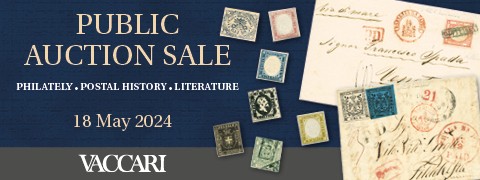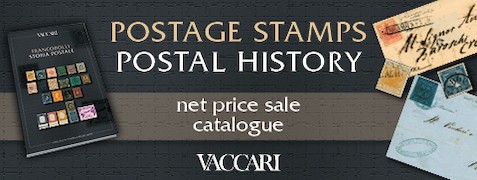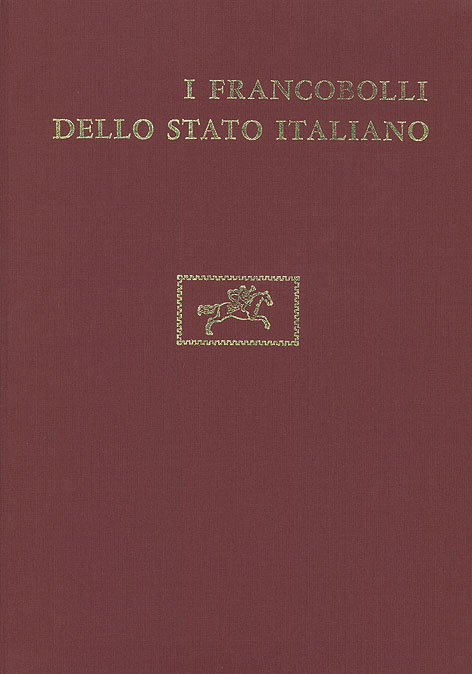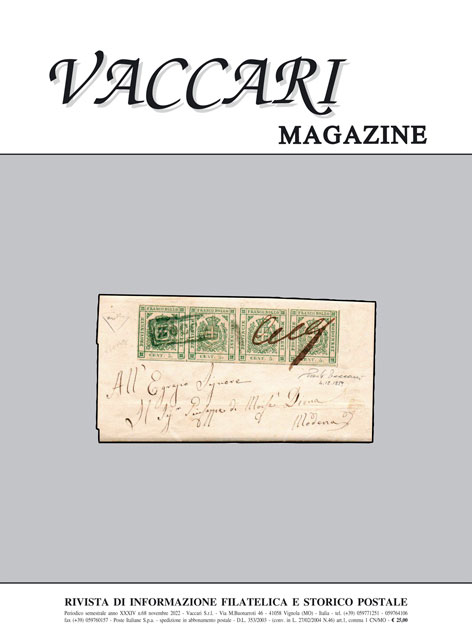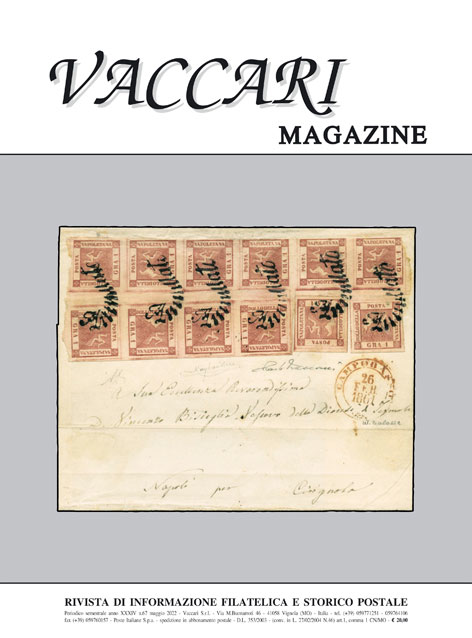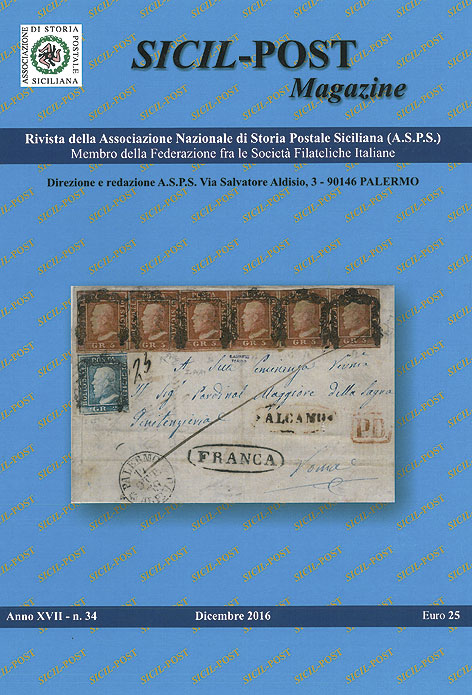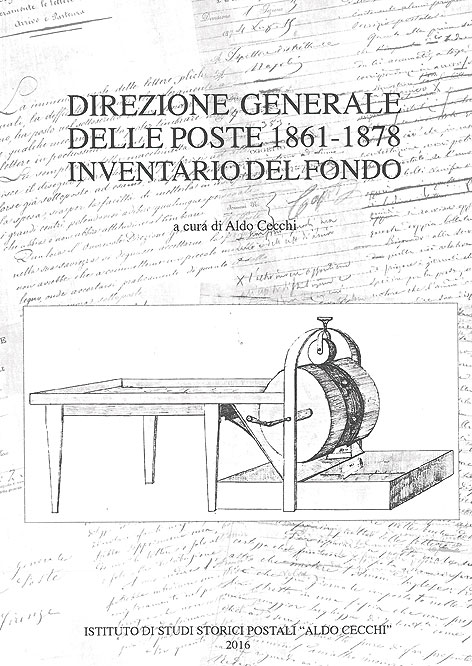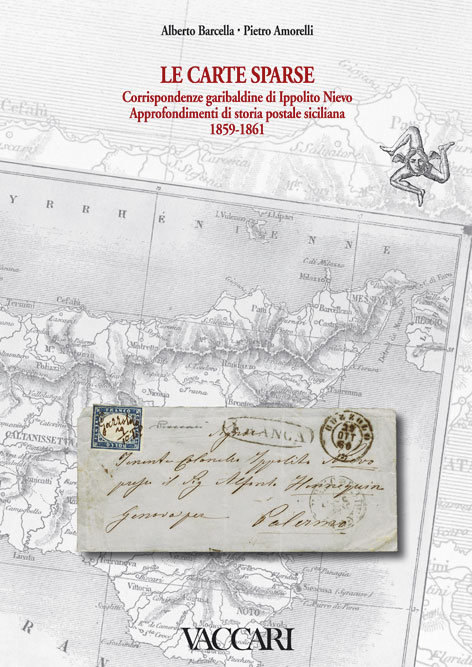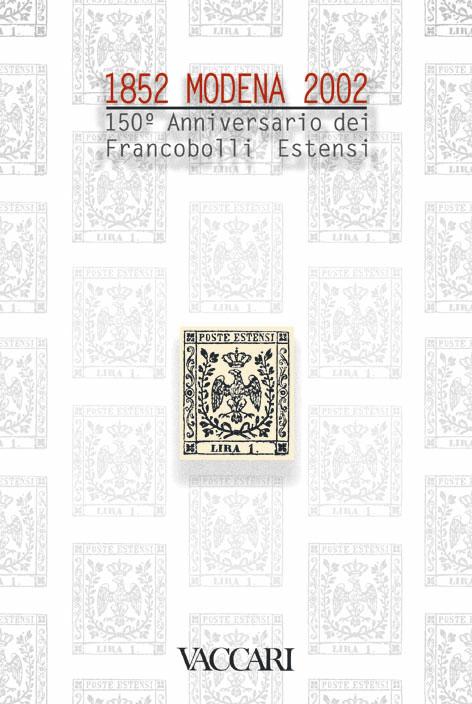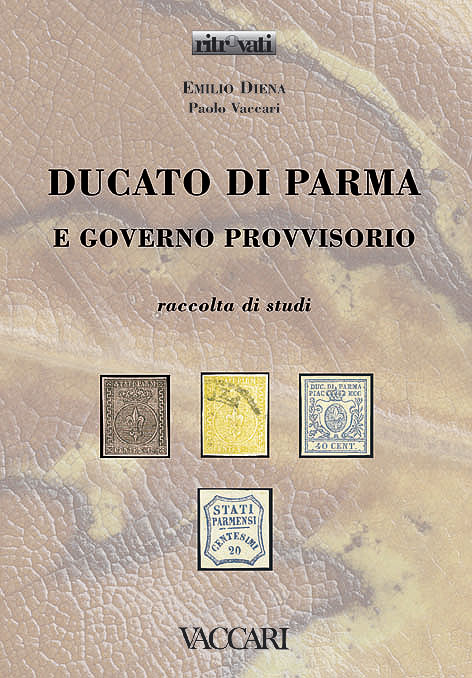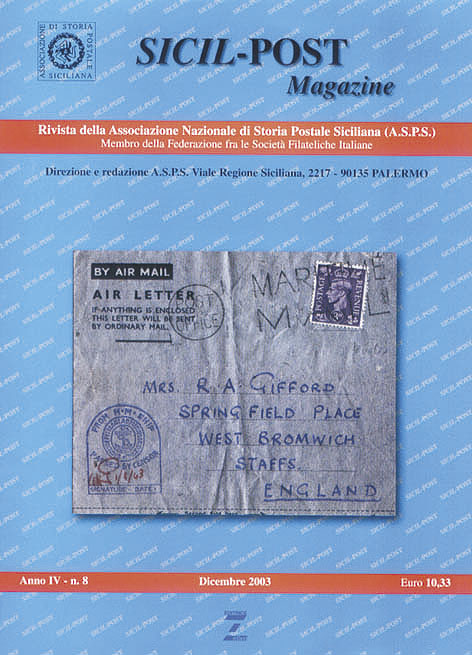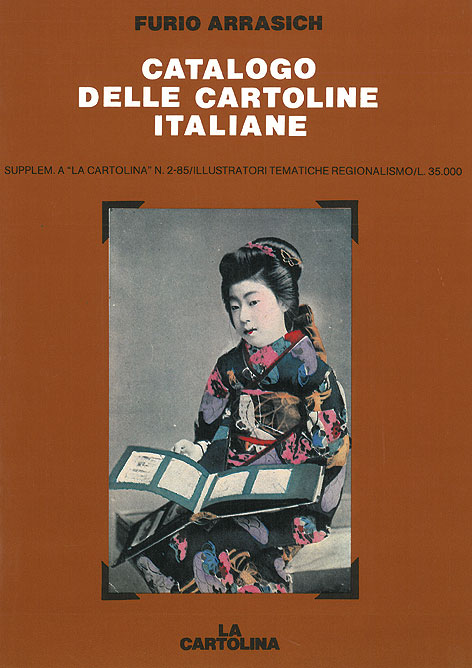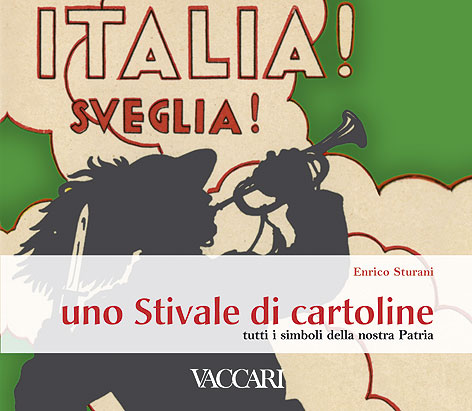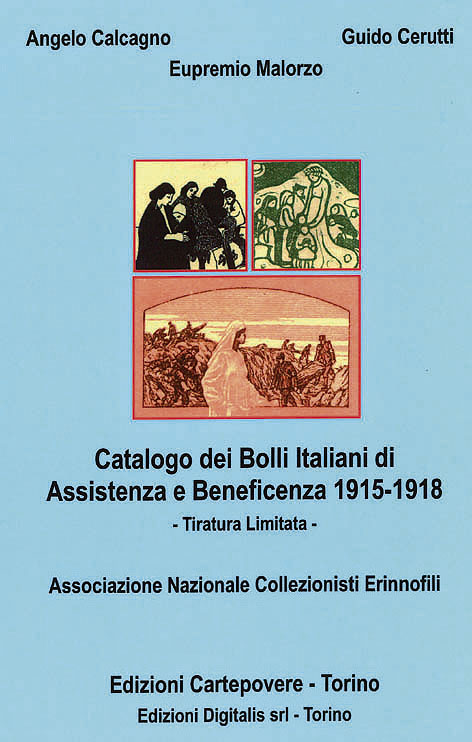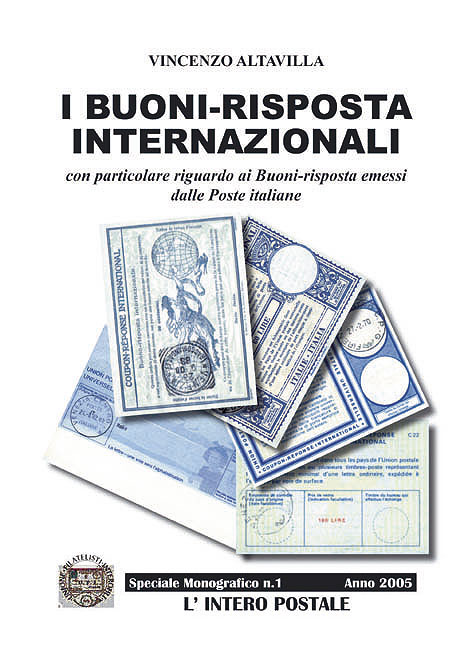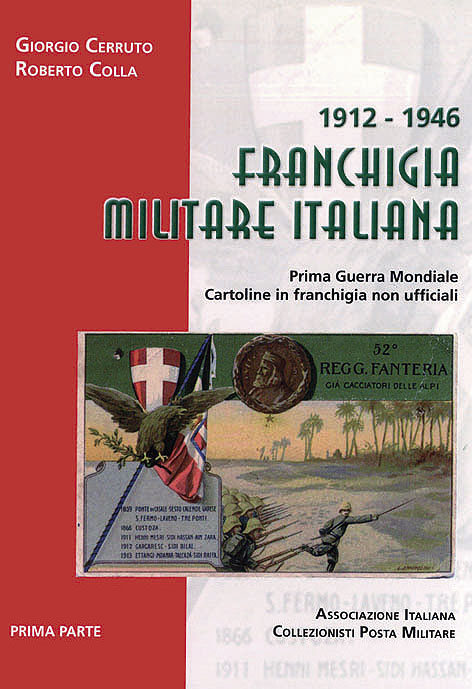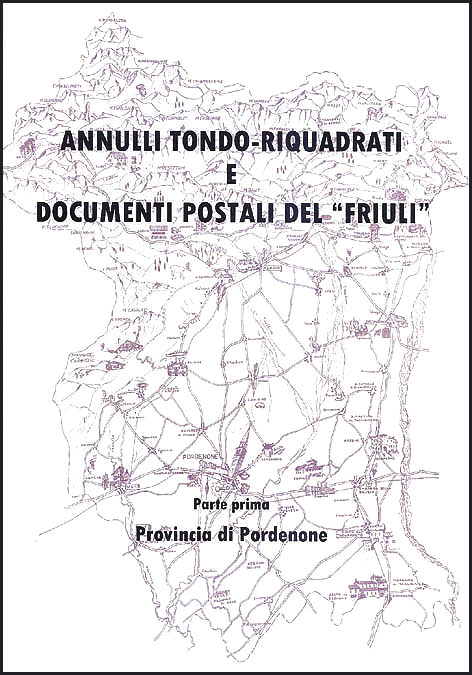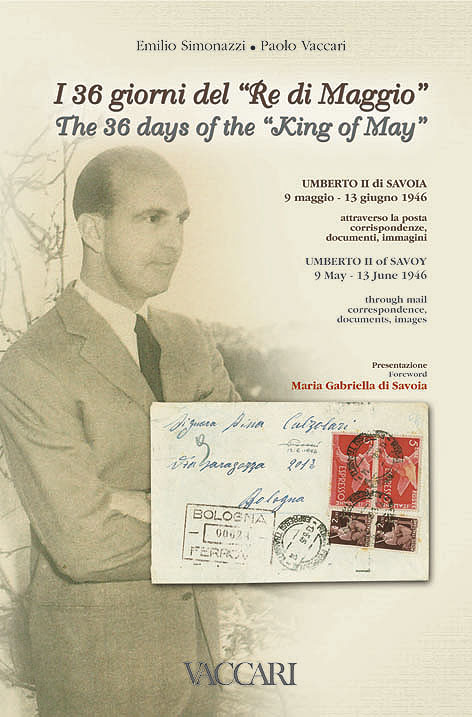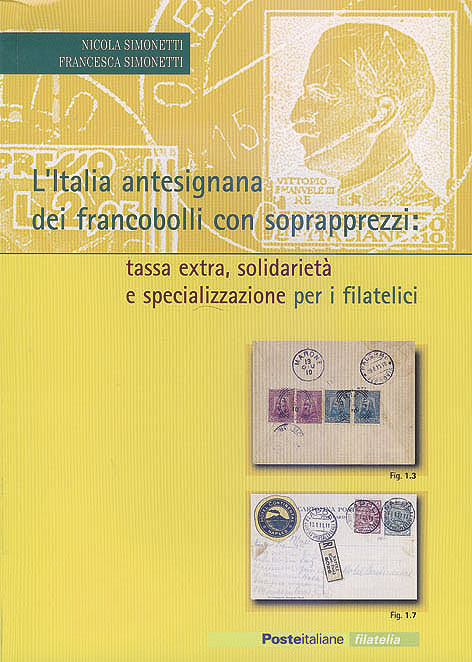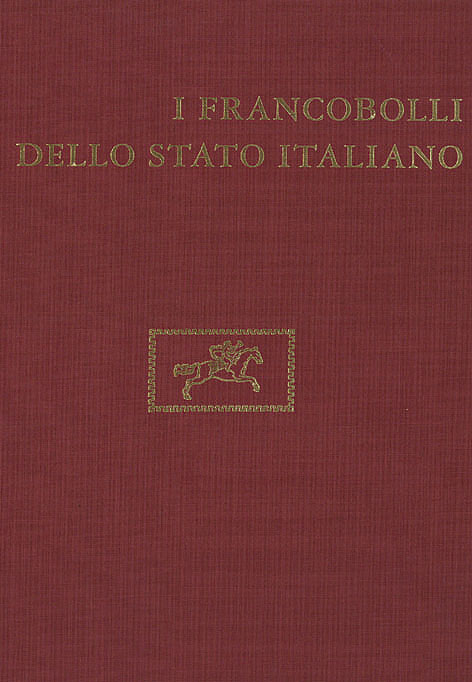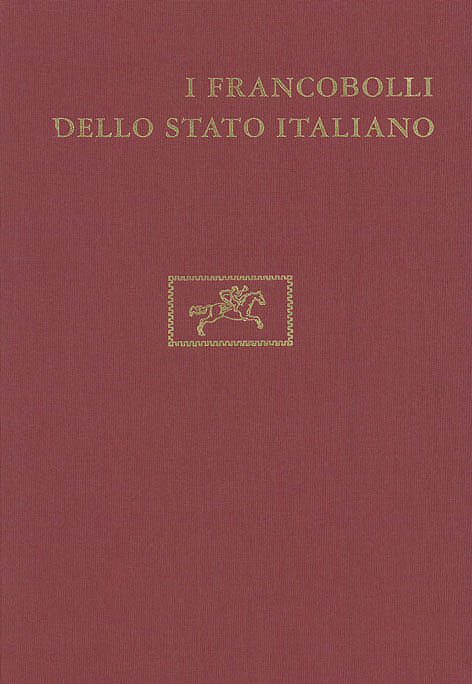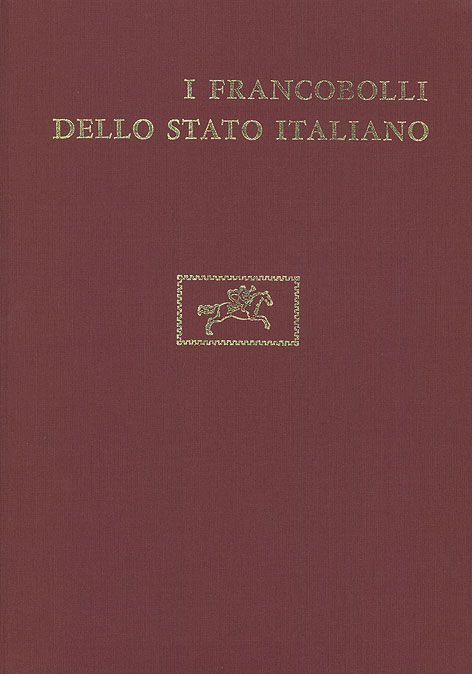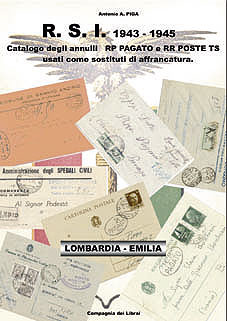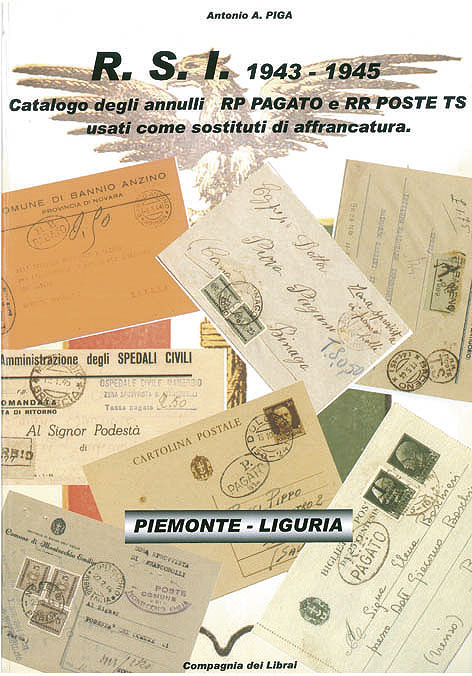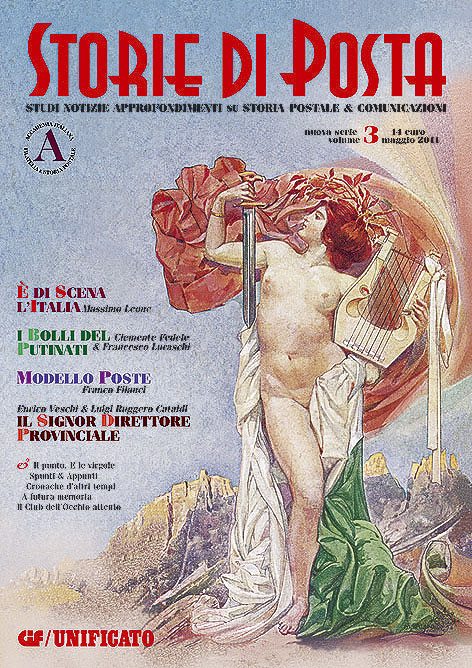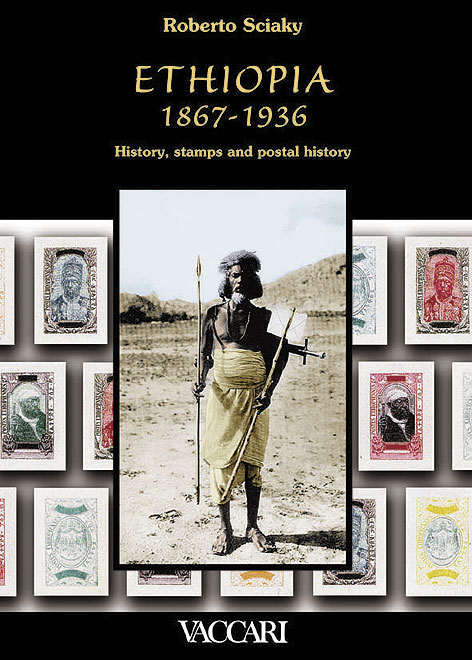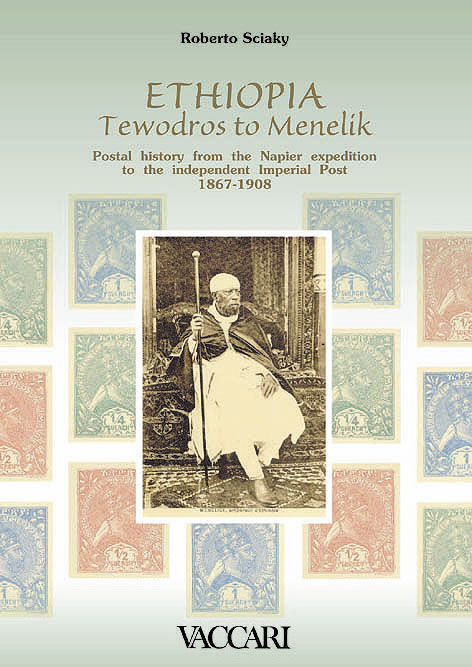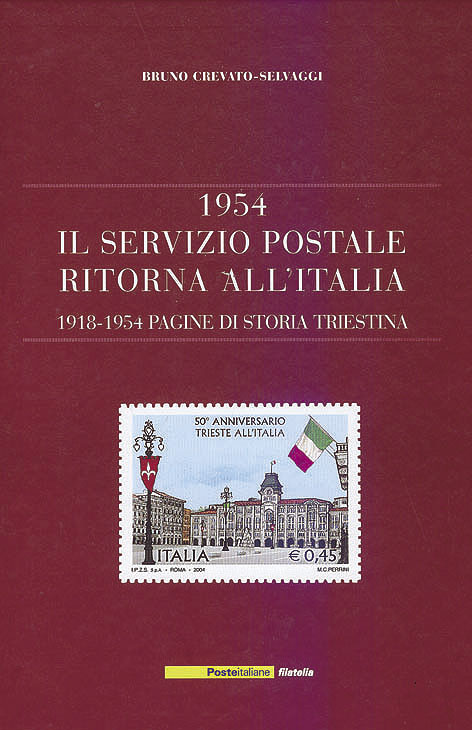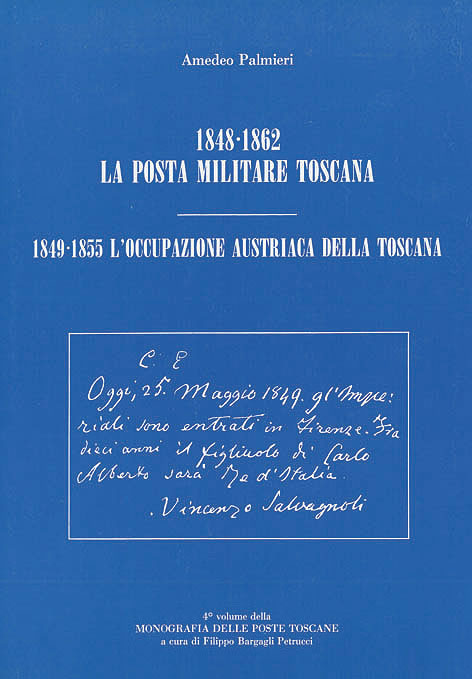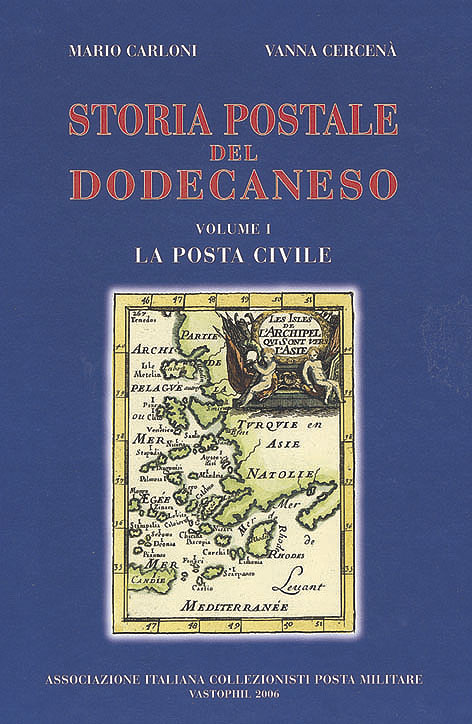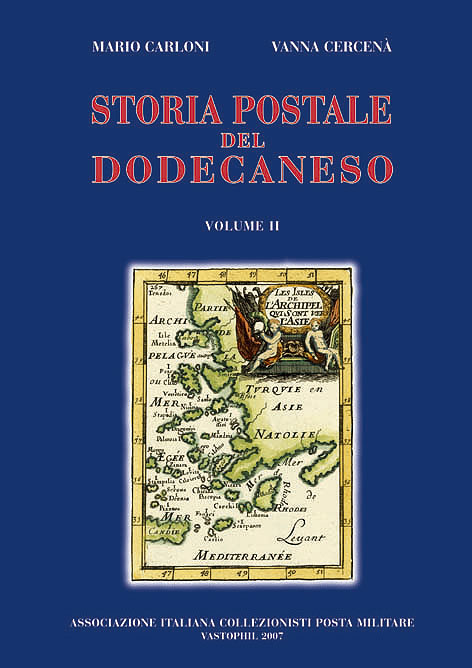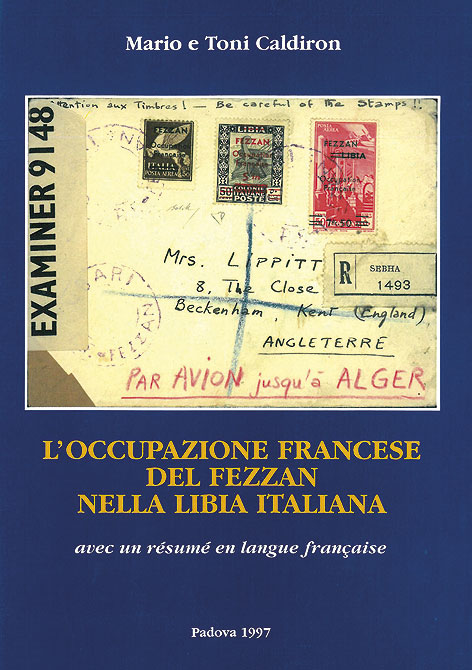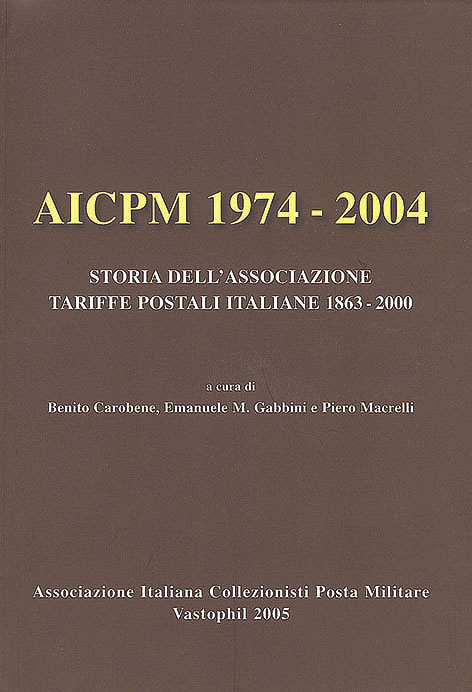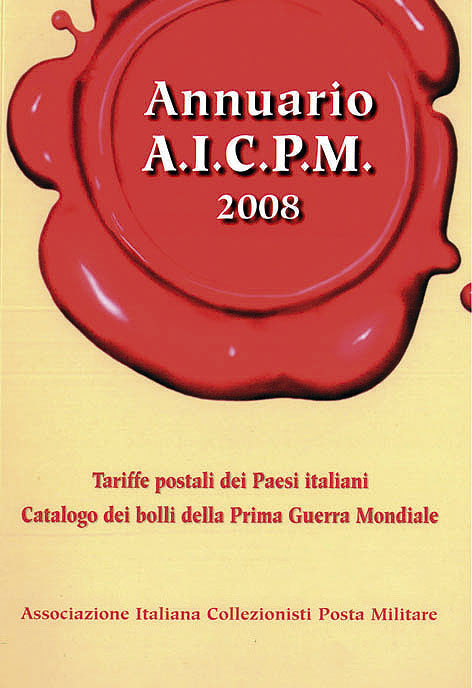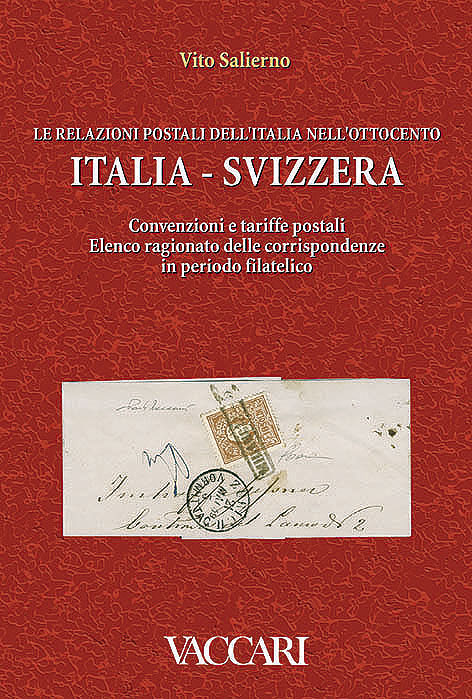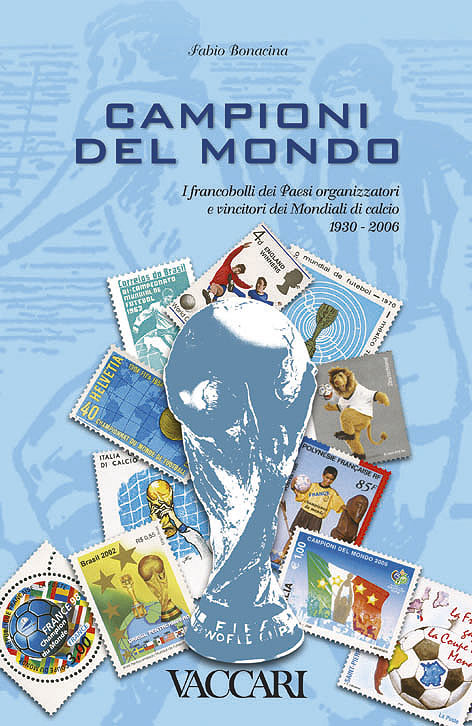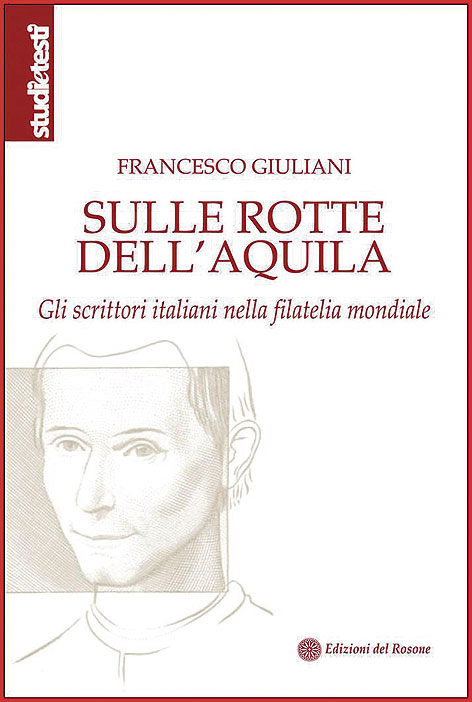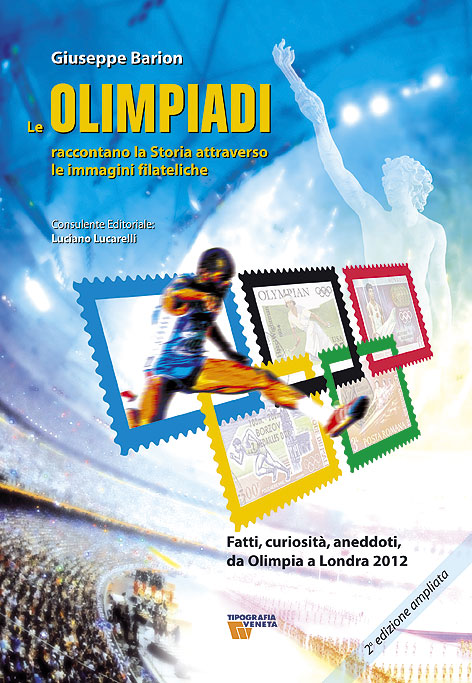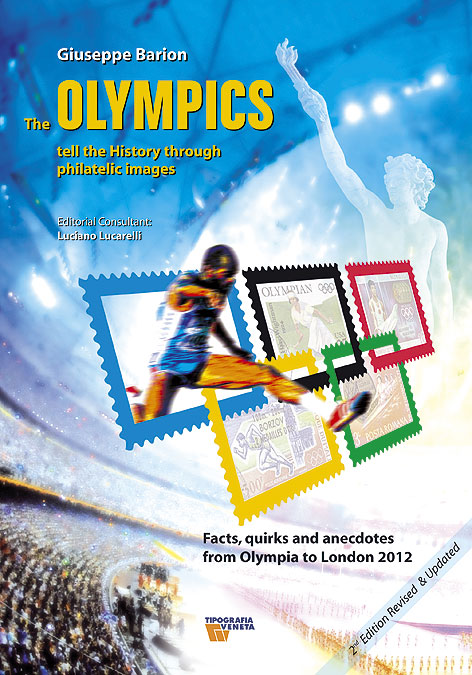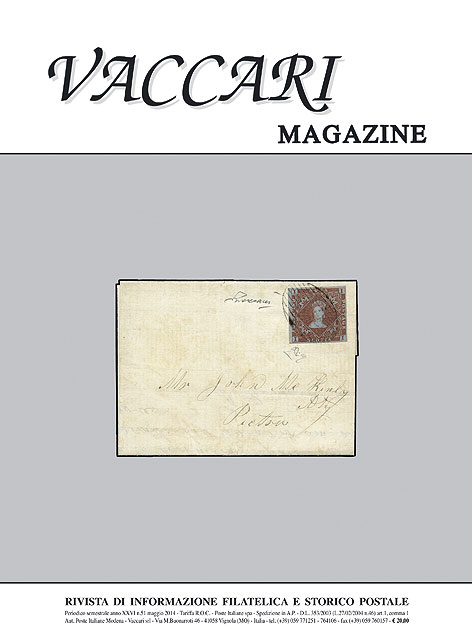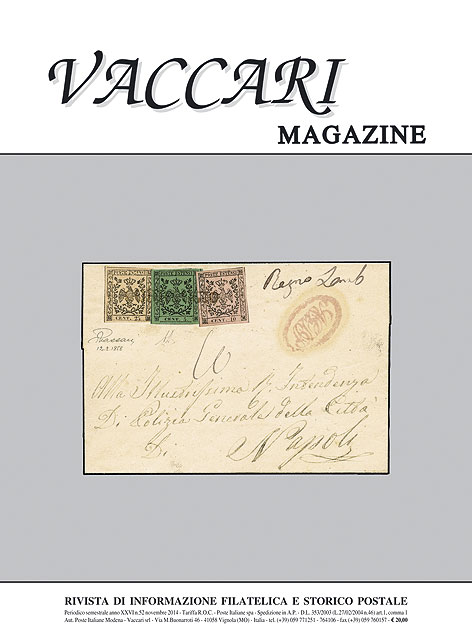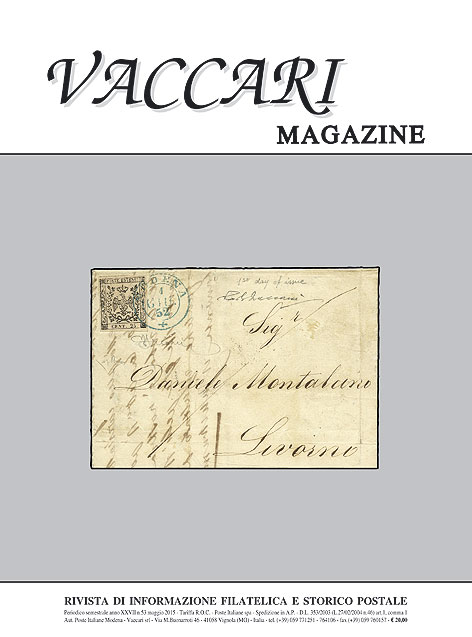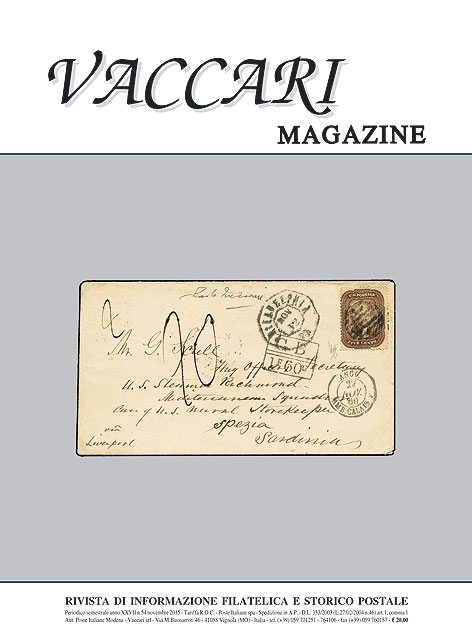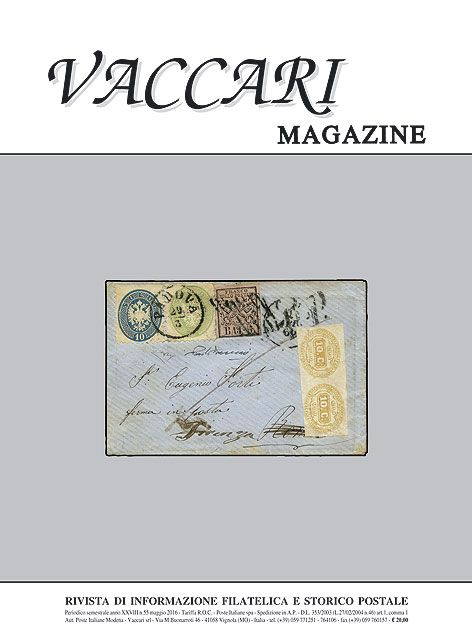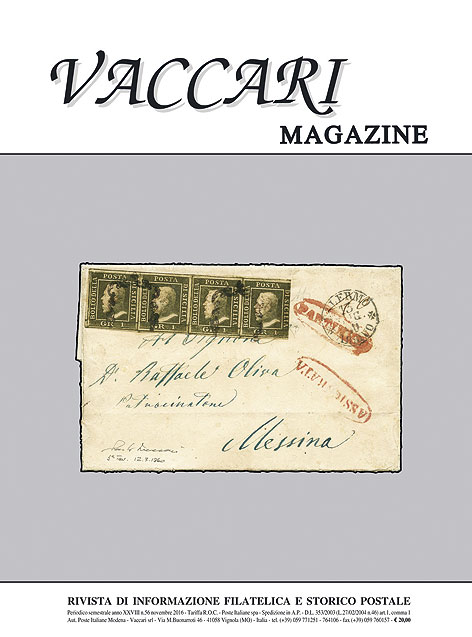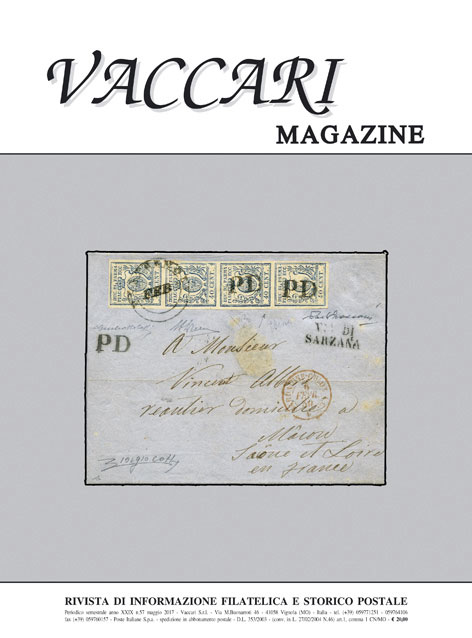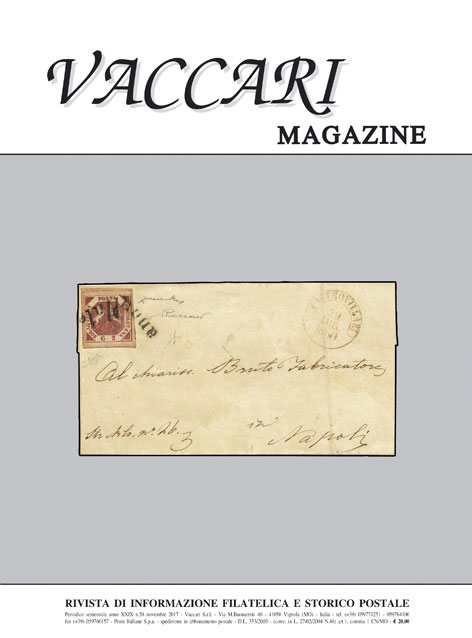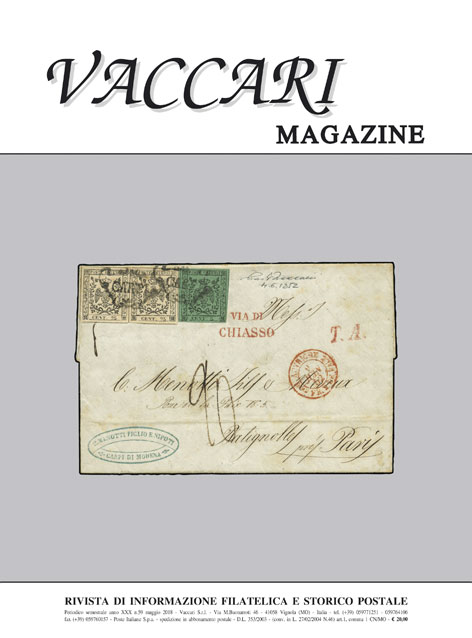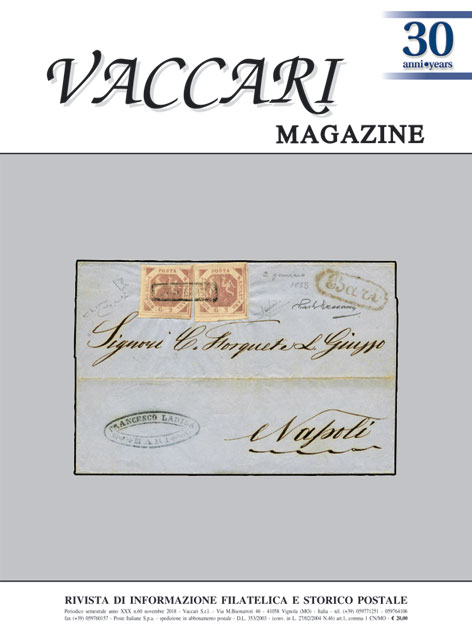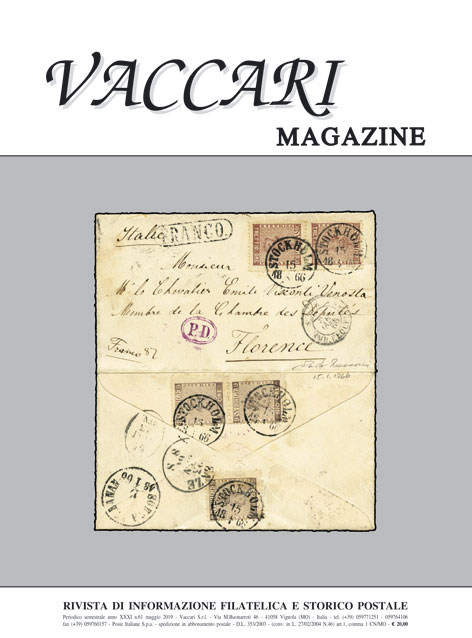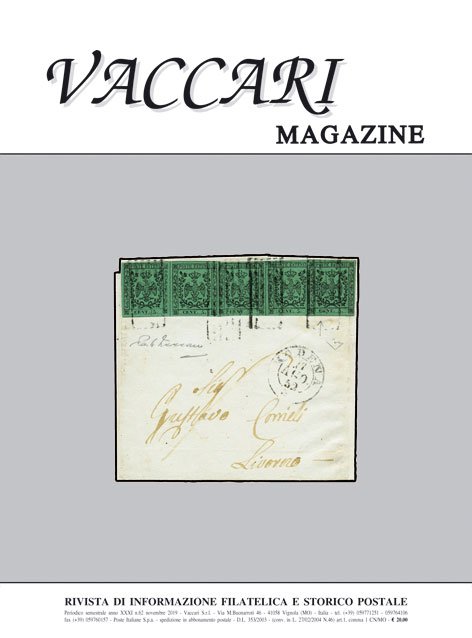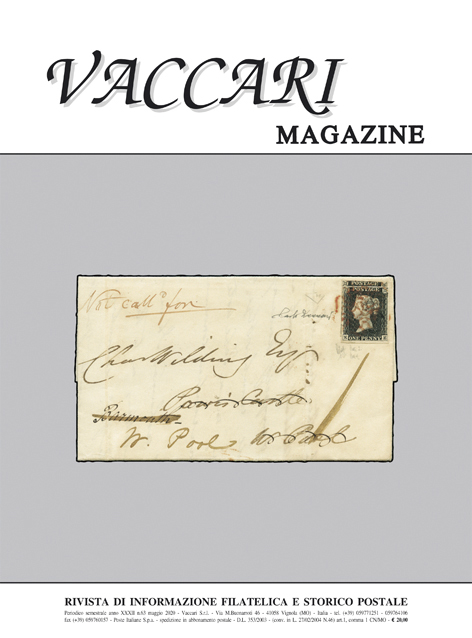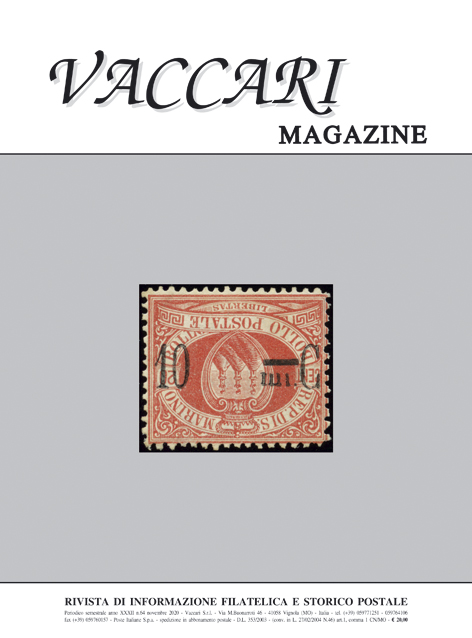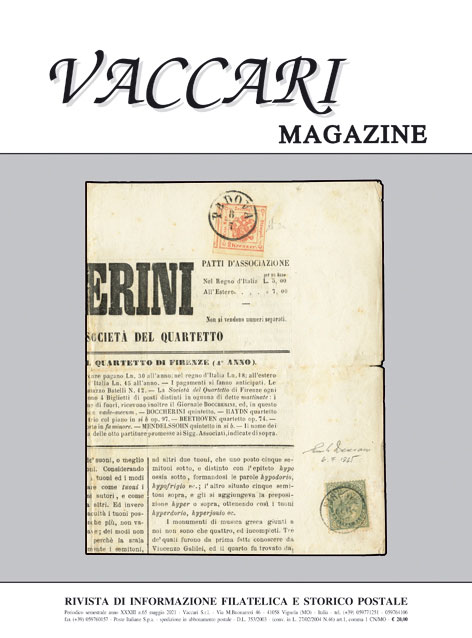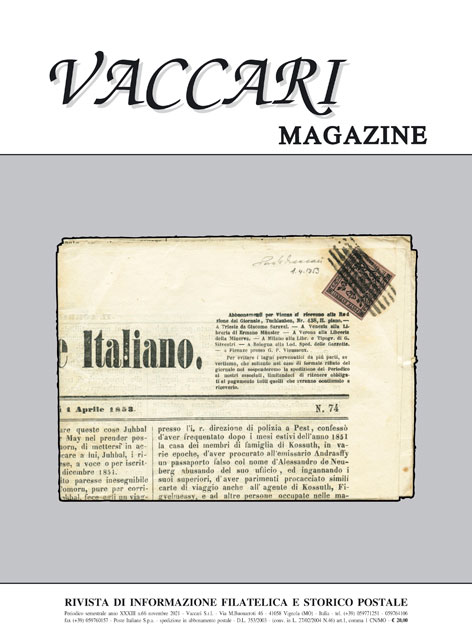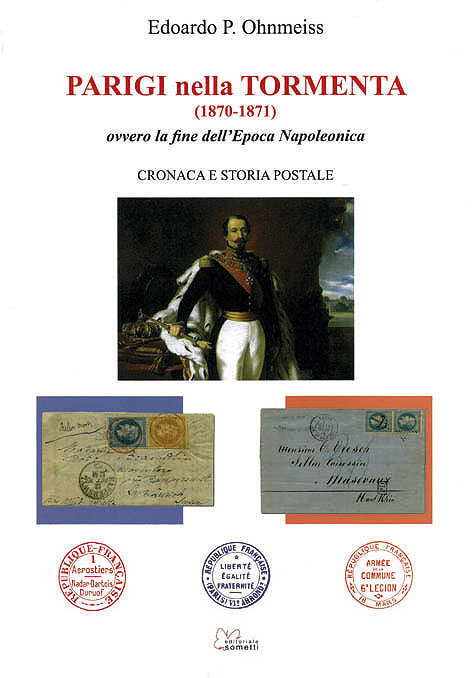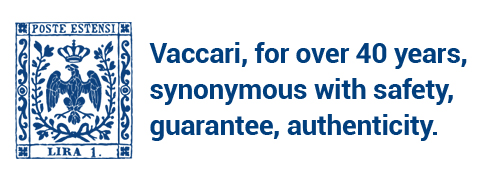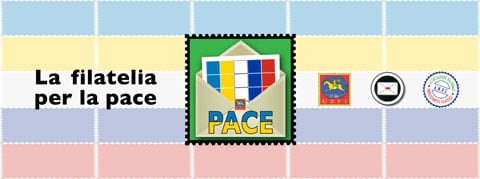Gift books

ONLY WITH BOOK ORDERS
the more you buy the more you get
You can combine gift books as you like:
- 1 book from class B = 2 books from class A
- 1 book from class C = 4 from class A
or 2 from class B
or 1 from class B + 2 from class A
For orders over EUR 150 there is only 1 gift book from class C or a corresponding combination from class A and B.
Gift books are not valid:
- with purchases from the 1 by 1 sale
- for resellers
class A: with orders from EUR 30 to EUR 59.99
DELLO STATO ITALIANO
vol.VI - quinto aggiornamento 1991-1993
X+146 pp. - colour ill. - claret cloth-bound with gold inscriptions - large format - printed 1998 - Poste Italiane, Istituto Poligrafico e Zecca dello Stato, Officina Carte Valori, Roma
Italian, French and English text
ALSO AS FREE BOOK (class B)
The present volume, with its impressive historical research and its elegant graphics, is the fifth update of the series about the Italian state postage stamps which covers the period 1862-2006.
This one includes a cataloguing of stamped postal papers issued from 1991 to 1993.
The historical, artistic and bibliographical profiles for each issue, the subject indexes and the collection of legislative measures form an added value for this work.
OMAGGIO CLASSE B
PACKAGE DEALS ON BACK ISSUES
- 6 TO 10 ISSUES 20% OFF
- MORE THAN 10 ISSUES 30% OFF
anno 2022 - n.68
144 pp. - colour ill. - format cm 20x27 - high quality glossy paper - softbound
special issue
ALSO AS FREE BOOK (class B)
A MAGAZINE TO COLLECT
"Vaccari magazine", the six-monthly specialised in philately and postal history, was born in 1989. Since then, it has been publishing articles and columns about traditional philately, but also some "topical" themes, thanks to the cooperation of lovers, scholars and journalists, experts of the subject.
It is characterized by the high quality of the deep studies proposed and by a very good graphical layout thanks to which it is one of the best awarded magazines in the world.
Last issue, no.68, a special one with 144 pages, was published in November 2022.
- research and innovation at the service of collectors, scholars and lovers
- deep studies presented in a simple and clear way
- several exemplifying images
- precious graphical layout
- important international awards
- incredible results of back issues at the auctions
- free full index
CONTENTS
Vaccari Magazine n.68 - 2022
Editoriale
Vaccari Valeria, Dedicato a papà
Vaccari Paolo, Primi giorni
Vaccari Paolo, Francobolli dell'800 e del '900
Bonacina Fabio, Ci sono cassette e cassette
Pigini, Rosalba, Il ritorno di FilateliCa
Carra Lorenzo, I rapporti postali del Regno Lombardo Veneto con il Regno di Sardegna, poi d'Italia 1815-1866
Bernstein Benjamin, Ferroni Massimiliano, Serone Mario, Rassegna dei colori più interessanti della prima emissione del Lombardo Veneto
Luraschi Francesco, Savini Luca, L'annullo circolare di Milano con data e ore. Quando un timbro diventa un affare di Stato
De Biasi Marco, Annulli bellunesi a doppio cerchio con i baffi
Stumvoll Heinrich, Il più piccolo di Venezia. L'uso del bollo stampatello diritto nero e rosso
Buffagni Giuseppe, Studio degli annullamenti degli uffici degli Stati Estensi
Dallara Enrico, Le regole sanitarie della posta di Parma. La disinfezione delle lettere provenienti dal Genovesato e dall'Alta Lunigiana
Moritsch Massimo, Quondamatteo Roberto, Lettere con affrancatura insufficiente dallo Stato Pontificio al Regno d'Italia. 1° ottobre 1867 - 31 ottobre 1870
Alessio Stefano, Cose di Sardegna
Bottacchi Giacomo, Arona: separati da 169 anni si riuniscono (se son rose... fioriranno!)
Simonazzi Emilio, Riscoperte
Moritsch Massimo, Trattamento delle lettere toscane per Alessandria d'Egitto dal 1836 al periodo filatelico
Mentaschi Mario, Nembrini Giovanni, Le tariffe degli stampati nel periodo dell'Unione Generale delle Poste (GPU). 1° luglio 1875 - 31 marzo 1879
Forti Gianluigi Maria, Regno di Carlo Alberto e Vittorio Emanuele II. L'evoluzione dei trasporti marittimi e terrestri
Fumu Antonello, Transito per il porto di Alessandria d'Egitto della posta per e dalle Indie Orientali negli anni 1850-1871
Lunati Piergiorgio, Il lineare "Traforo Moncenisio" in uso durante la costruzione di un'opera ciclopica: il tunnel del Frejus
Giovanardi Carlo, Fiume: da un piccolo sostantivo una grande storia
Occhipinti Marco, La corrispondenza dei confinati politici
De Signoribus Giorgio, Uso tardivo dei soprastampati "P.M." (Posta Militare) della prima emissione dell'11 settembre 1942 per corrispondenza civile in Italia
Riccitelli Flavio, Il servizio postale regolare della L.A.T.I. sulla rotta sud-atlantica
EDITORIAL
Vaccari Magazine n.68 - 2022
I never wanted to write and sign this editorial in my dad's place.
A long story, that of the Magazine, which could have continued but, by his will, ends here.
I thank personally and also on behalf of my dad (I know he would have done so) all of our writers, many of whom have collaborated with the magazine since the first issue in 1989; all the subscribers and readers who have been following and supporting us.
I thank those who believed in this forward-looking project and published their own advertisements.
I thank all the editorial staff, Francesca who started and Claudia who continued, the makers-up Katia and then Federica. And the typography that accompanied us from the beginning.
A great adventure dad, which I will miss a lot, especially because that was with you.
In this issue some pages are dedicated to him.
Many of the authors had already sent the material for next issue, because the full article would have been divided into several parts. I therefore thought it was right to create a special issue, last one, with more pages than those which characterize the other 67 magazines, to be able to accommodate everything received so far.
Unfortunately, some of the studies divided into many parts will not find a conclusion.
Giuseppe Buffagni, in this second part on the cancellations of the Este States, presents the offices of Camporgiano, Carpi, Carpineti and Castelnuovo di Garfagnana; Flavio Riccitelli reaches the nineteenth part with the regular postal service of the L.A.T.I. on the South Atlantic route developing Paraguay.
Lorenzo Carra, instead, comes to a point with the year 1866 and the end of the Lombardy Venetia Kingdom, in his analysis of relations with the Kingdom of Sardinia from 1815. Last part also for Giorgio De Signoribus, on the late use of the overprinted "P.M." of the first issue (11.9.1942) for civil correspondence in Italy, and for Marco Occhipinti who, with the correspondence of political internees, takes us to Belvedere Marittimo and Cerchiara di Calabria.
Among the new authors there are two long-standing collaborators who, however, are now signing their own contribution: Giacomo Bottacchi joins again, albeit ideally, an original strip of four of Sardinia cent.5 (issue 1.10.1853) after more than a century and a half; Mario Serone, together with Benjamin Bernstein and Massimiliano Ferroni, proposes a review of the most interesting colours of the first issue of Lombardy Venetia.
New are also Enrico Dallara, who analyses the signs of disinfection on letters from Genoa area and Alta Lunigiana according to the health rules of Parma post; Piergiorgio Lunati, who follows the construction of the Frejus tunnel and the contemporary use of the line mark "Tunnel Moncenisio"; Francesco Luraschi, who, with Luca Savini, tells us about when a postmark, the Milan circle with date and hour, becomes a state affair.
Rosalba Pigini offers us a brief report on "FilateliCa 2022". Fabio Bonacina retraces the evolution of mailboxes showing some curiosities. Carlo Giovanardi investigates between Fiume and Lucca starting from a small noun.
Emilio Simonazzi rediscovers a letter from the Kingdom of the Two Sicilies to the Duchy of Modena of which not only traces had been lost but few had been aware of it. Stefano Alessio proposes a funny, colourful and engaging, partly unusual, collection of Sardinia.
Marco De Biasi illustrates Belluno double circle cancellations with moustache; Heinrich Stumvoll the smallest postmark in Venice, the Roman capitals one in black and red.
Antonello Fumu passes through the port of Alexandria in Egypt departing for and arriving from the East Indies (1850-1871). Massimo Moritsch examines the treatment of Tuscan letters addressed to Alexandria in Egypt (1836-philatelic period), and, with Roberto Quondamatteo, letters with insufficient franking from the Papal State to the Kingdom of Italy (1.10.1867-31.10.1870).
Mario Mentaschi and Giovanni Nembrini study the rates for printed matter during the period of the Post General Union (1.7.1875-31.3.1879), and Gianluigi Maria Forti sea and land transports during the reigns of Carlo Alberto and Vittorio Emanuele II.
Signed by Paolo Vaccari, the opening column dedicated to the somewhat particular "items" of the Nineteenth and early Twentieth centuries, and two "first day" letters relevant to the Kingdom of Naples and the Naples Provinces.
Valeria Vaccari
November 2022
OMAGGIO CLASSE B
PACKAGE DEALS ON BACK ISSUES
- 6 TO 10 ISSUES 20% OFF
- MORE THAN 10 ISSUES 30% OFF
anno 2022 - n.67
112 pp. - colour ill. - format cm 20x27 - high quality glossy paper - softbound
ALSO AS FREE BOOK (class B)
A MAGAZINE TO COLLECT
"Vaccari magazine", the six-monthly specialised in philately and postal history, was born in 1989. Since then, it has been publishing articles and columns about traditional philately, but also some "topical" themes, thanks to the cooperation of lovers, scholars and journalists, experts of the subject.
It is characterized by the high quality of the deep studies proposed and by a very good graphical layout thanks to which it is one of the best awarded magazines in the world.
Last issue, no.68, a special one with 144 pages, was published in November 2022.
- research and innovation at the service of collectors, scholars and lovers
- deep studies presented in a simple and clear way
- several exemplifying images
- precious graphical layout
- important international awards
- incredible results of back issues at the auctions
- free full index
CONTENTS
Vaccari Magazine n.67 - 2022
Editoriale
Vaccari Paolo, Francobolli dell'800 e del '900
Bonacina Fabio, È guerra!
"Pubblico & privato alleati per la tutela del patrimonio storico postale"
Simonazzi Emilio, I grandi collezionisti del passato
Carra Lorenzo, I rapporti postali del Regno Lombardo Veneto con il Regno di Sardegna, poi d'Italia 1815-1866
Stumvoll Heinrich, Francobolli in kreuzer usati a Venezia 1850-1866. Esperienze collezionistiche
Buffagni Giuseppe, Studio degli annullamenti degli uffici degli Stati Estensi
Moritsch Massimo, Quondamatteo Roberto, Teruzzi Angelo, Dallo Stato Pontificio al Regno di Sardegna 1852-1867. Franchigia postale e transito toscano
Mentaschi Mario, Sempre sulla progressione delle tariffe in Sicilia dal 1° gennaio 1859
Lombardo Francesco, Sicilia 1859-1860. Singolarità e regolarità delle affrancature dei giornali mancanti dei francobolli, con impronta parziale o intera del ferro di cavallo impresso su francobollo
Nembrini Giovanni, L'introduzione delle tariffe sarde nei rapporti postali tra la Toscana e la Francia
Morani Vittorio, "Tuscany" - Le relazioni postali della Toscana con la costa dell'Atlantico del Sud America. 1851-1879
Forti Gianluigi Maria, Regno di Vittorio Emanuele II. I francobolli testimoni dell'Unità d'Italia
Alessio Stefano, Cose dell'altro mondo
Giovanardi Carlo, Fiume: una miniera di scoperte
De Signoribus Giorgio, Uso tardivo dei soprastampati "P.M." (Posta Militare) della prima emissione dell'11 settembre 1942 per corrispondenza civile in Italia
Occhipinti Marco, La corrispondenza dei confinati politici
Peroni Adalberto, Peroni Gabriele, Sulla tratta tra Genova e Livorno con il vapore "Nuovo Colombo". Alcune note sul "Corso particolare"
Fumu Antonello, 1880 - Da Tunisi ad Alessandria d'Egitto. Storia di due lettere con percorsi differenti
Riccitelli Flavio, Il servizio postale regolare della L.A.T.I. sulla rotta sud-atlantica
EDITORIAL
Vaccari Magazine n.67 - 2022
A return to "Veronafil", after more than two years of isolation which prevented the event from taking place: it has always been a tradition that this six-monthly magazine, now at issue 67, was released in May and November precisely on the occasion of the Scaligera meeting.
And tradition has it that it opens with the column edited by me focused on some particularly interesting examples of the Nineteenth and early Twentieth centuries, therefore above all Ancient Italian states but also the Kingdom of Italy.
The magazine is specialized in traditional philately and postal history, but there are always articles focused on curiosities or current events, and Fabio Bonacina tells us about what has been happening for some months now in Ukraine, making a brief historical excursus thanks to the reading of postage stamps, thus addressing the subject from a philatelic point of view. Still in the present, a thorny issue for many collectors: the events related to the seizure of assets in the context of the protection of historical postal items; the conference held in Rome in January is intended to be a basis for effective collaboration between the public and private sectors to establish clear rules.
A valid link between present and past is the presentation, by Emilio Simonazzi, of the great collectors of the past, whose teachings still influence us today.
Some articles in several parts continue deepening different aspects or places: Lorenzo Carra, the "N.A." postmarks, the frontier zones, printed matters, newspapers ..., in the relations between Lombardy Venetia Kingdom and Kingdom of Sardinia, with the Sardinian-Austrian postal agreement restored from 15 May 1862; Marco Occhipinti, with the correspondence of political internees, after having toured the islands, some places on the mainland that were not so different from an island due to their characteristics; Flavio Riccitelli, with the regular postal service of the L.A.T.I. on the South Atlantic route, this time Bolivia.
Others begin to propose their studies: Giuseppe Buffagni, on the cancellation of the Este States, starting with the offices, in alphabetical order, of Aulla, Avenza, Brescello, Calice al Cornoviglio; Giorgio De Signoribus, on the late use of the overprinted "P.M." of the first issue (11.9.1942) for civil correspondence in Italy.
Heinrich Stumvoll follows the Kreuzer postage stamps used in Venice from 1850 to 1866 through his collecting experiences. Massimo Moritsch, Roberto Quondamatteo and Angelo Teruzzi go from the Papal State to the Kingdom of Sardinia from 1852 to 1867 with post-free mail and Tuscan transit.
Mario Mentaschi develops another problem concerning letter rates in Sicily from 1 January 1859: how were letters of more than two sheets weighing less than 1 ounce franked? Francesco Lombardo, also in Sicily in the years 1859-1860, analyzes the franking of the newspapers missing the postage stamps, with the impression, sometimes partial, of the horse-shoe.
Giovanni Nembrini traces the development of postal relations between Tuscany and France starting from 1 July 1851; Vittorio Morani proceeds along the routes between Tuscany and the Atlantic coast of South America between 1851 and 1879.
Gianluigi Maria Forti illustrates the postage stamps that witnessed the unification of Italy. Stefano Alessio gives us an example of organizational "efficiency" relating to the handling of a letter sent from Bologna to Reggio Emilia on 13 November 1961.
Carlo Giovanardi examines the 1 crown value of Fiume "allegories and views" issued at the beginning of 1919, with papers, perforation, overprints, ... Adalberto and Gabriele Peroni travel on the "Nuovo Colombo" steamer between Genoa and Leghorn in "Corso particolare"; Antonello Fumu sails from Tunis to Alexandria in Egypt in 1880, on two different routes.
Enjoy the reading!
Paolo Vaccari
May 2022
Anno XVIII - n.35 - giugno 2017
44 pp. - colour ill. - softbound - printed 2017
Italian text
ALSO AS FREE BOOK (class B)
Year XVIII - n.35 - June 2017
Magazine of the Postal History Association of Sicily
CONTENTS
* Editoriale
* Gaetano Gatto, Le affrancature del Officine Postali di Sicilia - 1859-1860
* Giovanni Bonello, Lettere affrancate dagli Stati Italiani preunitari con destinazione Malta
* Cateno Nisi, Sintesi storico-filatelica sul Regno delle Due Sicilie da Carlo V a Ferdinando II
* Vincenzo Fardella de Quernfort, I Congressi della S.I.P.S. a Palermo nel 1875 e nel 1935
* Alberto Stracuzzi, Una missiva del 1917 diretta in Zona di Guerra - Quando il contenuto delle lettere è d'importanza storica
* Giuseppe Catanzaro, Storia postale di Termini Imerese
* E. De Rafall, Breve storia dell'Avviso a ruote "Authion" della Marina Militare Italiana
* L'ultimo saluto a due vecchi amici
* Segnalazioni
* Le Manifestazioni
* Biblioteca sociale
Anno XVII - n.34 - dicembre 2016
56 pp. - colour ill. - softbound - printed 2016
Italian text
ALSO AS FREE BOOK (class B)
Year XVII - n.34 - December 2016
Magazine of the Postal History Association of Sicily
CONTENTS
* Editoriale
* Gaetano Palmigiano, La corrispondenza da e per lo Stato Pontificio con i paesi italiani, europei e del bacino del Mediterraneo dal 1840 al 1874, Seconda parte
* Gaetano Gatto, Le affrancature del Officine Postali di Sicilia - 1859-1860
* Vincenzo Fardella de Quernfort, Una doverosa precisazione su un bollo marittimo in uso nel 1859-1860 a Palermo
* John Downs, Storia postale o Posta storica
* Vincenzo Fardella de Quernfort, I Di Bartolo: storia di una famiglia di capitani di mare
* Le Manifestazioni
* Biblioteca sociale
1861-1878
INVENTARIO DEL FONDO - Q.33
XL/452 pp. - softbound - printed 2016
italian text
ALSO AS FREE BOOK (class B)
INVENTORY OF THE FUND - N.30
Central Archives of the Italian State, Ministry of Post and Telegraph (1861-1924) - General Affairs of the central administration - Inventory of years 1861-1878
With works by: Gianni Vittorio Armani, Introduction - Eugenio Lo Sardo, Introduction - Aldo G. Ricci, The historical memory of Italy with Post - Aldo Cecchi, Note by the curator - Letizia Anna Mainella, The Administration of the Italian Post and Telegraph - Valentina Stazzi, The rearrangement of the fund General Direction of the Italian Post 1861-1878 - Letizia Anna Mainella, Table of classification of the Administration of the Italian Post and Telegraph 1861 to 1889.
Corrispondenze garibaldine di Ippolito Nievo
Approfondimenti di storia postale siciliana
1859-1861
112 pp. - colour illustrations - format cm 21x29,7 - high quality glossy paper - softbound - printed 2018
series "History through documents"
Italian text
ALSO AS FREE BOOK (class B)
Garibaldine correspondences by and to Ippolito Nievo
Insights into Sicilian postal history
1859-1861
The Sicily of 1859-1861 told through postal history and Ippolito Nievo letters. Some insights into an extraordinary period, with gattopardesche atmospheres, which preceded the Unity of Italy on the island, analysing the effects of revolution on the postal system and the correspondence of a brilliant and idealist young man who spent last months of his life in Sicily following Garibaldi's troops.
From the preface by Giulio Perricone, President of the Sicilian Philatelic Union
"The two collectors authors of this work [...] if on the one hand have added a piece to the history of the patriot who was wrecked on the journey between Palermo and Naples in 1861 [...] on the other have enriched, with a learned publication, the great chapter of Italian postal history, of Sicily, of the Garibaldian period, of the emergency mail systems connected to an insurrectional situation."
From the introduction by Francesca Tamburlini, Head of the Manuscripts and Rare Items Section of "Vincenzo Joppi" Civic Library of Udine
"The text [...] turns the attention on some almost unexplored aspects of these writings, that is on the "conventional" elements and marks found on the envelopes [...] without neglecting the texts of the letters that are resumed and cited to make the meaning of those external signs better understood. [...] The essay of the two authors comes to the rescue and opens up a new world, guiding us from the place of departure of the letter to its final destination [offering] of these Ippolito's documents an additional reading."
CONTENTS
PREFACE
Giulio Perricone
A FURTHER VALUE
Last letters by (and to) Ippolito Nievo, unwitting testimony for postal history
Francesca Tamburlini
SICILIAN INSURRECTIONAL COMMITTEES
The postal system in May 1860
Alberto Barcella
SCATTERED PAPERS
Ippolito Nievo correspondence from 5 May 1860 until his death
Alberto Barcella - Pietro Amorelli
THE POST AND SICILIAN REVOLUTION OF 1860
With some notes on the political use of postal iconography
Pietro Amorelli
BIBLIOGRAPHY
Cinisello Balsamo 11-13 ottobre 2019
LARGE VERMEIL - ITALIA 2018
23 novembre 2018
LARGE SILVER - NOTOS 2021
19-22 novembre 2021
REGOLAMENTO POSTALE E TARIFFE
per tutte le destinazioni
108 pp. - format cm 17x24 - softbound - 2nd ed. 2002 - reprinted 2005
series "The Recoveries"
Italian text
ALSO AS FREE BOOK (class B)
978-88-85335-51-6
Second edition of the reprint from the original text «Utile Giornale di Milano» of 1857 with all postal rates. Easy to consult. Foreword by Lorenzo Carra.
OMAGGIO CLASSE B
SPECIAL PRICE TO PROMOTE PHILATELY
cover price euro 35,00
150° ANNIVERSARIO DEI FRANCOBOLLI ESTENSI
Catalogo ufficiale della mostra
400 pp. - more than 1000 colour ill. - format cm 21x29,7 - hardbound - fine art quality paper - printed 2002
series "History through documents"
Italian text
ALSO AS FREE BOOK (class B)
978-88-85335-49-3
150th ANNIVERSARY OF ESTE POSTAGE STAMPS
COMMEMORATIVE EXHIBITION
Postage stamps and covers
the most important rarities of the Duchy of Modena
OFFICIAL CATALOGUE
The present catalogue illustrates fully in colour more than 1000 items exhibited, following the order of the guided route. At the beginning, the volume has been enriched with some introductory essays, and at the end with an exhaustive bibliography.
The exhibition, organized on the occasion of the 150th anniversary of the Este postage stamps, was anthological and at the same time educational as it showed, with postage stamps, mail and documents, what had been possible to find in private collections.
The volume starts showing how mail was sent before the introduction of postage stamps in the postal system of the Duchy, going on with essays, printers proofs of the types adopted and the franking on mail addressed to the Italian territory and abroad.
On show, also all the impressions and the cancellations used in the 32 postal offices which operated in the Duchy territory; among them some are extremely rare, besides the only known from the postal office in Zocca.
A wide part was devoted to the Risorgimento period (1859 - II War for Independence), showing all the historical and postal-historical events which had taken place in the territory.
A unique presentation was devoted to mail which reached destination in a very short time, quite impossible today even using the present technology such as trains, planes and motorways. In spite of the use of horses, before the slow post experimental trains, thanks to postal agreements between the different states, they could deliver letters sent early in the morning from Modena by the same day in Milan, Florence or Venice, by two days in Turin and by three days in Rome!
CONTENTS
* Introduction
* Francesco V Duchy of Modena, by Lidia Righi Guerzoni
* The economical situation of the Duchy during the Austria-Este Government, by Elisabetta Barbolini Ferrari
* The Austrian influence and the realization of Este postage stamps, by Lorenzo Carra
* The "maritime" localities in the Duchy, by Paolo Vaccari
* Emilio Diena. He was born in the shade of the Ghirlandina, by Paolo Vaccari
* The discovery of ancient Italian postage stamps in Vito Viti correspondence, by Emilio Diena and adaptation by Paolo Vaccari
* History in a paper rectangle, by Emilio Simonazzi
THE EXHIBITION
* Pre-philately period
* Essays and printers proofs
* Este postage stamps: Types; First days of use; Correspondence
* Risorgimento period: Sardinian occupation of Modena Transappennine; Retirement from the Duchy, Regency and Municipal Government; Este postage stamps in the Provisional Government period; Postage stamps of the Kingdom of Sardinia in the Transappennine
* Provisional Government issues: Types; first day of issue
* Correspondence
* Newspapers and Gazettes
* Cancellations of postal offices: provinces of Modena, Reggio Emilia, Frignano, Guastalla, Garfagnana and Lunigiana
* Typographical composition errors; Printing varieties
* Mail from abroad
* Annexation to the Kingdom of Sardinia
Bibliography
Paolo Vaccari received the Philatelic Oscar from the Italian Academy of Philately and Postal History for the numerous studies he has published.
For the volume "Sicilia 1859 - Comparative plates of stamps" he received the award of the Italian Philatelic Press Union.
He has received over one hundred awards of recognition worldwide for his written and published works.
He also received the "Regione Toscana" cup and the "Fiorino d'Oro" for displaying specialized collections centred on the Grand Duchy of Tuscany philately of the XIX century.
In 2008 he received the "Ragno d'Oro - UNICEF" award in the trade category, an award granted to people from Modena who have contributed to increasing the prestige of the city of Modena within the country and abroad.
He is a philatelic expert for the C.C.I.A.A. and the Court of Modena.
He has taken part in appraisals and provided expert analyses for Credit Institutions.
He is a member of the national register of journalists, special section, and of the "Unione Stampa Filatelica Italiana" (USFI).
He was a member of the "Club Elite de la Philatélie" of Monte Carlo, presided over by Prince Ranieri, a closed number club in which the 100 most important philatelic experts worldwide may take part, receiving the highest Monacan recognition each time, the Ranieri gold medal.
He is a member of the "Académie Européenne de Philatélie" with headquarters in Paris.
He was a member of the "Consulta per la filatelia del Ministero delle Comunicazioni".
He was named honorary partner of the prestigious "Associazione Italiana di Storia Postale" (A.I.S.P.) with headquarters in Milan, and of the "Accademia Italiana di Filatelia e Storia Postale" in 2009.
He is a member of the "Deputazione di Storia Patria per le Antiche Province Modenesi";
of numerous Italian and foreign philatelic associations;
of the "Accademia dello Scoltenna".
He is a member of the Philatelic Veterans Register since 1985.
Since 1993 he has been a Trade Master with 40 years of experience in the business at the time.
BRONZE POSTHORN - SINDELFINGEN 2006
24th International Stamp Fair
27-29 ottobre 2006
LARGE GOLD + FELICITATIONS - VASTOPHIL 2003 (Vasto)
30-31 maggio 2003
Nazionale italiana
LARGE GOLD - TEMEX 2003 (Buenos Aires)
8-13 dicembre 2003
LARGE GOLD - TICINO 2003 (Locarno)
18-22 giugno 2003
GOLD - ST. PETERSBURG 2007
General World Stamp Exhibition
St. Petersburg, 19-25 giugno 2007
GOLD - WASHINGTON 2006 Washington, DC, USA
World Philatelic Exhibition
27 maggio - 3 giugno 2006
GOLD - C7NPLE 2005
14-16 ottobre 2005
(Toronto, Canada)
GOLD - BRNO CZ 2005 (Brno, Repubblica Ceca)
10-15 maggio 2005
GOLD - GIUBIASCOFIL 2005
29 aprile - 1 maggio 2005
(Giubiasco - Ticino, Svizzera)
GOLD - PACIFIC EXPLORER 2005
21-24 aprile 2005 (Sydney)
GOLD - SINGAPORE 2004 (Singapore)
WORLD STAMP CHAMPIONSHIP
28 agosto - 1 settembre 2004
GOLD - ESPAÑA 2004 (Valencia)
22-30 maggio 2004
GOLD - BANGKOK 2003 (Bangkok)
4-13 ottobre 2003
LARGE VERMEIL - NEW ZEALAND LITERATURE EXHIBITION
25 giugno 2005
(Palmerston North, New Zealand)
VERMEIL - APS STAMPSHOW 2004
Sacramento, California (USA)
12-15 agosto 2004
NOT COMPETING - ALPE ADRIA 2007
1-3 giugno 2007
CAORLE (VE), Italy
E GOVERNO PROVVISORIO
raccolta di studi
104 pp. - colour and b/w ill. - format cm 17x24 - softbound - printed 2007
series "The Recoveries"
Italian text
ALSO AS FREE BOOK (class B)
Collection of studies
The present monograph gathers a group of studies to offer a general, more comprehensive picture of the issues of Parma, starting with the first ones by the master of philately, Emilio Diena, and going on with those published since 1991 as articles in "Vaccari Magazine".
The volume is divided into two parts. In the first one, there is the reprint of the previous edition of 1989: translation from English of the article which was the subject of a lecture presented by Emilio Diena to the Royal Philatelic Society in 1930 on "Scudetto" issue of 1857-1859 of the Duchy of Parma, published in the September issue of the "London Philatelist", official organ of the "Royal"; and reprint from the original published in 1913 on Provisional Government postage stamps. Both studies are completed with the b/w tables illustrating the complete sheets and have preface by Enzo Diena.
In the second one, there are, illustrated in colour, the study presented in 2002 on the occasion of the 150th anniversary of Este postage stamps, which offers a short historical and philatelic introduction about the stamps of the Duchy of Parma and of the Provisional Government, with reference to all the issues and to postal rates; the article about cent.15 rose, first issue; that about cent.5, second issue; the study relevant to cent.40, third issue, with large and small zero; the one about the war of 1859 and the issue of the Provisional Government with reference to cent.80.
Paolo Vaccari received the Philatelic Oscar from the Italian Academy of Philately and Postal History for the numerous studies he has published.
For the volume "Sicilia 1859 - Comparative plates of stamps" he received the award of the Italian Philatelic Press Union.
He has received over one hundred awards of recognition worldwide for his written and published works.
He also received the "Regione Toscana" cup and the "Fiorino d'Oro" for displaying specialized collections centred on the Grand Duchy of Tuscany philately of the XIX century.
In 2008 he received the "Ragno d'Oro - UNICEF" award in the trade category, an award granted to people from Modena who have contributed to increasing the prestige of the city of Modena within the country and abroad.
He is a philatelic expert for the C.C.I.A.A. and the Court of Modena.
He has taken part in appraisals and provided expert analyses for Credit Institutions.
He is a member of the national register of journalists, special section, and of the "Unione Stampa Filatelica Italiana" (USFI).
He was a member of the "Club Elite de la Philatélie" of Monte Carlo, presided over by Prince Ranieri, a closed number club in which the 100 most important philatelic experts worldwide may take part, receiving the highest Monacan recognition each time, the Ranieri gold medal.
He is a member of the "Académie Européenne de Philatélie" with headquarters in Paris.
He was a member of the "Consulta per la filatelia del Ministero delle Comunicazioni".
He was named honorary partner of the prestigious "Associazione Italiana di Storia Postale" (A.I.S.P.) with headquarters in Milan, and of the "Accademia Italiana di Filatelia e Storia Postale" in 2009.
He is a member of the "Deputazione di Storia Patria per le Antiche Province Modenesi";
of numerous Italian and foreign philatelic associations;
of the "Accademia dello Scoltenna".
He is a member of the Philatelic Veterans Register since 1985.
Since 1993 he has been a Trade Master with 40 years of experience in the business at the time.
Anno IV - n.8 - dicembre 2003
56 pp. - colour ill. - softbound - printed 2003
Italian text
ALSO AS FREE BOOK (class B)
Year IV - n.8 - December 2003
Magazine of the Postal History Association of Sicily
CONTENTS
* Lettere al Direttore
* Franco Napoli, 11 giugno 1943: la resa di Pantelleria
* Sophie Launay, 1 ottobre 1943 a Campofelice (A.P.O. 302): un V...MAIL un po' particolare
* Vincenzo Fardella de Quernfort, I servizi marittimi e terrestri in Sicilia sotto amministrazione sabauda
* Edoardo P. Ohnmeiss, Brevi glosse prefilateliche
* Vincenzo Fardella de Quernfort, Le sedi degli antichi uffici postali di Messina (secc. XVI-XIX)
* Cateno Nisi, Il più antico miliario della Sicilia - L'atto di nascita della provincia di Catania
* Vincenzo Fardella de Quernfort, La "Posta delle Carrozze" e la "Posta dei Vastasi"
* Giuseppe Marchese, I moti del 1848-1849 e i bolli "SERVIZIO PUBBLICO"
* Vincenzo Fardella de Quernfort, Le "Strade delle Poste" nell'antica cartografia siciliana
* "Peloro 2003" una grande kermesse filatelica e storico postale siciliana
* Amelia Ioli Gigante, Il Valdemone, una nota geo-storica
* Cronaca sociale
POSTE ITALIANE 2015
con francobollo ciliegia di Vignola IGP
Colour print - closed format cm 21x14,7 - printed 2015
ALSO AS FREE (class B)
ITALIAN POST 2015
with Vignola PGI cherries postage stamp
The mini folder prepared by the Italian Post on the occasion of the issue of the postage stamp for Vignola PGI cherries, on 6 June 2015, with the 0.80 cent. postage stamp devoted to Vignola PGI cherries and the postcard with special cancellation of 6 June 2015.
DELLE CARTOLINE ITALIANE
ILLUSTRATORI, TEMATICHE, REGIONALISMO
224 pp. - 800 colour and b/w ill. - softbound - 2nd ed. 1986 (1st sold out)
VALUATIONS IN IT LIRE
Italian text
ALSO AS FREE BOOK (class B)
CATALOGUE 1986
VERY USEFUL both as archive and as guide for the partition into two parts (no more present in the following editions); the first one concerns about 2,000 illustrators, catalogued in alphabetical order with valuations, and the second one examines several themes represented separately: love, eroticism, sex, art and literature, customs and fashion, jobs, soldiers, politics, post, regionalism, religion, science and technology, entertainment, sport, tourism, various and forerunners.
Some of the best known illustrators: Anichini, Argo, Attilio, Ballerio, Beltrame, Biscaretti, Bertiglia, Boccasile, Bombard, Bonetti, Caccia Dominioni, Cambellotti, Cappiello, Carboni, Cascella, Codognato, Craffonara, De Karolis, Della Valle, Depero, D'ercoli, Dudovich, Ferrari, Fontana, Golia, Guerrini, Hohenstein, Jacovitti, Laskoff, Mauzan, Majani, Mancioli, Martini, Mataloni, Mazza, Metlicovitz, Nanni, Nizzoli, Pisani, Retrosi, Roveroni, Sacchetti, Seneca, Sironi, Tafuri, Tato, Terzi, Venna, Villa.
UNO STIVALE DI CARTOLINE
tutti i simboli della nostra Patria
156 pp. - 232 colour ill. - format cm 24x21 - softbound - ed. 2011
series "History through documents"
Italian text
ALSO AS FREE BOOK (class B)
A "BOOT" FULL OF POSTCARDS
all the symbols of our Homeland
PREFACE by Maurizio Pagliano
In a roundup of 232 pieces, from end-nineteenth century to present days, postcards reveal themselves as spy of Italian people collective imagination. An imagination that drove them to nationalistic fanaticisms, but sometimes to critical and not without irony visions too.
Like any other State, Italy is symbolized by its own flag but its three colours are enough too. A Monarchy until 1946, Italy was symbolized by the King and, perhaps, even just by some of the House of Savoy's attributes. Sole Country with an immediately recognizable shape, Italy coincides with it but the "boot" is often represented upside down. The Mother Country, like any allegoric device of academic matrix, shows Herself in ancient clothes that, depending on the circumstances, match Her austere image with others of mythological matrix, gathered from the Roman world or associated to the Founding Fathers of Risorgimento. It was during interventionism that Italy took young, attractive and even audacious likeness and motions. During the twenty years of Fascism, Italy coincided with the symbol of lictor's fasces and this was often replaced by the Duce's image.
In conclusion, Italy is so varied that suspect has arisen that its symbolic value is uncertain. Perhaps this is one of the reasons why the Mother Country was mocked, in recent years, together with all the other symbologies swinging between rhetoric and kitsch.
CONTENTS
* Preface by Maurizio Pagliano
* I - Too many allegories and not so clear
* II - Splendour and decline of patriotic symbols
* Homeland colours
* Homeland forms
* The allegoric figure of the Mother Country
* Libyan war. An outburst of symbols
* Joyful symbols of interventionism
* The Great War
* Origins and growth of fascist symbols
* Patriotic symbols of the Republic
* Essential bibliography
Mainz, 2-4 novembre 2012
DIPLOMA - ALPENADRIA EPPAN 2013 (ALPEADRIA) - Eppan/Appiano (BZ)
21-23 giugno 2013
ASSISTENZA E BENEFICENZA 1915-1918
70 pp. - colour ill. - softbound - printed 2010
Limited numbered edition of 350 copies
Italian text
ALSO AS FREE BOOK (class B)
ASSISTANCE AND CHARITY 1915-1918
Catalogue, edited by the National Association of Commemorative Stamps Collectors, of Italian Assistance and Charity stamps issued between 1915 and 1918 to support war economically in different fields, divided in alphabetical order by issuing city.
con particolare riguardo ai Buoni-risposta
emessi dalle Poste Italiane
96 pp. - b/w ill. - softbound - printed 2005
WITH VALUATIONS
Italian text
ALSO AS FREE BOOK (class B)
with particular reference to the reply coupons issued by the Italian Post
Also known as coupon-réponse, the international reply coupons are postal stationery first adopted in the year after the Universal Postal Union Meeting in Rome of 1906.
The five types are described in details, with historical and technical notes. At the end of each chapter, there is a table which presents the main characteristics of the coupon analysed.
Included also Italian reply coupons with their valuation and San Marino ones.
Prima Parte - Prima Guerra Mondiale
Cartoline in Franchigia non ufficiali
440 pp. - 2500 colour ill. - softbound - 3rd ed. 2009
POINTS VALUATIONS
Italian text
ALSO AS FREE BOOK (class B)
First part - First World War
Unofficial post-free postcards
The present catalogue deals with Italian unofficial post-free postcards relevant to the First World War, that is those postcards printed by private companies or associations for soldiers.
Edition completely revised with respect to the previous ones, also thanks to the cooperation of several lovers of the subject.
A value for each used or unused item of postal stationery has been given. Point evaluations are based on availability, demand, preservation and aesthetic aspect.
Some useful appendixes close the work.
CONTENTS
* Preface
* Introduction
* Evaluation scale
* Notes
CLASSIFICATION OF UNOFFICIAL FREE FRANKING POSTCARDS
* First World War 1915-1918: heading only inscription; heading with flag/s on the right; heading with flag/s on the left; heading with royal coat of arms on the right; heading with royal coat of arms on the left; heading with coat of arms in the middle, or with decorations, different symbols, etc.
APPENDIX
* List of headquarters and units of the Army
* List of headquarters and units of the Medical Corps
* List of postcards with headings of ships
E DOCUMENTI POSTALI DEL "FRIULI"
Parte prima - Provincia di Pordenone
94 pp. - colour ill. - saddle stitch binding - printed 2006
Italian text
ALSO AS FREE BOOK (class B)
AND POSTAL DOCUMENTS
First part - Province of Pordenone
The present first volume introduces the squared circle postmarks used in the province of Pordenone from 1891 to 1913.
There is a postal-historical introduction followed by the table of post offices with the indication of denomination, type and class, fractional numbers, district; then, for each post office, in alphabetical order, there are the reproductions of the postmark, of one postal document bearing it, of possible varieties.
UMBERTO II DI SAVOIA
9 maggio - 13 giugno 1946
attraverso la posta, corrispondenze, documenti, immagini
UMBERTO II OF SAVOY
9 May - 13 June 1946
through mail, correspondence, documents, images
128 pp. - 174 colour ill. - format cm 21x29,7 - hardbound - fine art quality paper - printed 2005
English text revision by Roy A. Dehn
series "History through documents"
Italian and English text
ALSO AS FREE BOOK (class B)
978-88-85335-78-3
I became immediately enthusiastic about the idea of following my father's kingdom in 1946 in that peculiar way."
To show that specific and very interesting moment in Italian history, when the Kingdom of Italy came to its end, postal documents are really important as they allow us to follow "day by day" the historical development.
And it is a "postal calendar" which guides us through the 36 days relevant to the Kingdom of Umberto II, the "King of May", last King of Italy. Letters, postcards, documents which follow the events from 9 May 1946, the day on which H.M. Victor Emmanuel III abdicated the throne in favour of his son Umberto, Prince of Piedmont, to 13 June 1946, when H.M. Umberto II decided to leave Italy following the results of the 2 June 1946 referendum, through which the Italians chose between Republic and Monarchy.
Mail, images, documents, showing also previous and following moments, contribute in creating a complete picture of the period. They have been selected in order to enrich and deepen postal-historical knowledge.
CONTENTS
* Foreword by Maria Gabriella of Savoy
* Introduction by Paolo Vaccari
* The "King of May" by Emilio Simonazzi
* Biographical notes
* Historical events
PRECURSORY EVENTS
* The Allied landing in Sicily, 10 July 1943
* The armistice with the Allies and the move to Brindisi, 8 September 1943
* The Fascist Government in the North, 15-23 September 1943
* The Italian Social Republic, 23 September 1943 - 25 April 1945
* The Allies in Rome, 4 June 1944
* The Regency, 5 June 1944
* Territorial Authorities
* Military Post
* Cyclist Post, COR.AL.IT. service
* The Liberation and the fall of Fascism, 25 April 1945
* The Post between two Kings
KINGDOM OF UMBERTO II, 9 MAY - 13 JUNE 1946
* Issues
* Postal calendar
MAIL, DOCUMENTS, IMAGES
* Propaganda
* Austerity
* Food gift parcels
* Contentious territorial jurisdiction
* The wedding
* Exile in Cascais
* Prize for philately to Maria Gabriella of Savoy
Bibliography
The authors
Paolo Vaccari received the Philatelic Oscar from the Italian Academy of Philately and Postal History for the numerous studies he has published.
For the volume "Sicilia 1859 - Comparative plates of stamps" he received the award of the Italian Philatelic Press Union.
He has received over one hundred awards of recognition worldwide for his written and published works.
He also received the "Regione Toscana" cup and the "Fiorino d'Oro" for displaying specialized collections centred on the Grand Duchy of Tuscany philately of the XIX century.
In 2008 he received the "Ragno d'Oro - UNICEF" award in the trade category, an award granted to people from Modena who have contributed to increasing the prestige of the city of Modena within the country and abroad.
He is a philatelic expert for the C.C.I.A.A. and the Court of Modena.
He has taken part in appraisals and provided expert analyses for Credit Institutions.
He is a member of the national register of journalists, special section, and of the "Unione Stampa Filatelica Italiana" (USFI).
He was a member of the "Club Elite de la Philatélie" of Monte Carlo, presided over by Prince Ranieri, a closed number club in which the 100 most important philatelic experts worldwide may take part, receiving the highest Monacan recognition each time, the Ranieri gold medal.
He is a member of the "Académie Européenne de Philatélie" with headquarters in Paris.
He was a member of the "Consulta per la filatelia del Ministero delle Comunicazioni".
He was named honorary partner of the prestigious "Associazione Italiana di Storia Postale" (A.I.S.P.) with headquarters in Milan, and of the "Accademia Italiana di Filatelia e Storia Postale" in 2009.
He is a member of the "Deputazione di Storia Patria per le Antiche Province Modenesi";
of numerous Italian and foreign philatelic associations;
of the "Accademia dello Scoltenna".
He is a member of the Philatelic Veterans Register since 1985.
Since 1993 he has been a Trade Master with 40 years of experience in the business at the time.
16-18 settembre 2005
Villa Manin, Passariano, Friuli
SILVER - NEW ZEALAND 10TH NATION. PHILATELIC LITERATURE EXHIBITION
30 giugno 2007
(Palmerston North, New Zealand)
SILVER - ESPAÑA 06
Exposición Mundial de Filatelia
Málaga 7-13 ottobre 2006
SILVER - WASHINGTON 2006 Washington, DC, USA
World Philatelic Exhibition
27 maggio - 3 giugno 2006
SILVER - C7NPLE 2005
14-16 ottobre 2005
(Toronto, Canada)
SILVER-BRONZE - CHICAGOPEX 2006
17-19 novembre 2006
(Chicago, USA)
DIPLOMA - SINDELFINGEN 2006
24th International Stamp Fair
27-29 ottobre 2006
NOT COMPETING - ALPE ADRIA 2007
1-3 giugno 2007
CAORLE (VE), Italy
DEI FRANCOBOLLI CON SOPRAPPREZZI:
tassa extra, solidarietà e specializzazione per i filatelici
344 pp. - colour ill. - softbound - printed 2006
Italian text
ALSO AS FREE BOOK (class B)
FOR POSTAGE STAMPS WITH SURCHARGE:
extra tax, solidarity and specialization for philatelists
The volume is divided into 20 chapters which deal with the surcharges relevant to Italy, Italian colonies, possessions and occupations.
1910-1911 postage stamps with surcharges: 50th anniversary of Risorgimento in Sicily and of the Unity of Italy - Issues in favour of the Red Cross, occupations and colonies - Fascism: propaganda and search for contributions - Contributions for religion - Celebrations of famous people (Vittorio Emanuele II, Garibaldi, Bellini, Giotto, Ferrucci, Virgilio, Orazio, Augusto, Tito Livio) - Stamps for institutions and events (Dante, Rijeka, football, medals, summer camps) - Postal stationery of the Kingdom - Postage stamps in the Italian Republic - Issue for the colonies - Tripolitania and Cyrenaica - Tripoli exhibitions - Eritrea and Somalia - Italian possessions in the Aegean (Dodecanese, Rhodes, Castelrosso) - Libya and Italian East Africa - Rijeka and Italian Albania - Italian occupations (Albania, war areas) - Foreign occupations (Yugoslavia, German of the Aegean, Albania, Montenegro, Ljubljana and Polish) - Italian Trust Administration of Somalia (a.f.i.s)
DELLO STATO ITALIANO
vol.IX - ottavo aggiornamento 2002-2006
XVI+344 pp. - colour ill. - claret cloth-bound with gold inscriptions - large format - with leather-case - printed 2009 - Poste Italiane, Istituto Poligrafico e Zecca dello Stato, Officina Carte Valori, Roma
Italian, French and English text
ALSO AS FREE BOOK (class B)
Volume IX - Eighth Update 2002-2006
With the introduction by Claudio Scajola (Minister for Economic Development) and by Marisa Giannini (Director of the Philately Division of Poste Italiane).
The present volume, with its impressive historical research and its elegant graphics, is the eighth update of the volume by Luigi Piloni, of the series about the Italian state postage stamps which covers the period 1862-2006.
This one includes a cataloguing of stamped postal papers issued from 2002 to 2006, the first five years of the single European currency, the euro.
The historical, artistic and bibliographical profiles for each issue, the subject indexes and the collection of legislative measures form an added value for this work.
CONTENTS
* Introduction by the Minister for Economic Development
* Introduction by the Director of the Philately Division of Poste Italiane
I.
* Image, description and catalogue of Italian stamps
* Stamps for regular mail
II.
* Legislation on Italian stamps
* List of legislative and ministerial measures regarding Italian stamps
INDEXES
* 1. illustrators and graphic artists
* 2. printers
* 3. people commemorated or depicted
* 4. places, works of art, famous buildings depicted
* 5. anniversaries of specific events or recurring occasions celebrated
* 6. coats of arms, institutes, other notable symbols featured or depicted
* 7. thematic series for regular stamps
DELLO STATO ITALIANO
vol.VIII - settimo aggiornamento 1999-2001
XXII+186 pp. - colour ill. - claret cloth-bound with gold inscriptions - large format - with leather-case - printed 2009 - Poste Italiane, Istituto Poligrafico e Zecca dello Stato, Officina Carte Valori, Roma
Italian, French and English text
ALSO AS FREE BOOK (class B)
Volume VIII - Seventh Update 1999-2001
With the introduction by Giovanni Ialongo (President of Poste Italiane) and by Marisa Giannini (Director of the Philately Division of Poste Italiane).
The present volume, with its impressive historical research and its elegant graphics, is the seventh update of the volume by Luigi Piloni, of the series about the Italian state postage stamps which covers the period 1862-2006.
This one includes a cataloguing of stamped postal papers issued from 1999 to 2001, featuring the face value in both Italian lire and euro.
The historical, artistic and bibliographical profiles for each issue, the subject indexes and the collection of legislative measures form an added value for this work.
CONTENTS
* Introduction by the President of Poste Italiane
* Introduction by the Director of the Philately Division of Poste Italiane
* Note
I.
* Image, description and catalogue of Italian stamps
* Stamps for regular mail
II.
* Legislation on Italian stamps
* List of legislative and ministerial measures regarding Italian stamps
INDEXES
* 1. illustrators and graphic artists
* 2. printers
* 3. people commemorated or depicted
* 4. places, works of art, famous buildings depicted
* 5. anniversaries of specific events or recurring occasions celebrated
* 6. coats of arms, institutes, other notable symbols featured or depicted
* 7. thematic series for regular stamps
DELLO STATO ITALIANO
vol.VII - sesto aggiornamento 1994-1998
XVI+280 pp. - colour ill. - claret cloth-bound with gold inscriptions - large format - with leather-case - printed 2008 - Poste Italiane, Istituto Poligrafico e Zecca dello Stato, Officina Carte Valori, Roma
Italian, French and English text
ALSO AS FREE BOOK (class B)
Volume VII - Sixth Update 1994-1998
With the introduction by Massimo Sarmi (Chief Executive Officer of Poste Italiane) and by Marisa Giannini (Director of the Philately Division of Poste Italiane).
The present volume, with its impressive historical research and its elegant graphics, is the sixth update of the volume by Luigi Piloni, of the series about the Italian state postage stamps which covers the period 1862-2006.
This one includes a cataloguing of stamped postal papers issued from 1994 to 1998; therefore, also of last issues to indicate their face value only in the Italian national currency.
The period documented represents a particularly important new stage in the history of Poste Italiane: in 1998, the company became a public limited company; in the same year, the Philately Division was set up and given responsibility for stamp collection, with the aim of optimising and developing the reputation of Italian philately, particularly in Europe.
The historical, artistic and bibliographical profiles for each issue, the subject indexes and the collection of legislative measures form an added value for this work.
CONTENTS
* Introduction by the Chief Executive Officer of Poste Italiane
* Introduction by the Director of the Philately Division of Poste Italiane
I.
* Image, description and catalogue of Italian stamps
* Stamps for regular mail
II.
* Legislation on Italian stamps
* List of legislative and ministerial measures regarding Italian stamps
INDICES
* 1. illustrators and graphic artists
* 2. printers
* 3. people commemorated or depicted
* 4. places, works of art, famous buildings depicted
* 5. anniversaries of specific events or recurring occasions celebrated
* 6. coats of arms, institutes, other notable symbols featured or depicted
* 7. thematic series for regular stamps
DELLO STATO ITALIANO
vol.III - secondo aggiornamento 1963-1977
XII+242 pp. - colour ill. - claret cloth-bound with gold inscriptions - large format - printed 1985 - Poste Italiane, Istituto Poligrafico e Zecca dello Stato, Officina Carte Valori, Roma
Italian, French and English text
ALSO AS FREE BOOK (class B)
The present volume, with its impressive historical research and its elegant graphics, is the second update of the series about the Italian state postage stamps which covers the period 1862-2006.
This one includes a cataloguing of stamped postal papers issued from 1963 to 1977.
The historical, artistic and bibliographical profiles for each issue, the subject indexes and the collection of legislative measures form an added value for this work.
DELLO STATO ITALIANO
vol.II - primo aggiornamento 1958-1962
XVI+84 pp. - colour ill. - claret cloth-bound with gold inscriptions - large format - printed 1964 - Poste Italiane, Istituto Poligrafico e Zecca dello Stato, Officina Carte Valori, Roma
Italian, French and English text
ALSO AS FREE BOOK (class B)
The present volume, with its impressive historical research and its elegant graphics, is the first update of the series about the Italian state postage stamps which covers the period 1862-2006.
This one includes a cataloguing of stamped postal papers issued from 1958 to 1962.
The historical, artistic and bibliographical profiles for each issue, the subject indexes and the collection of legislative measures form an added value for this work.
Catalogo degli annulli RP PAGATO e RR POSTE TS
usati come sostituti di affrancatura
LOMBARDIA - EMILIA
276 pp. - b/w and colour ill. - softbound - printed 2008
WITH VALUATIONS
Italian text
ALSO AS FREE BOOK (class B)
Catalogue of RP PAGATO and RR POSTE TS postmarks used to substitute franking
LOMBARDY - EMILIA
Study centred on the postmarks used in the RSI from 1943 to 1945 to pay postage in cash, without the sticking of postage stamps. They indicated that payment had been effected (RP PAGATO), or that the destination office had to collect it (REGIE POSTE TS).
The research is limited to the territories which became part of the Italian Social Republic on 29 September 1943, and it is extended, for the same territories, to the period of the Allied occupation.
List of the post offices in force in that period; analytical tables of the post offices which used this method of franking; valuation of the postmarks in their combinations; postal regulations relevant to the subject and much more.
CONTENTS
Thanks - Preface - Historical antecedent facts - Table 1 - Post offices - Types of postmarks - Handwritten forerunners - Cancels RPTS-RPP - Table 2 - Chiselled handstamps - Improvised handstamps - Franking additional marks - Valuations - Postal circular letters
EMILIA: Bologna, Ferrara, Forlì, Modena, Parma, Piacenza, Ravenna, Reggio Emilia
LOMBARDY: Bergamo, Brescia, Como, Cremona, Mantova, Milano, Pavia, Sondrio, Varese
Bibliography
Catalogo degli annulli RP PAGATO e RR POSTE TS
usati come sostituti di affrancatura
PIEMONTE - LIGURIA
296 pp. - b/w and colour ill. - softbound - printed 2008
WITH VALUATIONS
Italian text
ALSO AS FREE BOOK (class B)
Catalogue of RP PAGATO and RR POSTE TS postmarks used to substitute franking
PIEDMONT - LIGURIA
Study centred on the postmarks used in the RSI from 1943 to 1945 to pay postage in cash, without the sticking of postage stamps. They indicated that payment had been effected (RP PAGATO), or that the destination office had to collect it (REGIE POSTE TS).
The research is limited to the territories which became part of the Italian Social Republic on 29 September 1943, and it is extended, for the same territories, to the period of the Allied occupation.
List of the post offices in force in that period; analytical tables of the post offices which used this method of franking; valuation of the postmarks in their combinations; postal regulations relevant to the subject and much more.
CONTENTS
Thanks - Foreword - Preface - Historical antecedent facts - Table 1 - Post offices - Types of postmarks - Handwritten forerunners - Cancels RPTS-RPP - Table 2 - Chiselled handstamps - Improvised handstamps - Franking additional marks - Valuations - Postal circular letters
PIEDMONT: Alessandria, Aosta, Asti, Cuneo, Novara, Torino, Vercelli
LIGURIA: Genova, Imperia, La Spezia, Savona
Bibliography
OMAGGIO CLASSE B
BACK ISSUE at the original price - TO BE SOLDING OUT!
nuova serie - vol.3 maggio 2011
Studi, Notizie, Approfondimenti su Storia Postale & Comunicazioni
Rivista della Accademia Italiana di Filatelia e Storia Postale
112 pp. - colour ill. - softbound - printed 2011
Italian text
ALSO AS FREE BOOK (class B)
new series - vol.3 May 2011
Studies, News, Deep Analysis on Postal History & Communication
Magazine of the Italian Academy of Philately and Postal History
CONTENTS
IL PUNTO. E LE VIRGOLE
* Franco Filanci, La vie en rose
* Enrico Veschi, La posta in gioco
* Paolo Deambrosi, Caramelle da collezionauti
* Massimo Leone, È DI SCENA L'ITALIA - Quando una nazione si trasforma in personaggio
* Clemente Fedele & Francesco Luraschi, I BOLLI DEL PUTINATI - Milano 1839 l'Imperial Regia fornitura di bolli postali
* Enrico Veschi & Luigi Ruggero Cataldi, IL SIGNOR DIRETTORE PROVINCIALE - Figure e uomini della vecchia posta
* Franco Filanci, MODELLO POSTE - Moduli, etichette, buste e stampati postali dell'800
SPUNTI & APPUNTI a cura di Franco Filanci
* Luigi Ruggero Cataldi, Unico, inedito, mai visto. Anzi, no!
* Marcello Manelli, Un perforatore per case poco popolari
* Achille Vanara, L'annullo rivelatore
* Edo Mezzera & Riccardo Ajolfi, Cartoline militari in doppia analisi
* Joseph Geraci, Scoperta la fonte ma non la realtà
* Luigi Ruggero Cataldi, Un centenario + 2 a doppia cifra
* ff, Da fondino di sicurezza a fondo tinta
CRONACHE D'ALTRI TEMPI a cura di Enrico Bertazzoli
A FUTURA MEMORIA a cura di Danilo Bogoni
IL CLUB DELL'OCCHIO ATTENTO a cura di Clemente Fedele e Franco Filanci
CAMERA CON SVISTA
224 pp. - 16 colour plates and more than 200 b/w illustrations - format cm 21x29,7 - hardbound - printed 1999
series "History through documents"
English text
ALSO AS FREE BOOK (class B)
978-88-85335-21-9
In this book the author has put together all the information collected from available sources adding also elements derived from his personal experience, research and discoveries.
Inter alia, he studied the postal rates of the period 1895-1936 up to the Italian invasion, a difficult task due to the difficulty in reconstructing the main rates. This is due to the scarcity of documentation and availability of covers as well as the contradictory information, which can be deduced from examination of covers.
Some of the information here reported contradicts many important catalogues. They need some revision and updating in particular as far as dates and definition of the issues are concerned. In addition, some catalogues ignore some issues which are rarely found on covers and report some issues which now are considered as fake or illegal.
There are also some outlines of Ethiopia's history so that the collector can see the link between historical facts and the reasons for new issues.
At the end of the book the appendices report hard to find information on topics such as cancellations, postal rates, sales of stamps of the early period and so on.
CONTENTS
* Preface
* Foreword
* Introduction
* Colour Plates
* An outline of the history of Ethiopia from Lucy to 1850
* The Emperor Tewodros and the Napier expedition (1855-1868)
* The Emperors Johannes IV and Menelik II (1868-1894)
* The first Ethiopian stamps and the beginning of postal activities (1894-1899)
* The handstamp "ETHIOPIE" (1900-1902)
* The handstamp "BOSTA" (1902)
* The handstamp "MELIKT" (1903)
* The handstamp "MILIKIT" (1904)
* The numerals issue and the Harar provisionals (1905)
* The new post offices of Dire Daoua and the two issues handstamped "Menelik" (1906)
* The shutting down of the Ethiopian post and the transition period (1907)
* The organization period and the admission of Ethiopia to U.P.U. (1908)
* The definitive set and the new postal services (1909)
* The Dire Daoua provisionals (1911)
* The Coronation of Empress Zawditu and the three 1917 issues (1917)
* The definitive set "Animals and Rulers" (1919)
* The provisional surcharges of the years 1919-1928
* The new definitive set and the two handstamped issues
* The proclamation of Ras Tafari Negus (King) (1928)
* The arrival of the first Ethiopian aircraft to Addis Ababa (1929)
* The death of Empress Zawditu and the Coronation of Ras Tafari as Emperor with the name of Hailé Selassié (1930)
* The provisional low values and the new issue of definitives (1931)
* The inauguration of the first radio station (1935)
* The Italian occupation and end of the Ethiopian Empire (1936)
* The use of Ethiopian cancellers by Italians (1936)
APPENDIX
* Identification of faked covers and postal cards
* The cancellations
* Postmarks and registration labels (November 1908-May 1936)
* The postal rates (January 1895-May 1936)
* The period of validity of the various issues
* Sales of stamps and mail forwarded
* The evaluation of covers and postal cards
* The postal organization
* The Ethiopian calendar and the Amharic numerals
Bibliography
Afterwards, he worked in the pharmaceutical industry and for some years he was professor of organic chemistry at the University of Milan.
After retirement, he worked with many international companies in Europe and USA and with UNIDO (United Nations Industrial Development Organization) contributing to the development of some less developed countries.
Since his youth, he was interested in stamps collecting, his main interests being stamps and postal history of Ethiopia, Romania and Bulgaria.
He obtained gold medals for his postal history pre UPU (1867-1908) collection of Ethiopia at London 2000, Madrid 2000, Bruxelles 2001 and Japan 2001 world exhibitions.
His postal history collection of the UPU period (1909-1936) was awarded with large gold and special prize, and with large gold and special prize for the most beautiful collection of the postal history section at the Italian National exhibitions of S. Colombano (2002) and Sestri Levante (2003).
His Bulgaria collections were awarded the large vermeil at Ravenna (2004) and gold medal at Villa Manin (2005).
Other interests include modern graphics, classic and jazz music and sailing, making cruises in the Mediterranean sea.
25 giugno 2005
(Palmerston North, New Zealand)
GOLD - BRIANZA 1999 (Cavenago)
LARGE VERMEIL - HAFNIA 2001
(Copenaghen, Denmark)
LARGE VERMEIL - GIFRA 2001 (Ravenna)
settembre
Nazionale italiana
LARGE VERMEIL - PHILANIPPON 2001 (Tokio)
LARGE VERMEIL - BELGICA 2001 (Bruxelles)
LARGE VERMEIL - ESPAÑA 2000 (Madrid)
LARGE VERMEIL - WIPA 2000 (Vienna)
LARGE VERMEIL - THE STAMP SHOW 2000
(Londra)
LARGE VERMEIL - C5NPLE 2000
(Ottawa, Canada)
LARGE VERMEIL - PHILEXFRANCE 1999 (Parigi)
VERMEIL - CYPRUS EUROPHILEX 2002 (Cipro)
22-29 ottobre 2002
VERMEIL - APS STAMPSHOW 2002
(Atlantic City, USA)
BRONZE-SILVER - ORAPEX 2002 (Ottawa, Canada)
4-5 maggio 2002
Postal history from the Napier Expedition to the Independent Imperial Post 1867-1908 con floppy disk
160 pp. - 132 b/w ill. - format cm 21x29,7 - softbound - printed 2002
series "History through documents"
English text
ALSO AS FREE BOOK (class B)
978-88-85335-48-6
This completely new book includes many subjects not treated in the previous book such as detailed studies on the Napier expedition with some unpublished information, on Egyptian and Italian offices in Ethiopia, and a new study on the mail abroad by non-French means. One chapter devoted to the newly discovered early cancellors, a study on mail of the Italian-Ethiopian war of 1895-96, on the French Post of Harar and the use of its cancellors from October 1899 are also included.
Other chapters have been completely revised such as those concerning the years 1899, 1904-05 with the description of some newly found postal rates still unpublished and the organization period (1908). Each chapter includes detailed information on the known mail.
A detailed report of all cancellors used in Ethiopia with all types and colours, including those of Obock and Djibuti, is also included. Reproductions, with a few exceptions, are new and unpublished.
An interesting peculiarity is the fact that a floppy disk containing the essential information on all known covers, postal cards and picture postcards of the period 1895-1908 is enclosed to the book. The "List of Ethiopian mail" (Lem) floppy disk is PC and Mac formatted; Acrobat .pdf, Microsoft Excel .xls and html files.
A "definitive" text on the postal history of the pre-U.P.U. period of Ethiopia.
CONTENTS
NEW CHAPTERS
* The pre-philately of Ethiopia (1750-1894)
* The Egyptian offices (1867-1885)
* The Italian offices (1880-1890)
* The introduction of postal cards. The so-called postage dues of 1896. The Ankober cancellor (1896-1898)
* The Italian invasion of Ethiopia and the battle of Adwa (1895-1896)
* The beginning of the Ethiopian mail by non-French means (1896-1907)
* The independent Imperial Post (November 1908)
* Equivalence between the different catalogues
* The "List of Ethiopian Mail 1895-1908" with floppy disk
REVISED OR REWRITTEN CHAPTERS with many new additions
* The Napier Expediton (1867-1868)
* The postal concession. The preparation of the Ethiopian stamps (1893-1894)
* The beginning of the Ethiopian Post at the Harar Capuchin Catholic Mission. The cancellor of Harar
* The beginning of the Ethiopian Post at the Addis Ababa French legation. The cancellor of Entotto (1895-1898)
* The beginning of the Ethiopian Post. The opening of post offices in Addis Ababa and Harar. The first year of their activity (1899-1900)
* The harar French Post after the opening of the Ethiopian Post office in Harar in August 1899
* The overprinted issues: the "Ethiopie" control overprint; the "Bosta" control overprint; the "Melikt" control overprint
* The Ethiopian Post under Michel's direction. The changes of postal rates. The introduction of the Registration tax (1904-1905)
* The opening of a new French post office in Dire Daua (1906)
* The end of the postal concession. The postal activity of the Addis Ababa French Legation during the second half of 1907
* The organisation of the Ethiopian Post by a French staff
Afterwards, he worked in the pharmaceutical industry and for some years he was professor of organic chemistry at the University of Milan.
After retirement, he worked with many international companies in Europe and USA and with UNIDO (United Nations Industrial Development Organization) contributing to the development of some less developed countries.
Since his youth, he was interested in stamps collecting, his main interests being stamps and postal history of Ethiopia, Romania and Bulgaria.
He obtained gold medals for his postal history pre UPU (1867-1908) collection of Ethiopia at London 2000, Madrid 2000, Bruxelles 2001 and Japan 2001 world exhibitions.
His postal history collection of the UPU period (1909-1936) was awarded with large gold and special prize, and with large gold and special prize for the most beautiful collection of the postal history section at the Italian National exhibitions of S. Colombano (2002) and Sestri Levante (2003).
His Bulgaria collections were awarded the large vermeil at Ravenna (2004) and gold medal at Villa Manin (2005).
Other interests include modern graphics, classic and jazz music and sailing, making cruises in the Mediterranean sea.
25 giugno 2005
(Palmerston North, New Zealand)
LARGE VERMEIL - TEMEX 2003 (Buenos Aires)
8-13 dicembre 2003
LARGE VERMEIL - BANGKOK 2003 (Bangkok)
4-13 ottobre 2003
LARGE VERMEIL - TICINO 2003 (Locarno)
18-22 giugno 2003
LARGE VERMEIL - VASTOPHIL 2003 (Vasto)
30-31 maggio 2003
Nazionale italiana
VERMEIL - APS STAMPSHOW 2004
Sacramento, California (USA)
12-15 agosto 2004
VERMEIL - ESPAÑA 2004 (Valencia)
22-30 maggio 2004
OMAGGIO CLASSE B
FREE the miniature sheet
with the stamps of
100 YEARS FROM THE FIRST FLIGHT
IN ITALIA
1908-1914
604 pp. - 128 tables with b/w ill. - format cm 21x29.7 - hardbound in colour - printed 2009
series "Meeting History"
Italian text
ALSO AS FREE BOOK (class B)
with update notes, with references to the Catalogue of "Aerofilia italiana", and errata by Fiorenzo Longhi
The work written by Mario Cobianchi, pioneer of Italian aviation, has been updated and enriched thanks to the several comments and the errata, included as foot notes, by Fiorenzo Longhi, one of the masters of Italian Aerophilately.
The volume by Cobianchi, published in 1943 and difficult to be found since long, "encyclopaedia" about the pioneering period of flight in Italy, is rich in information and documents gathered by the author himself, rare and historical illustrations of air tracks, drill grounds, postcards and photographs, flight attempts and experiments, aviation competitions and shows, flight forerunners, aircrafts.
It describes, day by day, all the aviation events of the pioneering period, whose end is internationally fixed in 1914, with dates and names of flight competitions, pilots and winners, flight licences of Italians, both military men and civilians, position in Europe, aircraft building factories, heroic experiments, pioneers' accidents (unfortunately some deadly).
CONTENTS
Foreword
* 1908-1909 - Today, we will fly
* 1910 - The beginnings of aviation in Italy
* 1911 - The Italian military aviation starts gaining ground
* 1912 - The fervent aviation activity for the war in Libya
* 1913 - The great flights
* 1914 - The wonderful air trips
* 1904-1914 - The different aviation activities
1918-1954 pagine di storia triestina
XXII+218 pp. - colour ill. - hardbound - fine art quality paper - printed 2004
Italian text
ALSO AS FREE BOOK (class B)
1918-1954 pages of Trieste history
The volume is the catalogue of the exhibition held on the occasion of the fiftieth anniversary of the return to Italy of Trieste. It presents the history of the Post and philately in Venetia Julia and Dalmatia from the Austrian period to 1954 with about 300 photographs and material never published before.
1849-1855 L'OCCUPAZIONE AUSTRIACA DELLA TOSCANA
206 pp. - b/w ill. - cloth-bound with gold inscriptions and cover
Italian text
ALSO AS FREE BOOK (class B)
Fourth volume of the Monograph on Tuscany Post which concludes the work by Filippo Bargagli Petrucci. Unique text in the field with historical investigations, introductory notes, reproductions of letters, postmarks and decrees of the period.
vol.I - LA POSTA CIVILE
Con allegato un fascicolo di catalogo dei bolli con valutazioni
XII+260+64 pp. - 206 colour ill. - hardbound - printed 2006
Text in Italian with abstracts in English for each chapter
POINT VALUATIONS
ALSO AS FREE BOOK (class B)
Vol.I - CIVIL POST
Catalogue with cancellations and their point valuations enclosed
The volume deals with the postal history of the Dodecanese Islands, giving also a full historical background, from its beginning to the passage to Greek administration in 1947. The authors present the result of twenty years of research, and a sum of all the literature on the subject.
There are specific tables with the reproduction and description of every cancellation known (some hundreds), which are also shown in a booklet enclosed, with their point valuations. Many details and cancellations never recorded before.
The present first volume is devoted to the civil post, whereas the second one to military post and occupations. The two books together form the most important and updated postal-historical work about an old Italian possession.
vol.II - LA POSTA MILITARE
Con allegato un fascicolo di catalogo dei bolli con valutazioni
XII+196+40 pp. - colour and b/w ill. - hardbound - printed 2007
Text in Italian with abstracts in English for each chapter
POINT VALUATIONS
ALSO AS FREE BOOK (class B)
Vol.II - MILITARY POST
Catalogue with cancellations and their point valuations enclosed
The present second volume deals with the military post (Italian, German, British, Greek), with the history of occupations up to the annexation of Dodecanese Islands to Greece, with postal rates and postage stamps.
The result of twenty years of research, there are specific tables with the reproduction and description of every cancellation known, which are also shown in a booklet enclosed, with their point valuations. Many details and cancellations never recorded before. Several reproductions in colour of postcards, cards, covers, postal documents.
190 pp. - b/w ill. - softbound - printed 1997
Italian text
ALSO AS FREE BOOK (class B)
Italian military peace missions abroad (Palestine, ex Yugoslavia, Iraq, Albania, Somalia, Mozambique) have been, in Italian recent history, one of the best expressions of the civilization, culture and humanity of Italian people. Whenever troops leave their homeland under Italian tricolour, supported by the flag of the United Nations, there are always great problems in the communication between the troops on mission and their country.
The present work tells the postal historical happenings of Italian peace contingents, describing first the political situation within which the missions originated, then analysing their postal aspects between 1991 (end of Gulf War) and 1995 (start of the expedition to Bosnia), concluding with many technical tables dedicated to each expedition. Texts by the following authors: Brunello Bellucci, Nadir Castagneri, Vittorio Crosa, Roberto Cruciani, Giovanni Riggi from Numana, Alberto Scuffia, G. Battista Trovero.
DEL FEZZAN
NELLA LIBIA ITALIANA
avec un résumé en langue française
192 pp. - colour and b/w ill. - softbound - printed 1997
Italian text with a summary in French
ALSO AS FREE BOOK (class B)
IN ITALIAN LIBYA
Mainly based on the sources of the collection of the authors, this study sketches a complete historical and postal historical general picture of the postage stamps of Fezzan.
"Fezzan is only a little piece of "our" Africa, a negligible territory of the Sahara desert, but still a territory of the Italian colony of Libya. The charm of the collections "of war" led me inevitably to collect and study the postage stamps of Italian colonies and, as soon as my specialization made me dedicate to the events, the adventurous story of the French conquest of Fezzan appeared. I found out a particular fact: postage stamps and postal documents were different from the others in that they were the only ones to testify Italian presence. Fezzan was in fact the only foreign occupation of Italian Africa that continued to use Italian postage stamps, documents and postal labels."
AICPM 1974-2004 - STORIA DELL'ASSOCIAZIONE
468 pp. - no ill. - softbound - printed 2005
Italian text
ALSO AS FREE BOOK (class B)
ITALIAN POSTAL RATES 1863-2000
Italian association for collectors of Military - Vastophil 2005
Useful instrument for any collector of postal history, but also of thematics, airmail and many other subjects, the volume presents the postal rates of the Kingdom and Republic of Italy, both inland from 1 January 1863 and abroad rates from 1 October 1907, until the first months of 2000. As to air mail, inland rates start from 1926, and abroad ones from 1951 to Europe and from 1975 to the rest of the world.
The volume celebrates the thirty years of the national association with interesting information for all Italian philatelists.
CONTENTS
The association - Members - Publications - Bibliographical index of the magazine "Posta Militare" from 1974 to 2004 (by author and by subject) - Italian postal rates, both inland and abroad 1.1.1863-14.2.2000: Kingdom of Italy, Italian Social Republic (RSI), Italian Republic.
CATALOGO DEI BOLLI DELLA PRIMA GUERRA MONDIALE
ANNUARIO A.I.C.P.M. 2008
376 pp. - no ill. - softbound - printed 2008
WITH VALUATIONS
Italian text
ALSO AS FREE BOOK (class B)
CATALOGUE OF POSTMARKS OF THE FIRST WORLD WAR
AICPM YEARBOOK 2008
Italian association for collectors of Military
Besides the update of the Aicpm yearbook, two important studies gathered in one volume.
The "Postal rates of the Italian territories" by Benito Carobene is the second part of the work published in 2005 with the Italian rates from 1863 to 2000. It takes into consideration all the rates in force during the period of use of the postage stamps issued in that period and used in Italy or in the Italian area. Services included are those relevant only to mail. No air mail. The examination covers the period from 1 March 1861 or 1 April 1879 (abroad) to 2000.
The "Catalogue of Italian military postmarks in the first world war" by Beniamino Cadioli lists all the circle postmarks, mainly the date metal ones, with some exception, that is those used as cancellers of postage stamps or used in transit on mail, generally by the military depots. No Navy. Some quotations are included.
CONTENTS
- L'Associazione - I soci - Le pubblicazioni
- Indice bibliografico della rivista "Posta Militare" dal 1974 al 2008
TARIFFE POSTALI DEI PAESI ITALIANI di Benito Carobene
- Premessa - Errata Corrige al Tariffario italiano - Aggiunta alle tariffe pubblicate nel 2004 - Tariffe postali per l'interno dell'Italia - Italia, tariffe per l'estero - Antichi stati - Regno Lombardo Veneto - Ducato di Modena - Ducato di Parma - Stato Pontificio - Governo provvisorio delle Romagne - Regno di Sardegna - Regno delle Due Sicilie - Granducato di Toscana - Repubblica Sociale Italiana - Servizi comunali - Tariffe postali in vigore a Campione - Coralit e Sabe - Repubblica di San Marino - Città del Vaticano - Occupazione anglo-americana della Venezia Giulia - Trieste Zona A - Occupazione austriaca del Friuli - Terre redente: Trentino e Venezia Giulia - Dalmazia - Fiume - Corfù - Saseno - Occupazione italiana: Albania, Grecia, Lubiana e Fiumano Kupa, Montenegro - Sicilia, occupazione alleata - Napoli, governo militare alleato - Occupazione croata di Sebenico e Spalato - Occupazione greca dell'Albania - Occupazione jugoslava di Lubiana, dell'Istria e del Litorale sloveno - Amministrazione tedesca: Albania, Lubiana e Zante, Zara - Uffici all'estero - Uso dei francobolli "estero" negli uffici di Alessandria, La Goletta, Susa, Tripoli e Tunisi, e negli uffici dell'America - Uffici italiani nel Levante - Uffici italiani in Cina: Pechino e Tientsin - Colonie italiane - Somalia italiana - Occupazione inglese delle colonie italiane, della Cirenaica, dell'Egeo, dell'Eritrea, della Somalia, della Tripolitania - Occupazione francese del Fezzan - Somalia Afis
CATALOGO-INVENTARIO DEI BOLLI DELLA POSTA MILITARE ITALIANA NELLA PRIMA GUERRA MONDIALE di Beniamino Cadioli
Introduzione - Uffici di concentramento P.M. - Campi di riordinamento, centri di raccolta, ecc. - Direzioni postali - Uffici d'intendenza - Uffici di Comandi d'Armata e Grandi Unità similari - Uffici dei Corpi d'Armata - Uffici delle Divisioni - Bolli Albania e Truppe occupazione - Bolli a numero - Bolli di P.M. parzialmente muti - Altri bolli attinenti la prima guerra mondiale
OMAGGIO CLASSE B
ITALIA - SVIZZERA
Convenzioni e tariffe postali - Elenco ragionato delle corrispondenze in periodo filatelico
204 pp. - 36 pages with colour plates - format cm 17x24 - softbound - printed 2006
AS A GIFT a beautiful reproduction of a colour map of Switzerland printed in Bern in the second half of 1800s, A3 size on ivory quality paper
series «Handies»
Italian text
ALSO AS FREE BOOK (class B)
978-88-85335-81-3
ITALY - SWITZERLAND
Postal conventions and rates
Annotated list of mail in the philatelic period
This is the first volume of a series devoted to postal relations between Italy and foreign countries in 1800s, particularly from 1850 to 1875.
Italian postal history has been progressing a lot during the last decades, above all the study of conventions and rates of Italian States, Kingdom and Republic. Not the same as to relations with foreign countries, which were based on bilateral agreements and sometimes on tacit consent or temporary usual procedures.
The aim of this work is that of creating a uniform collection of known and new details relevant to conventions and rates adopted in postal communications between Italy and foreign countries during the 1800s.
Particular care has been given to the annotated list of letters known in the philatelic period; information and descriptions, as it is possible to see in each entry, come from auction catalogues, lists, collections and several publications. It is not a comprehensive list; however, thanks to the descriptions for every letter accompanied by philatelic notes, routings, postmarks and rates, collectors can get all the elements relevant to a specific postal item. Moreover, the list is very useful for statistics: it gives an idea, though incomplete, of mail movements between every Italian State and foreign countries, and in the present volume between every Italian State and Switzerland.
Some particularly important letters and postal documents have been selected and reproduced in colour in the tables at the beginning of the book, in order to give a picture of mail under examination.
CONTENTS
* Introduction
* Preface
* Colour Plates
1 - THE POSTAL SITUATION IN THE FIRST HALF OF 1800s
* Relations with Sardinia
* Relations with Lombardy-Venetia
* Relations with Tuscany
* Relations with the Papal State
* Relations with Modena and Parma
* Relations with the Two Sicilies
2 - FROM 1850 TO THE UNITY OF ITALY
* Kingdom of Sardinia
* Lombardy Venetia Kingdom
* Grand Duchy of Tuscany
* Papal State
* Duchy of Modena and Parma
* Kingdom of the Two Sicilies
3 - THE KINGDOM OF ITALY UP TO U.P.U.
4 - MAIL VIA DI SVIZZERA BETWEEN ITALY AND AUSTRIA DURING THE WARS OF 1859 AND 1866
* The second war for Independence
* The third war for Independence
5 - SWISS POSTAL AGENCIES IN ITALY
6 - ANNOTATED LIST OF LETTERS KNOWN IN THE PHILATELIC PERIOD
* Notes
* Bibliography
1-3 giugno 2007
CAORLE (VE), Italy
VERMEIL (with 2330E) - IPHLA 2012
Mainz, 2-4 novembre 2012
VERMEIL - ROMAFIL 2007
Palazzo dei Congressi Roma EUR
12-14 ottobre 2007
NOT COMPETING - APS STAMPSHOW 2007
Portland, Oregon, USA
9-12 agosto 2007
La sostenibilità ambientale, sociale, culturale ed economica attraverso la filatelia tematica
212 pp. - colour ill. - softbound - printed 2015
Italian text
ALSO AS FREE BOOK (class B)
Environmental, social, cultural and economic eco-friendship through thematic philately
Post and philately have always played an important role in the history of great universal exhibits. As a consequence Milan EXPO 2015 too had to include the presence of philately.
The present volume, born from the collaboration between CIFT (Italian Centre of thematic philately) and PLEF (Planet life economy foundation), completely illustrated with theme postage stamps and postcards, proposes a gathering of collections about how, in the world, postage stamps narrate environmental, social and economic themes that mark the duties of eco-friendship for humankind.
The themes represented are: non eco-friendship, climate, ground, water, air, Sun, cultural heritage and social and economic patrimony, architecture, transport, garbage, eco-friendly food and human health, great conferences.
I francobolli dei Paesi organizzatori e vincitori
dei Mondiali di calcio
1930-2006
232 pp. - more than 400 colour illustrations of postage stamps and souvenir sheets - 34 photographs of footballers and game actions from the Museum of Football in Coverciano - format cm 13.5x21.5 - high quality glossy paper - hardbound in colour - printed 2006
series "History through documents"
Italian text
With kind permission, the numberings in Michel, Scott, Unificato, and Yvert & Tellier catalogues are given
WITHOUT VALUATIONS
ALSO AS FREE BOOK (class B)
978-88-85335-87-5
The stamps issued by the organizing and winner countries of football world championships
1930-2006
With the cooperation of Pierangelo Brivio
Preface by Maurizio Tecardi, past President of the Italian Union for Collectors of Olympic Games and Sport
Introductory essay by Danilo Bogoni
Half a century of development, names and results recorded by specialized philately written by Nino Barberis, international thematic judge
Interview to the collector Pierangelo Brivio
Devoted to Football World Championships, the volume lists, describes and reproduces the stamps issued by the countries which organized the event and by those which won it, including the issues by colonial territories and the items connected to the happening.
The work covers the history of Championships, from the first edition of 1930 to 2006, but there is something more: South Africa, as the host country of the event in 2010, started its promotional campaign through the postal system in 2006.
Completely in colours, the book follows the same layout and general organization as the volume "John Paul II - Visits of Hope". There are some opening pages and then one chapter for each Championship, with information and details on the event, and the reproduction and description of the stamps and souvenir sheets issued.
For every Championship, a peculiar aspect has been added in order to underline historical-political facts (the division between the Arab world and Israel), promotional choices (the French "Merci les bleus!") or technical aspects (the packets of Swedish stamps or British varieties), thus exploiting all the possibilities for deep and broad studies offered by philately.
The needs of football fans who are interested in more specific details for each happening have been considered: a journalistic presentation of main football facts, a series of data (teams, scores, winner team players), help in widening the picture obtained through postal issues.
The stamps have been reproduced full size (only some souvenir sheets have been reduced). To help collectors in their research, the numbering of the most important international catalogues have been included; (in alphabetical order) Michel, Scott, Unificato and Yvert & Tellier. There are no valuations.
He has been awarded the prize by Usfi (Italian Philatelic Press Union) in 2010, he has obtained the award for journalism by the Town of Riccione in 2006, and the oscar for philately by Circolo filatelico numismatico reggiano in 2002.
For this publisher he has written the books "Propaganda con i denti - Il francobollo come mezzo di comunicazione nelle relazioni internazionali, il secondo dopoguerra"; "La salma nascosta - Mussolini a Cerro Maggiore dopo piazzale Loreto (1946-1957)", published in two editions; "Giovanni Paolo II - Viaggi di speranza - I francobolli del mondo testimoniano le visite di Papa Wojtyla", translated into English and German (English edition "John Paul II - Visits of hope - World stamps witness the travels of Pope Wojtyla"); "Campioni del mondo - I francobolli dei Paesi organizzatori e vincitori dei Mondiali di calcio 1930-2006"; "Buon Natale! Il libro-album per la raccolta dei francobolli italiani sul Natale 1970-2010"; "Habemus Papam. Tutti i Papi da Francesco a Pio XII. Il libro-album dei francobolli italiani"; "Campioni del mondo 2 - I francobolli dei Paesi organizzatori e vincitori dei Mondiali di calcio 2010-2014".
Patras (Greece)
6-14 novembre 2010
VERMEIL - ROMAFIL 2007
Palazzo dei Congressi Roma EUR
12-14 ottobre 2007
LARGE SILVER - STAMPSHOW 2008
Pretoria, South Africa
23-25 ottobre 2008
SILVER - ALPE ADRIA 2007
CAORLE (VE), Italy
1-3 giugno 2007
SILVER BRONZE - JOBURG 2010
Johannesburg, South Africa
27-31 ottobre 2010
BRONZE - WIPA08
Vienna
18-21 settembre 2008
NOT COMPETING - APS STAMPSHOW 2007
Portland, Oregon, USA
9-12 agosto 2007
DELL'AQUILA
Gli scrittori italiani nella filatelia mondiale
252 pp. - 56 colour ill. - softbound - printed 2015
Italian text
ALSO AS FREE BOOK (class B)
Italian writers in world philately
The title of the book draws on the juxtaposition between Dante and the eagle, present on an Italian stamp of 1921. The Florentine writer has always been considered abroad, properly, one of the most pregnant symbols of Italian character and, as a consequence, the interest towards his person and work has often coincided with the attention towards the Italian culture in general or, at least, towards the literary one.
This is the starting point to examine the way how Italian writers have been considered in foreign philately, for a long time, up to the present days.
Starting from the interpretation of philatelic data, widening the speech with data taken from history, history of art and, in general, from the universe of communication, the text spreads onto the consideration shown abroad towards the main Italian writers. In fact all the stamps studied in this book are the ones that various nations, among which USA, Russia, Germany and Argentina, have devoted to writers of the calibre of Dante, Petrarca, Boccaccio, Machiavelli and Goldoni, up to more recent ones, such as Grazia Deledda, Dino Buzzati and Dario Fo.
In appendix, a section in colour of philatelic plates shows the main postal values proposed in the text.
CONTENTS
Chap. I - Confirmations and discoveries beyond the Alps
Chap. II - Italian exceptions and Latin classics
Chap. III - The two times of Dante's fortune
Chap. IV - Dante abroad: a global view
Chap. V - The first Dantesque issues of 1965
Chap. VI - Dante in the New World: USA, Argentina and Mexico
Chap. VII - The five Dantesque postage stamps of the Principality of Monaco
Chap. VIII - Dante in vignettes: from 1966 to 1971
Chap. IX - Dante: new anniversaries and other starting points
Chap. X - The role of Petrarca
Chap. XI - From Boccaccio to Giordano Bruno
Chap. XII - The Goldoni case
Chap. XIII - The Greek Foscolo
Chap. XIV - The eclipse of Collodi
Chap. XV - The importance of a Nobel: Carducci and Deledda
Chap. XVI - The importance of a Nobel: from Pirandello to Dario Fo
Chap. XVII - The latest philatelic surprises
Philatelic plates
Index of names
ATTRAVERSO LE IMMAGINI FILATELICHE
Fatti, curiosità, aneddoti, da Olimpia a Londra 2012
456 pp. - colour ill. - softbound - 2nd ed. 2013
Italian text
2 editions
ITALIAN - ENGLISH
ALSO AS FREE BOOK (class B)
Facts, curiosities, anecdotes, from Olympia to London 2012
Introduction by Giovanni Malagò, Chairman of CONI
Through postage stamps, some essays, colour and printing proofs, postcards, even rare philatelic cancellations, and other postal documents, the Olympic Games phenomenon, analysed following political, social and time elements, religious and social aspects, discoveries and inventions, Coubertin and the XX century events.
A new kind of collection, giving importance not only to main protagonists, organizers and athletes, but also to events and people that have characterized and influenced about 3000 years of history. A well documented and detailed history, illustrated by thousands of philatelic and postal images.
The book is divided into four parts.
Part One - "The Games in Ancient Greece" - This section provides information concerning the most significant games in Ancient Greece, highlighting myth, legend and religious and social aspects.
Part Two - "The Revival" - After a gap that followed the end of the ancient Greek games, the modern Olympics were born. Here, above all in the eighteenth century, we come across the most important technological advances, outstanding historical events and prominent sporting achievement, all of which had a considerable influence on Pierre de Coubertin, the man who subsequently became a crucial figure in the Olympic revival. World events, ranging from the use of oil in industry, the discovery of electricity and invention of the telephone, were decisive in their contribution to the revival of the sport's world - to means of transport (which made getting from one place to another quicker and easier) and the great archaeological discoveries…; from Marxism to the Industrial Revolution, followed by the birth of Rugby, Oxford and Munch Wenloch with Père Didon and Evangelis Zappas.
Part Three - "Pierre Fredy de Decoubertin" - The revival of the Olympic games as seen through the work of this charismatic character.
Part Four - "The Games of Modern Era" - A look at the modern Olympics. This chapter examines the period of the Olympics ranging from Athens 1896 to London 2012. Not only the usual chronological list of dates and figures, but detailed information linking Olympia to world events and society in general. It focuses on people and the most relevant facts which influenced events in that period. The First World War, Nazism and its downfall, the Popular Olympics in Barcelona, concentration camps, the birth of Israel with all its inherent problems, China and Taiwan, Vietnam and Korea: the Maccabiah Games, the Spartakiads, the Asian Games, the Paralympics, apartheid, doping, Islamic terrorism… in other words, modern history, as seen through the eyes of the Olympic Games.
It also includes amusing facts and anecdotes relating to athletes who have, over the years, added lustre to the Olympic movement.
Alvise De Vidi
Included London, six times Italian Paralympic Athlete and winner of 14 Olympic medals.
For me, the magic in stamps is not the object itself, but the story which is illustrated by the stamp. Postage stamps are story tellers, tiny works of art whose subject matter and design provide a window into the social and political world of the time they were issued. Significantly, they are official, unbiased, story tellers as their documented movement through the postal system provides hard evidence of dates and places. Giuseppe Barion's book, "The OLYMPICS tell the History through philatelic images" is a wonderful example of how stamps and philatelic items can be used to tell a story; and what a story, the Olympic Games! The book provides a fresh and entertaining approach for philatelists and those interested in Olympic history, alike. For his fellow philatelists, Barion provides a very clear and practical example of how to use philatelic material in a very accessible manner to reach beyond the philatelic community and inform and entertain the public with an important story. For the wider public, he offers a new perspective on Olympic history, a new way to view the subject. Barion shows that stamps are part of living history. I congratulate Giuseppe Barion on his initiative in writing this book, and I hope that it will encourage other philatelists to unlock the treasure trove of stories contained in their collections and produce similar publications.
David Maiden
Member of the IOC Philately, Numismatics and Memorabilia Commission - Philatelic Advisor to the International Olympic Committee.
gold medal in Cordoba (Argentina)
silver medal in Melbourne
silver medal in Bangkok
gold medal in Bogotà
THROUGH PHILATELIC IMAGES
Facts, quirks and anecdotes from Olympia to London 2012
456 pp. - colour ill. - softbound - 2nd ed. 2013
English text
2 editions
ITALIAN - ENGLISH
ALSO AS FREE BOOK (class B)
Through postage stamps, some essays, colour and printing proofs, postcards, even rare philatelic cancellations, and other postal documents, the Olympic Games phenomenon, analysed following political, social and time elements, religious and social aspects, discoveries and inventions, Coubertin and the XX century events.
A new kind of collection, giving importance not only to main protagonists, organizers and athletes, but also to events and people that have characterized and influenced about 3000 years of history. A well documented and detailed history, illustrated by thousands of philatelic and postal images.
The book is divided into four parts.
Part One - "The Games in Ancient Greece" - This section provides information concerning the most significant games in Ancient Greece, highlighting myth, legend and religious and social aspects.
Part Two - "The Revival" - After a gap that followed the end of the ancient Greek games, the modern Olympics were born. Here, above all in the eighteenth century, we come across the most important technological advances, outstanding historical events and prominent sporting achievement, all of which had a considerable influence on Pierre de Coubertin, the man who subsequently became a crucial figure in the Olympic revival. World events, ranging from the use of oil in industry, the discovery of electricity and invention of the telephone, were decisive in their contribution to the revival of the sport's world - to means of transport (which made getting from one place to another quicker and easier) and the great archaeological discoveries…; from Marxism to the Industrial Revolution, followed by the birth of Rugby, Oxford and Munch Wenloch with Père Didon and Evangelis Zappas.
Part Three - "Pierre Fredy de Decoubertin" - The revival of the Olympic games as seen through the work of this charismatic character.
Part Four - "The Games of Modern Era" - A look at the modern Olympics. This chapter examines the period of the Olympics ranging from Athens 1896 to London 2012. Not only the usual chronological list of dates and figures, but detailed information linking Olympia to world events and society in general. It focuses on people and the most relevant facts which influenced events in that period. The First World War, Nazism and its downfall, the Popular Olympics in Barcelona, concentration camps, the birth of Israel with all its inherent problems, China and Taiwan, Vietnam and Korea: the Maccabiah Games, the Spartakiads, the Asian Games, the Paralympics, apartheid, doping, Islamic terrorism… in other words, modern history, as seen through the eyes of the Olympic Games.
It also includes amusing facts and anecdotes relating to athletes who have, over the years, added lustre to the Olympic movement.
Alvise De Vidi
Included London, six times Italian Paralympic Athlete and winner of 14 Olympic medals.
For me, the magic in stamps is not the object itself, but the story which is illustrated by the stamp. Postage stamps are story tellers, tiny works of art whose subject matter and design provide a window into the social and political world of the time they were issued. Significantly, they are official, unbiased, story tellers as their documented movement through the postal system provides hard evidence of dates and places. Giuseppe Barion's book, "The OLYMPICS tell the History through philatelic images" is a wonderful example of how stamps and philatelic items can be used to tell a story; and what a story, the Olympic Games! The book provides a fresh and entertaining approach for philatelists and those interested in Olympic history, alike. For his fellow philatelists, Barion provides a very clear and practical example of how to use philatelic material in a very accessible manner to reach beyond the philatelic community and inform and entertain the public with an important story. For the wider public, he offers a new perspective on Olympic history, a new way to view the subject. Barion shows that stamps are part of living history. I congratulate Giuseppe Barion on his initiative in writing this book, and I hope that it will encourage other philatelists to unlock the treasure trove of stories contained in their collections and produce similar publications.
David Maiden
Member of the IOC Philately, Numismatics and Memorabilia Commission - Philatelic Advisor to the International Olympic Committee.
silver medal in Melbourne
silver medal in Bangkok
gold medal in Bogotà
OMAGGIO CLASSE B
PACKAGE DEALS ON BACK ISSUES
- 6 TO 10 ISSUES 20% OFF
- MORE THAN 10 ISSUES 30% OFF
anno 2014 - n.51
112 pp. - colour ill. - format cm 20x27 - high quality glossy paper - softbound
ALSO AS FREE BOOK (class B)
A MAGAZINE TO COLLECT
"Vaccari magazine", the six-monthly specialised in philately and postal history, was born in 1989. Since then, it has been publishing articles and columns about traditional philately, but also some "topical" themes, thanks to the cooperation of lovers, scholars and journalists, experts of the subject.
It is characterized by the high quality of the deep studies proposed and by a very good graphical layout thanks to which it is one of the best awarded magazines in the world.
Last issue, no.68, a special one with 144 pages, was published in November 2022.
- research and innovation at the service of collectors, scholars and lovers
- deep studies presented in a simple and clear way
- several exemplifying images
- precious graphical layout
- important international awards
- incredible results of back issues at the auctions
- free full index
CONTENTS
Vaccari Magazine n.51 - 2014
Vaccari Paolo, Editoriale
Vaccari Paolo (a cura di), Nuove segnalazioni
Vaccari Paolo (a cura di), Segnalazioni di trucchi, falsi o altro
Vaccari Paolo, Francobolli dell'800 e del '900
Bonacina Fabio, Quando il "made in Italy" varcò l'oceano
Carra Lorenzo, I rapporti postali del Regno Lombardo Veneto con il Regno delle Due Sicilie 1815-1866
Finetti Fabrizio, Una "cartolina romana". Il carro postale di Virunum
Moritsch Massimo, I rapporti postali del Lombardo Veneto con la Francia 1844-1866
Ferroni Massimiliano, Le croci di Sant'Andrea nei colori della I e II emissione del Lombardo Veneto
Simonazzi Emilio, Le marche da bollo del Lombardo Veneto usate postalmente verso il Ducato di Modena
Manzoni Massimo, Stato Pontificio. Variazioni tariffarie interne
Del Bianco Alberto, Saggi e prove di stampa dei francobolli del Granducato di Toscana
Mentaschi Mario, Morani Vittorio, Lettere scambiate tra la Toscana e il Regno Unito - 1850-1862
Mentaschi Mario, Non è sempre un trucco
Lombardo Francesco, Sicilia 1859-1860. Trapani: "Vapori Commerciali"
Alessio Stefano, Per la via di Svizzera
Porceddu Elena, Espressi isolati: nuove segnalazioni
Cesaretti Daniele, Corrispondenze con l'estero. La cartolina postale semplice e la cartolina doppia con risposta pagata
Giovanardi Carlo, 1920 - Le sovrastampe di Arbe e Veglia
Sirotti Luigi, L'uso degli interi postali nella posta civile. Regno di Vittorio Emanuele III, Luogotenenza e Regno di Umberto II, dall'8 settembre 1943 al 30 giugno 1946
Pigini Rosalba, L'avventuroso viaggio del capitano Dod sulla Girl Pat
Riccitelli Flavio, Il servizio postale regolare della L.A.T.I. sulla rotta sud-atlantica
Vaccari Paolo, 1933 - La crociera aerea nord atlantica. Il trittico senza soprastampa
EDITORIAL
Vaccari Magazine n.51 - 2014
Dopo essere arrivati al numero 50, corrispondente ai "primi" 25 anni di pubblicazione, non ci resta che proseguire con il numero 51, ringraziando chi scrive su questa rivista, chi ci legge, gli inserzionisti, e tutti coloro che continuano a darci il loro supporto.
In apertura le consuete rubriche: quella sul mercato filatelico e storico postale italiano, le nuove segnalazioni anche di falsi o di trucchi, e la presentazione dei francobolli dell'Ottocento e del Novecento.
Il primo articolo, a firma Fabio Bonacina, riguarda la Crociera italiana oltre oceano del 1924 e i francobolli emessi per l'occasione; è seguito dalla seconda parte del rapporto di Lorenzo Carra sulle corrispondenze e le tassazioni tra il Regno Lombardo Veneto e quello delle due Sicilie nel periodo 1815-1866.
Fabrizio Finetti espone una breve ma interessante nota sul carro postale di Virunum (III-IV secolo d.C.) Massimo Moritsch termina il suo studio sui rapporti postali tra il Lombardo Veneto e la Francia nel 1844-1866.
Dopo di ciò una dolente nota: il furto con scasso che abbiamo subito nella notte tra domenica 9 e lunedì 10 marzo.
Rimanendo in tema Lombardo Veneto, Massimiliano Ferroni propone la prima parte di una rielaborazione del suo studio sulle Croci di Sant'Andrea nei colori della I e II emissione di Lombardo Veneto già presentato in occasione di "FilateliCa 2013" e pubblicato negli atti del convegno. Emilio Simonazzi analizza l'uso delle marche fiscali del Lombardo Veneto utilizzate postalmente su corrispondenze dirette nel Ducato di Modena.
Di Massimo Manzoni, la seconda e ultima parte del suo articolo sulle variazioni tariffarie interne dello Stato Pontificio. Sesta e ultima parte per lo studio dei saggi e delle prove di stampa dei francobolli del Granducato di Toscana di Alberto Del Bianco.
Sempre di Toscana, ma di tutt'altro argomento, è quello sulle lettere scambiate con il Regno Unito 1850-1862, articolo eseguito a quattro mani, quelle di Mario Mentaschi e di Vittorio Morani (new entry). Mario Mentaschi rimane in Toscana con alcune note brevi ma chiarificatrici su una lettera con francobolli toscani: non è sempre un trucco!
Francesco Lombardo presenta una interessante relazione sui "Vapori Commerciali" di Trapani nel 1859-1860. Stefano Alessio mostra brevemente un'importante documentazione su alcune "Via di Svizzera".
Elena Porceddu (altra new entry) illustra alcuni esempi di uso isolato dei francobolli per espresso in periodo Regno, RSI e Luogotenenza, facendo riferimento ad un articolo scritto da Giovanni Micheli e pubblicato su "Vaccari Magazine" n.14/1995.
Daniele Cesaretti, con la quarta parte, porta a termine la sua analisi sull'uso postale degli interi postali, le cartoline semplici e quelle doppie con risposta pagata, nella corrispondenza con l'estero. Di tutt'altra origine è l'articolo di Carlo Giovanardi, che si sofferma sulle soprastampe di Arbe e Veglia nel 1920. Luigi Sirotti chiude la sua esposizione sull'uso degli interi postali nella Posta Civile dall'8 settembre 1943 al 30 giugno 1946.
Rosalba Pigini, già presente a "FilateliCa 2013", racconta dell'avventuroso viaggio del Capitano Dod sulla Girl Pat e dei francobolli preparati appositamente. Flavio Riccitelli continua con la quarta parte sul servizio postale regolare della L.A.T.I. sulla rotta sud-atlantica.
Chiudo io questo numero del Magazine con un'analisi dei fogli del trittico senza soprastampa della Crociera aerea nord atlantica del 1933.
Buona lettura
Paolo Vaccari
Maggio 2014
OMAGGIO CLASSE B
PACKAGE DEALS ON BACK ISSUES
- 6 TO 10 ISSUES 20% OFF
- MORE THAN 10 ISSUES 30% OFF
anno 2014 - n.52
112 pp. - colour ill. - format cm 20x27 - high quality glossy paper - softbound
ALSO AS FREE BOOK (class B)
A MAGAZINE TO COLLECT
"Vaccari magazine", the six-monthly specialised in philately and postal history, was born in 1989. Since then, it has been publishing articles and columns about traditional philately, but also some "topical" themes, thanks to the cooperation of lovers, scholars and journalists, experts of the subject.
It is characterized by the high quality of the deep studies proposed and by a very good graphical layout thanks to which it is one of the best awarded magazines in the world.
Last issue, no.68, a special one with 144 pages, was published in November 2022.
- research and innovation at the service of collectors, scholars and lovers
- deep studies presented in a simple and clear way
- several exemplifying images
- precious graphical layout
- important international awards
- incredible results of back issues at the auctions
- free full index
CONTENTS
Vaccari Magazine n.52 - 2014
Vaccari Paolo, Editoriale
Vaccari Paolo (a cura di), Il mercato filatelico e storico postale italiano
Vaccari Paolo (a cura di), Nuove segnalazioni
Vaccari Paolo (a cura di), Segnalazioni di trucchi, falsi o altro
Vaccari Paolo, Francobolli dell'800 e del '900
Vaccari Silvia, Vaccari Valeria, Un quarto di secolo tra i libri
Bonacina Fabio, Da 80 anni è calcio dentellato
Moritsch Massimo, I rapporti postali del Lombardo Veneto con la Francia 1844-1866. Una precisazione
Carra Lorenzo, I rapporti postali del Regno Lombardo Veneto con il Regno delle Due Sicilie 1815-1866 (terza parte)
Mentaschi Mario, Capo Verde, una rara provenienza
Ferroni Massimiliano, Le croci di Sant'Andrea nei colori della I e II emissione del Lombardo Veneto (seconda e ultima parte)
Stumvoll Heinrich, Venezia 1865: "alte Marke ungültig"
Piermattei Angelo, Simonazzi Emilio, Alla riscoperta di un carteggio
Salami Fabrizio, Cenni sui rapporti postali con l'estero dei Dipartimenti del Panaro e del Crostolo. Paesi italiani, Francia, Inghilterra e qualche altro (1798-1814) (prima parte)
Alessio Stefano, "T.P.": tassa provvisoria o tassa pagata?
Baffi Adolfo, 15 centesimi litografato serie C
Bertazzoli Enrico, Perfin italiani. Uno straordinario ritrovamento
Alessio Stefano, Frodi... estere
Giovanardi Carlo, Sembra facile regolarizzare per posta fra euro e lire...
Sirotti Luigi, L'uso dei biglietti postali nella posta civile. Regno di Vittorio Emanuele III, Luogotenenza, Regno di Umberto II e Repubblica Italiana, dall'estate del 1943 al dicembre 1946
Vaccari Paolo, Una interessante Convenzione
Riccitelli Flavio, Il servizio postale regolare della L.A.T.I. sulla rotta sud-atlantica (quinta parte)
Vaccari Paolo, Ducato di Parma - 1852. Un raro pseudo interspazio occasionale
EDITORIAL
Vaccari Magazine n.52 - 2014
Il numero 52 di Vaccari Magazine, in distribuzione a partire da Veronafil il 21 e il 22 di novembre, chiude l'annata 2014; per il 2015 sono previsti altri ottimi articoli, già da ora in prenotazione.
Questo numero inizia con la rubrica del mercato filatelico con segnalazioni impostate in maniera differente rispetto al precedente metodo, e ciò per cercare di rendere sempre più chiara la situazione attuale. Seguono le consuete rubriche delle nuove segnalazioni, e dei falsi, quest'ultima molto ridotta in quanto è mancato lo spazio per evidenziare tutti i trucchi e i falsi che abbiamo visto in questo ultimo semestre, quasi tutti provenienti dal web. A seguire la rassegna di alcuni esemplari "particolari"; in questo settore avremo novità di un certo interesse. Come sempre queste rubriche iniziali sono a cura del sottoscritto.
Come primo articolo, le mie figlie Silvia e Valeria, festeggiando il loro primo quarto di secolo tra i libri, traguardo una volta impensabile, raccontano la nascita e la crescita del settore editoriale da loro sviluppato all'interno dell'azienda.
Fabio Bonacina mostra che da 80 anni il Calcio è (anche) dentellato. Massimo Moritsch propone una precisazione sul suo precedente articolo ("Vaccari Magazine" 51/2014) relativo ai servizi postali tra il Lombardo Veneto e la Francia. Lorenzo Carra continua con il suo rapporto sulle relazioni postali tra il Lombardo Veneto e il Regno delle due Sicilie 1815-1866; a seguire Mario Mentaschi illustra una rara lettera spedita da Capo Verde a Torino.
Di Massimiliano Ferroni, la seconda e ultima parte sulle Croci di Sant'Andrea. Heinrich Stumvoll mostra una lettera spedita da Venezia ma con francobollo non valevole.
Angelo Piermattei (new entry) e Emilio Simonazzi sono alla riscoperta del famoso carteggio Vito Viti di Filadelfia.
Fabrizio Salami inizia con i rapporti postali dei Dipartimenti del Panaro e del Crostolo 1798-1814, mentre Stefano Alessio si fa e ci fa una domanda su un bollo accessorio dello Stato Pontificio: "T.P", tassa provvisoria o tassa pagata?
Adolfo Baffi descrive le caratteristiche della serie C del cent.15 litografato del 1863. Enrico Bertazzoli invece illustra uno straordinario Perfin italiano di recente ritrovamento. Tornando a Stefano Alessio, ecco una rappresentanza di frodi estere. Carlo Giovanardi spiega le difficoltà incontrate nei conteggi delle tariffe nel periodo d'uso sia delle lire sia dell'euro. Luigi Sirotti continua le interessanti panoramiche sull'uso dei biglietti postali dal 1943 al 1946.
Sollecitato da alcuni collezionisti del settore, ho pubblicato in originale una interessante Convenzione del 1853 tra il Regno di Sardegna e la Compagnia Transatlantica di Genova.
In chiusura, Flavio Riccitelli con la quinta parte sul servizio postale regolare della L.A.T.I. sulla rotta del Sud America e il sottoscritto con un inedito pseudo interspazio del Ducato di Parma del 1852.
Come sempre, Vi auguro una buona e proficua lettura.
Paolo Vaccari
Novembre 2014
OMAGGIO CLASSE B
PACKAGE DEALS ON BACK ISSUES
- 6 TO 10 ISSUES 20% OFF
- MORE THAN 10 ISSUES 30% OFF
anno 2015 - n.53
112 pp. - colour ill. - format cm 20x27 - high quality glossy paper - softbound
ALSO AS FREE BOOK (class B)
A MAGAZINE TO COLLECT
"Vaccari magazine", the six-monthly specialised in philately and postal history, was born in 1989. Since then, it has been publishing articles and columns about traditional philately, but also some "topical" themes, thanks to the cooperation of lovers, scholars and journalists, experts of the subject.
It is characterized by the high quality of the deep studies proposed and by a very good graphical layout thanks to which it is one of the best awarded magazines in the world.
Last issue, no.68, a special one with 144 pages, was published in November 2022.
- research and innovation at the service of collectors, scholars and lovers
- deep studies presented in a simple and clear way
- several exemplifying images
- precious graphical layout
- important international awards
- incredible results of back issues at the auctions
- free full index
CONTENTS
Vaccari Magazine n.53 - 2015
Vaccari Paolo, Editoriale
Vaccari Paolo (a cura di), Il mercato filatelico e storico postale italiano
Vaccari Paolo (a cura di), Nuove segnalazioni
Vaccari Paolo (a cura di), Segnalazioni di trucchi, falsi o altro
Vaccari Paolo, Francobolli dell'800 e del '900
Bonacina Fabio, Quei francobolli davvero speciali
Carra Lorenzo, I rapporti postali del Regno Lombardo Veneto con il Regno delle Due Sicilie 1815-1866. A Napoli e poi in Sicilia arrivano i francobolli
Alessio Stefano, Falsi d'autore
Bernstein Benjamin, Ferroni Massimiliano, Le carte nella I emissione del Lombardo Veneto
Carraro Diego, Isolati & per città
De Battisti Luca, A proposito del bollo "Milano" riquadrato senza data
Stumvoll Heinrich, 1858: Venezia-Trieste e ritorno. La soprattassa la doveva pagare il mittente
Mentaschi Mario, I francobolli e le marche per giornali degli Antichi stati italiani più rari quando ancora conservati su documento postale (sesto aggiornamento - maggio 2015)
Morolli Guido, Romagne... buste manipolate
Salami Fabrizio, Cenni sui rapporti postali con l'estero dei Dipartimenti del Panaro e del Crostolo. Paesi italiani, Francia, Inghilterra e qualche altro (1798-1814)
Manzoni Massimo, Padrin Giuliano, La corrispondenza tra lo Stato Pontificio e le "Province usurpate"
Boschetti Giovanni, Tariffe di "raggio limitrofo" tra il Ducato di Savoia e la Svizzera
Cesaretti Daniele, Della prima cartolina postale commemorativa d'Italia nel rapporti con l'estero. 25° anniversario della liberazione di Roma
Simonazzi Emilio, Compiacere filatelicamente
Magnani Giorgio, La convenzione del 1853 fra Governo sardo e Compagnia Transatlantica. La vita della Transatlantica e la posta che trasportò
Giovanardi Carlo, Istria 1945-1947. Mittenti con il dono della profezia
Mentaschi Mario, Nembrini Giovanni, Una lettera sorprendente
Mentaschi Mario, Una precisazione
Sirotti Luigi, Gli scambi della corrispondenza tra province orientali del Regno ed ex Regno di Jugoslavia - aprile 1941 - settembre 1943
Vaccari Paolo, Cataloghi di quotazioni e quotazioni di mercato
EDITORIAL
Vaccari Magazine n.53 - 2015
Con il 2015 inizia il ventisettesimo anno di pubblicazione per Vaccari Magazine e, come di consueto, ho la convinzione (e la speranza...) di proporvi articoli che possano destare il vostro interesse, presente e futuro.
Numerose le "new entry" in queste pagine, cioè coloro che entrano a far parte del gruppo di autori della rivista mettendo a disposizione di tutti i lettori i propri studi, le proprie conoscenze, ma anche i propri dubbi, per continuare ad alimentare una bella passione comune.
Il primo intervento è di Fabio Bonacina su "quei francobolli davvero speciali", le emissioni italiane del 1924 a favore di una serie di strutture: se non lo sono quelli proprio non saprei quali altri potrebbero esserlo! Continua il rapporto Carra, giunto alla quarta parte, sui rapporti postali del Regno Lombardo Veneto con il Regno delle Due Sicilie dal 1815 al 1866, questa volta concentrandosi sull'arrivo dei francobolli a Napoli e poi in Sicilia. Stefano Alessio propone degli "autentici" falsi d'autore dell'Ottocento e del Novecento.
Benjamin Bernstein (new entry come autore) e Massimiliano Ferroni illustrano alcune tra le più interessanti tipologie di carta utilizzate per la stampa di particolari esemplari del Lombardo Veneto della prima emissione; la new entry Diego Carraro inizia con l'interessante studio "isolati & per città", prima parte dedicata ad alcuni degli Antichi Stati Italiani; Luca De Battisti (new entry) ritorna su un argomento da me sollevato alcuni numeri addietro, in cui chiedevo spiegazioni, peraltro mai avute, a chi mi aveva contestato l'immagine di un pezzo riprodotto su un numero precedente definendolo "falso": ora, certamente, ogni dubbio è chiarito in questo articolo. Rimanendo nell'ambito dell'Impero austriaco, Heinrich Stumvoll in poche righe chiarisce che una determinata tassa doveva pagarla il mittente.
Mario Mentaschi fornisce un utilissimo aggiornamento sulle quantità dei più rari esemplari su lettera degli Antichi Stati Italiani; Guido Morolli mostra due buste romagnole evidentemente manipolate.
Fabrizio Salami prosegue con la seconda parte sui rapporti postali con l'estero dei Dipartimenti del Panaro e del Crostolo; Massimo Manzoni e Giuliano Padrin iniziano l'analisi delle corrispondenze tra lo Stato Pontificio e le "Province usurpate". Ancora sulle tariffe di raggio limitrofo, Giovanni Boschetti questa volta prende in esame quelle tra il Ducato di Savoia e la Svizzera.
Daniele Cesaretti, retrodatando il calendario al 1895, descrive la prima cartolina postale commemorativa nei rapporti con l'estero; Emilio Simonazzi svela due modi per "compiacere filatelicamente". Giorgio Magnani (altra new entry) analizza la convenzione del 1853 fra il Governo sardo e la Compagnia Transatlantica (convenzione riprodotta integralmente sul numero precedente della rivista), mostrando la posta che trasportò. Carlo Giovanardi racconta di "mittenti con il dono della profezia" in Istria nel 1945-1947.
Ritorna Mario Mentaschi con Giovanni Nembrini (new entry): illustrano una sorprendente lettera che dopo essere stata inserita in tre aste estere (in una di queste definita "probabile falso"), e assolutamente ignorata, ora ha trovato la giusta collocazione; continua Mentaschi con una precisazione su una tariffa del periodo risorgimentale 1859.
Luigi Sirotti inizia l'esame degli scambi della corrispondenza tra le province orientali del Regno e l'ex Regno di Jugoslavia dall'aprile 1941 al settembre 1943.
Oltre alle consuete rubriche da me curate, termino questo numero 53 con "Cataloghi di quotazioni e quotazioni di mercato".
Buona lettura.
Paolo Vaccari
Maggio 2015
OMAGGIO CLASSE B
PACKAGE DEALS ON BACK ISSUES
- 6 TO 10 ISSUES 20% OFF
- MORE THAN 10 ISSUES 30% OFF
anno 2015 - n.54
112 pp. - colour ill. - format cm 20x27 - high quality glossy paper - softbound
ALSO AS FREE BOOK (class B)
A MAGAZINE TO COLLECT
"Vaccari magazine", the six-monthly specialised in philately and postal history, was born in 1989. Since then, it has been publishing articles and columns about traditional philately, but also some "topical" themes, thanks to the cooperation of lovers, scholars and journalists, experts of the subject.
It is characterized by the high quality of the deep studies proposed and by a very good graphical layout thanks to which it is one of the best awarded magazines in the world.
Last issue, no.68, a special one with 144 pages, was published in November 2022.
- research and innovation at the service of collectors, scholars and lovers
- deep studies presented in a simple and clear way
- several exemplifying images
- precious graphical layout
- important international awards
- incredible results of back issues at the auctions
- free full index
CONTENTS
Vaccari Magazine n.54 - 2015
Vaccari Paolo, Editoriale
Vaccari Paolo (a cura di), Il mercato filatelico e storico postale italiano
Vaccari Paolo (a cura di), Segnalazioni di trucchi, falsi o altro
Vaccari Paolo, Francobolli dell'800 e del '900
Bonacina Fabio, La grande filatelia a Palazzo
Vaccari Paolo, Gabriele Serra 1927-2015. Ricordi di Paolo Vaccari
Bonacina Fabio, Grande Guerra: i francobolli in armi
Moritsch Massimo, Rapporti postali tra Regno d'Italia e Stato Pontificio. Il periodo tra il 21 settembre e il 1° ottobre 1867
Carra Lorenzo, I rapporti postali del Regno Lombardo Veneto con il Regno delle Due Sicilie 1815-1866. Garibaldi in Sicilia e poi a Napoli. I rapporti con la Lombardia "italiana"
Ferroni Massimiliano, Regno Lombardo Veneto. Prima emissione. Riflessioni sulla carta costolata
Alessio Stefano, Soprastampe false... sicuramente originali
Salami Fabrizio, Cenni sui rapporti postali con l'estero dei Dipartimenti del Panaro e del Crostolo. Paesi italiani, Francia, Inghilterra e qualche altro (1798-1814)
Carraro Diego, Isolati & per città
Simonazzi Emilio, Moduli di reclamo e discarico
Savini Luca, Gli annulli circolari di Milano su tre righe
Alessio Stefano, Il bollo a rombi di Sardegna e gli annulli a penna
Faccio Franco, Mentaschi Mario, Ancora sulla via di Svizzera
Manzoni Massimo, Padrin Giuliano, La corrispondenza tra lo Stato Pontificio e le "Province usurpate"
Giovanardi Carlo, A spasso tra RSI, AMG-VG e Jugoslavia
Faccio Franco, Mentaschi Mario, Ancona-Trieste col Lloyd dopo la guerra del 1859
Sirotti Luigi, Gli scambi della corrispondenza tra province metropolitane del Regno ed ex Regno di Jugoslavia - aprile 1941 - settembre 1943
Riccitelli Flavio, Il servizio postale regolare della L.A.T.I. sulla rotta sud-atlantica
EDITORIAL
Vaccari Magazine n.54 - 2015
L'articolo di apertura di questo numero 54 della rivista, a firma di Fabio Bonacina, propone un breve quadro della mostra che si è tenuta al Quirinale, una sede davvero prestigiosa, dal 15 al 28 ottobre scorsi. "La filatelia di alto livello [...] non solo dal punto di vista economico, ma anche di quello storico": questo concetto espresso proprio nel primo paragrafo si può collegare ad un "approccio che considera le cartevalori come specchio del tempo nel quale hanno debuttato" presente nell'altro articolo di Fabio Bonacina, "Grande Guerra: i francobolli in armi". Ma si ricollega pure all'atteggiamento di tanti collezionisti e studiosi consapevoli dell'importanza di acquisire conoscenze per meglio comprendere e "assaporare" l'oggetto della propria passione.
Ed è dal desiderio di condividere i propri studi che nascono gli articoli di "Vaccari magazine", sempre particolarmente interessanti, approfonditi ed apprezzati.
Alcuni autori continuano lo sviluppo dei temi presentati nei numeri precedenti della rivista.
Lorenzo Carra, nella quinta parte sui rapporti postali del Regno Lombardo Veneto con il Regno delle Due Sicilie dal 1815 al 1866, si concentra questa volta su Garibaldi in Sicilia e poi a Napoli e sui rapporti con la Lombardia "italiana".
Diego Carraro, con "isolati & per città", in questa seconda parte si dedica ad altri Antichi Stati Italiani.
Massimo Manzoni e Giuliano Padrin si addentrano nella loro analisi delle corrispondenze tra lo Stato Pontificio e le "Province usurpate" (seconda parte).
Flavio Riccitelli, giunto alla sesta parte sul servizio postale regolare della L.A.T.I. sulla rotta del Sud America, si focalizza sul Protettorato di Boemia e Moravia e poi sulla Slovacchia.
Fabrizio Salami nella terza parte sui rapporti postali con l'estero dei Dipartimenti del Panaro e del Crostolo si sposta in Francia.
Luigi Sirotti si trasferisce nella nuova provincia italiana di Cattaro nel suo esame degli scambi della corrispondenza tra le province orientali del Regno e l'ex Regno di Jugoslavia dall'aprile 1941 al settembre 1943 (seconda parte).
Stefano Alessio presenta alcune "soprastampe false... sicuramente originali", e in un altro articolo il bollo a rombi di Sardegna e gli annulli a penna.
Massimiliano Ferroni "riflette" sulla carta costolata della prima emissione di Lombardo Veneto.
Carlo Giovanardi va a spasso nel tempo tra RSI, AMG-VG e Jugoslavia con una cartolina illustrata da Quisca a Lubiana.
Massimo Moritsch propone alcuni esempi dei rapporti "burrascosi" tra Regno d'Italia e Stato Pontificio tra il 21 settembre e il 1° ottobre 1867.
Emilio Simonazzi documenta come era regolato lo scambio anche tra Amministrazioni postali attraverso i moduli di reclamo e di discarico relativi al Ducato di Modena.
Franco Faccio e Mario Mentaschi scrivono insieme due articoli: uno sulla via di Svizzera per lo scambio di corrispondenza tra Regno di Sardegna e Impero austriaco durante la guerra tra Francia e Sardegna alleate contro l'Austria nel 1859; l'altro sull'uso del Lloyd tra Ancona e Trieste dopo la guerra del 1859.
La "new entry" Luca Savini analizza in modo approfondito, grazie ad una tavola "cronostratigrafica", le impronte dei timbri in uso all'ufficio postale di Milano, il circolare su tre righe.
Tra le consuete rubriche da me curate, nei francobolli dell'Ottocento e anche del Novecento spicca la lettera di copertina. Propongo inoltre i miei ricordi di un caro amico che non c'è più, Gabriele Serra.
Buona lettura.
Paolo Vaccari
Novembre 2015
OMAGGIO CLASSE B
PACKAGE DEALS ON BACK ISSUES
- 6 TO 10 ISSUES 20% OFF
- MORE THAN 10 ISSUES 30% OFF
anno 2016 - n.55
112 pp. - colour ill. - format cm 20x27 - high quality glossy paper - softbound
ALSO AS FREE BOOK (class B)
A MAGAZINE TO COLLECT
"Vaccari magazine", the six-monthly specialised in philately and postal history, was born in 1989. Since then, it has been publishing articles and columns about traditional philately, but also some "topical" themes, thanks to the cooperation of lovers, scholars and journalists, experts of the subject.
It is characterized by the high quality of the deep studies proposed and by a very good graphical layout thanks to which it is one of the best awarded magazines in the world.
Last issue, no.68, a special one with 144 pages, was published in November 2022.
- research and innovation at the service of collectors, scholars and lovers
- deep studies presented in a simple and clear way
- several exemplifying images
- precious graphical layout
- important international awards
- incredible results of back issues at the auctions
- free full index
CONTENTS
Vaccari Magazine n.55 - 2016
Vaccari Paolo, Editoriale
Vaccari Paolo (a cura di), Il mercato filatelico e storico postale italiano
Vaccari Paolo (a cura di), Nuove segnalazioni
Vaccari Paolo (a cura di), Segnalazioni di trucchi, falsi o altro
Vaccari Paolo, Francobolli dell'800 e del '900
Bonacina Fabio, Le carte di Marco De Marchi
Alessio Stefano, Gli "spalloni" delle Poste
Carra Lorenzo, I rapporti postali del Regno Lombardo Veneto con il Regno delle Due Sicilie 1815-1866. Garibaldi in Sicilia e poi a Napoli. I rapporti con il Veneto e Mantova rimasti austriaci
Piermattei Angelo, Viti Alessandra Francesca, Due prefilateliche nel carteggio Viti
Stumvoll Heinrich, Francobolli inutili. La Posta a Venezia guadagnava
Buffagni Giuseppe, Poste estensi 1453-1852. Trattato storico e storico-postale. Aggiornamento
Salami Fabrizio, Cenni sui rapporti postali con l'estero dei Dipartimenti del Panaro e del Crostolo. Paesi italiani, Francia, Inghilterra e qualche altro (1798-1814)
Simonazzi Emilio, Rapporti postali fra Romagne e Ducato di Modena. 1° febbraio - 18 marzo 1860
Morolli Guido, 1859 - Una via insolita dalle Romagne a Brescia "italiana"
Manzoni Massimo, Padrin Giuliano, La corrispondenza tra lo Stato Pontificio e le "Province usurpate"
Lombardo Francesco, Sicilia 1859-1860. Lettere per lo stesso distretto postale
Mentaschi Mario, Una lettera problematica
Alessio Stefano, I falsi del "Re Soldato"
Cesaretti Daniele, Cesaretti Eva, Destinazioni insolite da e per il Regno d'Italia. Cartoline semplici e doppie 1893-1946
Giovanardi Carlo, Sovrastampati "ISTRA" a Pola: quale data di emissione?
Sirotti Luigi, Gli scambi della corrispondenza tra province metropolitane del Regno ed ex Regno di Jugoslavia - aprile 1941 - settembre 1943
Vaccarezza Fabio, Da Tobruch a San Paolo del Brasile
Riccitelli Flavio, Il servizio postale regolare della L.A.T.I. sulla rotta sud-atlantica
Bessone Alfredo, Posta L.A.T.I. dalla Germania: un supplemento
EDITORIAL
Vaccari Magazine n.55 - 2016
La rivista è caratterizzata da studi particolarmente approfonditi, frutto di anni di ricerche e studi e il risultato anche di condivisione con altri collezionisti e studiosi che mettono a disposizione quanto appreso spesso ponendo quesiti per confermare, o smentire, le conclusioni a cui sono giunti o per approfondire una loro passione. Questo atteggiamento permette a scrittori e lettori di crescere insieme, e alla rivista di mantenere sempre alto il livello di quanto proposto.
Tutto ciò grazie a coloro che scrivono su queste pagine da tempo, ma anche alle "new entry", particolarmente numerose in questo numero 55.
Giuseppe Buffagni ci dà un assaggio dell'aggiornamento alla parte del catalogo nel Trattato storico e storico-postale sulle Poste estensi dal 1453 al 1852, resosi necessario grazie al ritrovamento di corrispondenze che spostano prime date e ultime date note dei bolli in uso nel Ducato. Fabio Vaccarezza ci accompagna da Tobruch a San Paolo del Brasile attraverso una bella affrancatura annullata il 1° giugno 1940. Alfredo Bessone aggiunge informazioni sulla posta L.A.T.I. dalla Germania durante la Seconda guerra mondiale.
Alessandra Francesca Viti si unisce ad Angelo Piermattei per presentare due prefilateliche nel famoso carteggio Viti; Eva Cesaretti si unisce a Daniele Cesaretti per analizzare le cartoline semplici e doppie (1893-1946) con destinazioni insolite da e per il Regno d'Italia.
Ma tornando all'inizio, Fabio Bonacina ci svela la storia di Marco De Marchi e dell'importante collezione che ha lasciato, in parte esposta a Milanofil il 18 e 19 marzo 2016, ora oggetto di un progetto finalizzato alla valorizzazione, catalogazione e sistemazione perché sia fruibile a tutti.
Stefano Alessio racconta di "spalloni" e bricolle, e in un altro articolo dei falsi del periodo di regno di Vittorio Emanuele III, il "Re Soldato".
Heinrich Stumvoll presenta alcune lettere in partenza da Venezia con francobolli "inutili".
Emilio Simonazzi documenta i rapporti postali fra Romagne e Ducato di Modena dal 1° febbraio al 18 marzo 1860.
Guido Morolli ci guida per una via insolita dalle Romagne a Brescia "italiana" nel 1859.
Francesco Lombardo propone alcune lettere per lo stesso distretto postale in Sicilia nel 1859 e 1860.
Mario Mentaschi analizza una lettera "problematica" partita da Modena il 30 marzo 1860.
Carlo Giovanardi confronta le sue conclusioni sulle date di emissione dei sovrastampati "ISTRA" a Pola con le date riportate sui cataloghi.
Alcuni autori continuano lo sviluppo dei temi presentati nei numeri precedenti della rivista.
Lorenzo Carra termina lo studio sui rapporti postali del Regno Lombardo Veneto con il Regno delle Due Sicilie dal 1815 al 1866, con Garibaldi in Sicilia e poi a Napoli, concentrandosi su Veneto e Mantova rimasti austriaci.
Fabrizio Salami, nell'ultima parte sui rapporti postali con l'estero dei Dipartimenti del Panaro e del Crostolo, si sposta in Inghilterra, Svizzera, Baviera e altri paesi.
Massimo Manzoni e Giuliano Padrin concludono la loro analisi delle corrispondenze tra lo Stato Pontificio e le "Province usurpate".
Luigi Sirotti, con la nuova provincia italiana di Spalato, chiude il suo esame degli scambi della corrispondenza tra le province metropolitane del Regno e l'ex Regno di Jugoslavia dall'aprile 1941 al settembre 1943.
Flavio Riccitelli prosegue, con la settima parte sul servizio postale regolare della L.A.T.I. sulla rotta del Sud America, analizzando Ungheria, Polonia, Romania e Bulgaria.
Tra le consuete rubriche da me curate, nei francobolli dell'Ottocento e anche del Novecento spiccano alcuni esemplari degli Antichi stati italiani, ma anche del Regno d'Italia. Propongo inoltre due curiosità.
Buona lettura.
Paolo Vaccari
Maggio 2016
OMAGGIO CLASSE B
PACKAGE DEALS ON BACK ISSUES
- 6 TO 10 ISSUES 20% OFF
- MORE THAN 10 ISSUES 30% OFF
anno 2016 - n.56
112 pp. - colour ill. - format cm 20x27 - high quality glossy paper - softbound
ALSO AS FREE BOOK (class B)
A MAGAZINE TO COLLECT
"Vaccari magazine", the six-monthly specialised in philately and postal history, was born in 1989. Since then, it has been publishing articles and columns about traditional philately, but also some "topical" themes, thanks to the cooperation of lovers, scholars and journalists, experts of the subject.
It is characterized by the high quality of the deep studies proposed and by a very good graphical layout thanks to which it is one of the best awarded magazines in the world.
Last issue, no.68, a special one with 144 pages, was published in November 2022.
- research and innovation at the service of collectors, scholars and lovers
- deep studies presented in a simple and clear way
- several exemplifying images
- precious graphical layout
- important international awards
- incredible results of back issues at the auctions
- free full index
CONTENTS
Vaccari Magazine n.56 - 2016
Vaccari Paolo, Editoriale
Vaccari Paolo (a cura di), Il mercato filatelico e storico postale italiano
Vaccari Paolo (a cura di), Nuove segnalazioni
Vaccari Paolo (a cura di), Segnalazioni di trucchi, falsi o altro
Vaccari Paolo, Francobolli dell'800 e del '900
Bonacina Fabio, La posta racconta il 1866
Vaccari Paolo, Maurizio Tecardi (1937-2016) - Il primo direttore di "Vaccari Magazine"
Carra Lorenzo, I rapporti postali del Regno Lombardo Veneto con il Regno di Sardegna, poi d'Italia 1815-1866
Ferroni Massimiliano, Le cosiddette collettorie del Lombardo Veneto in epoca filatelica
Da mezzo secolo è Usfi
Mentaschi Mario, Valori spediti dal Lombardo Veneto al Ducato di Modena
Sottoriva Fabio, Falso per servire del Regno Lombardo Veneto. L'imitazione di Verona del 15 cent. Brevi note e appunti
Moritsch Massimo, I rapporti postali tra lo Stato Pontificio e il Regno di Sardegna dal 1850 al 1870
Vaccari Paolo, Da Accumoli ad Amatrice. Una lettera che ricorda tragici eventi
Lombardo Francesco, Sicilia 1859-1860. Tariffa per giornali, listini e circolari
Mentaschi Mario, Una lettera problematica. Aggiornamento
Stumvoll Heinrich, Venezia 1797. La pena di morte per una filigrana?
Cesaretti Daniele, Cesaretti Eva, Destinazioni insolite da e per il Regno d'Italia. Cartoline semplici e doppie 1893-1946
Del Bianco Alberto, Corrispondenze dei sindaci e dei segretari di giudicature mandamentali. Settembre 1863 - marzo 1864
Baffi Adolfo, 15 centesimi litografato 1863 del 1° tipo. Indagine sulla pietra C. Esistono due pietre da stampa?
Esposizione mondiale di filatelia World Stamp Show - New York 28 maggio - 4 giugno 2016
Nembrini Giovanni, Lettere dal Regno d'Italia all'isola di Rodi (Impero Ottomano)
Alessio Stefano, Cuori innamorati e... truffaldini
Riccitelli Flavio, Il servizio postale regolare della L.A.T.I. sulla rotta sud-atlantica
Simonazzi Emilio, Il Lloyd austriaco sul Po
Vaccari Paolo, Alluvione di Firenze - 4 novembre 1966 - 4 novembre 2016
Giovanardi Carlo, Fiume 1920: corone, franchi, lire ed euro. Soldi buttati o spesi bene?
Vaccari Paolo, 1854. Ducato di Parma e Regno Lombardo Veneto
EDITORIAL
Vaccari Magazine n.56 - 2016
Quest'anno 2016 è ricco di anniversari e uno è particolarmente importante da un punto di vista storico postale: sono trascorsi infatti 150 anni dall'inizio della Terza guerra d'indipendenza. E Fabio Bonacina ce ne parla con "La posta racconta il 1866". Altro anniversario tondo, 50 anni, è quello della fondazione dell'Unione stampa filatelica italiana.
Numerosi sono gli articoli, in questo numero 56, che riguardano più o meno da vicino il Regno Lombardo Veneto, toccando aspetti e periodi differenti. Ma poi altri Antichi stati italiani, il Regno d'Italia, e tanto altro.
Fabio Sottoriva propone note e appunti sull'imitazione di Verona del cent.15, un falso per servire. Massimiliano Ferroni racconta delle collettorie del Lombardo Veneto in epoca filatelica, analizzando timbrature e tipi di uffici. Lorenzo Carra inizia un nuovo studio sui rapporti postali del Regno Lombardo Veneto con il Regno di Sardegna, poi d'Italia, dal 1815 al 1866.
Mario Mentaschi aggiorna le sue considerazioni su una lettera "problematica" partita da Modena il 30 marzo 1860, a seguito proprio di informazioni giunte dai lettori e dall'analisi di un'altra lettera con la stessa destinazione; scrive inoltre della spedizione di valori dal Lombardo Veneto al Ducato di Modena. Francesco Lombardo propone alcuni giornali, listini e circolari per mostrare le tariffe per stampati in vigore in Sicilia nel 1859 e 1860. Massimo Moritsch presenta la prima parte del suo studio sui rapporti postali tra Stato Pontificio e Regno di Sardegna dal 1850 al 1870. Emilio Simonazzi ci accompagna lungo il Po con il Lloyd austriaco negli anni tra il 1854 e il 1859.
Giovanni Nembrini mostra alcune lettere spedite negli anni 1872-1873 dal Regno d'Italia a Rodi, periodo in cui l'isola faceva parte dell'Impero Ottomano. Adolfo Baffi analizza i particolari delle unità del cent.15 litografato del 1° tipo del 1863 che dimostrerebbero l'esistenza di due pietre da stampa "C". Alberto Del Bianco presenta le corrispondenze dei sindaci e dei segretari di giudicature mandamentali, che nel periodo dal settembre 1863 al marzo 1864 non godevano di franchigia.
Carlo Giovanardi confronta le valutazioni dell'emissione del 1919 di Fiume basate sul catalogo Yvert et Tellier del 1920 con le attuali. Stefano Alessio racconta di storie d'amore nascoste. Heinrich Stumvoll ci porta nella Venezia "democratica" del 1797 per leggere un decreto alquanto inquietante.
Eva e Daniele Cesaretti continuano l'analisi delle cartoline semplici e doppie (1893-1946) con destinazioni insolite da e per il Regno d'Italia. Flavio Riccitelli prosegue, nell'ottava parte sul servizio postale regolare della L.A.T.I. sulla rotta del Sud America, con Finlandia, Paesi baltici, Danimarca, Norvegia e Svezia.
Oltre alle consuete rubriche da me curate su francobolli di '800 e '900, nuove segnalazioni, segnalazioni di trucchi e falsi, e andamento del mercato negli ultimi mesi, scrivo di eventi nefasti. Per prima cosa, un ricordo del primo direttore responsabile di questa rivista, Maurizio Tecardi, che ci ha purtroppo lasciato recentemente. Poi, due calamità naturali, ricordate attraverso documenti postali: l'alluvione di Firenze, nel cinquantesimo anniversario; il terremoto, in modo specifico ad Accumoli e Amatrice, ancora in corso in un ampio territorio.
Propongo però anche un articolo su un'interessante lettera del 1854 relativa al Ducato di Parma e al Regno Lombardo Veneto. Inoltre, alcune curiosità.
Tanti sono gli autori che da anni contribuiscono alla buona riuscita della rivista, e a loro va un ringraziamento speciale, ma la collaborazione è aperta a tutti e chiunque abbia voglia di condividere le proprie ricerche con gli altri collezionisti e/o studiosi è il benvenuto. Ovviamente mantenendo il taglio dato al semestrale.
Farà certamente piacere sapere, a tutti i collaboratori ma credo anche ai lettori, che "Vaccari Magazine" continua ad essere una delle riviste di settore più premiate a livello internazionale, e anche al World Stamp Show di New York ha ottenuto il riconoscimento maggiore per la letteratura, il Vermeil Grande (su 37 testate mondiali presenti).
Paolo Vaccari
Novembre 2016
OMAGGIO CLASSE B
PACKAGE DEALS ON BACK ISSUES
- 6 TO 10 ISSUES 20% OFF
- MORE THAN 10 ISSUES 30% OFF
anno 2017 - n.57
112 pp. - colour ill. - format cm 20x27 - high quality glossy paper - softbound
ALSO AS FREE BOOK (class B)
A MAGAZINE TO COLLECT
"Vaccari magazine", the six-monthly specialised in philately and postal history, was born in 1989. Since then, it has been publishing articles and columns about traditional philately, but also some "topical" themes, thanks to the cooperation of lovers, scholars and journalists, experts of the subject.
It is characterized by the high quality of the deep studies proposed and by a very good graphical layout thanks to which it is one of the best awarded magazines in the world.
Last issue, no.68, a special one with 144 pages, was published in November 2022.
- research and innovation at the service of collectors, scholars and lovers
- deep studies presented in a simple and clear way
- several exemplifying images
- precious graphical layout
- important international awards
- incredible results of back issues at the auctions
- free full index
CONTENTS
Vaccari Magazine n.57 - 2017
Vaccari Paolo, Editoriale
Vaccari Paolo (a cura di), Il mercato filatelico e storico postale italiano
Vaccari Paolo (a cura di), Segnalazioni di trucchi, falsi o altro
Vaccari Paolo, Francobolli dell'800 e del '900
Vaccari Paolo, Quaranta anni di filatelia
Bonacina Fabio, La De Marchi senza più segreti
Vaccari Paolo, Edoardo Paolo Ohnmeiss (1928-2017)
Carra Lorenzo, I rapporti postali del Regno Lombardo Veneto con il Regno di Sardegna, poi d'Italia 1815-1866
De Biasi Marco, Il bollo lombardo-veneto di Venas su giornale con l'italiano "PERIODICI FRANCHI / C.i 1"
Stumvoll Heinrich, A Venezia a metà prezzo. Il "metà porto" nel Lombardo Veneto e l'interpretazione dei termini "ex Offizio" e "franco"
Schöpfer Klaus, L'introduzione del servizio espresso all'interno della Monarchia austriaca
Orlandi Giacomo, Padrin Giuliano, Stato Pontificio. Due particolarità del cent.2 della III emissione
Manzoni Massimo, Uso postale dei falsi di Bologna da 5 e 8 bajocchi
Moritsch Massimo, I rapporti postali tra lo Stato Pontificio e il Regno di Sardegna dal 1850 al 1870
Simonazzi Emilio, Impiegato presso Sua Santità
Lombardo Francesco, Sicilia 1859-1860. Affrancature di 7 grana
Rabbione Piero, Regno di Sardegna. Un cavallino a... mezzo servizio
Alessio Stefano, Regno di Sardegna. 85 centesimi: una curiosa tariffa
Del Bianco Alberto, Granducato di Toscana. Lettere contenenti denaro
Mentaschi Mario, Dagli Antichi stati italiani al Marocco 1850-1860
Boschetti Giovanni, Lettere di "raggio limitrofo" tra Italia e Svizzera tramite gli ambulanti lacuali del lago di Como
Nembrini Giovanni, Buste inviolabili excelsior
Carraro Diego, Isolati & per città
Cesaretti Daniele, Cesaretti Eva, Destinazioni insolite da e per il Regno d'Italia. Cartoline semplici e doppie 1893-1946
Giovanardi Carlo, Italia - Jugoslavia. Ancora piccole storie di confine
Riccitelli Flavio, Il servizio postale regolare della L.A.T.I. sulla rotta sud-atlantica
Vaccari Paolo, Ducato di Parma. L'ufficio postale di Berceto
EDITORIAL
Vaccari Magazine n.57 - 2017
Abbiamo iniziato il 2017 con i festeggiamenti per il nostro quarantesimo anniversario. In occasione dell'asta del 6 maggio, con Poste italiane abbiamo realizzato una cartolina e predisposto il servizio filatelico temporaneo con l'annullo speciale dedicato. Un ricordo a rappresentare 40 anni di attività filatelica e un ringraziamento ai nostri clienti, collaboratori e amici che in questi anni ci hanno accompagnato e continuano a dimostrarci affetto e a darci fiducia.
Un mio breve bilancio dei nostri "primi" 40 anni segue le consuete rubriche da me curate sui francobolli dell'Ottocento e del Novecento, con la presentazione di alcuni pezzi rilevanti da un punto di vista filatelico e/o storico, sulle segnalazioni di trucchi e falsi, e sull'andamento del mercato negli ultimi mesi. Propongo poi un mio ricordo di Edoardo Paolo Ohnmeiss che ci ha da poco lasciati e, a chiusura della rivista, un articolo sulle rare lettere dell'ufficio postale di Berceto nell'Appennino parmense.
Numerosi e interessanti anche in questo numero gli argomenti trattati da più autori, ai quali vanno i nostri ringraziamenti.
Due sono le "new entry", a cui diamo il benvenuto: Klaus Schöpfer, che presenta l'introduzione del servizio espresso all'interno della Monarchia austriaca, e Giacomo Orlandi, che assieme a Giuliano Padrin analizza le particolarità del 2 centesimi della III emissione dello Stato Pontificio.
Tra gli articoli suddivisi in più parti, Lorenzo Carra prosegue con i rapporti postali del Regno Lombardo Veneto con il Regno di Sardegna, poi d'Italia, in questo numero dal 1823 al 1844. Massimo Moritsch conclude il suo studio sui rapporti postali tra Stato Pontificio e Regno di Sardegna sviluppando il periodo dal 1860 al 1870. Diego Carraro, con "isolati & per città", in questa terza e ultima parte si dedica ai primi quaranta anni del Regno d'Italia.
Eva e Daniele Cesaretti continuano l'analisi delle cartoline semplici e doppie (1893-1946) con destinazioni insolite, in particolare da e verso l'Asia; Flavio Riccitelli, con il servizio postale regolare della L.A.T.I. sulla rotta del Sud America "vola" in Lussemburgo, Belgio e Francia. Propone poi alcune note su quanto pubblicato nei numeri precedenti della rivista.
Fabio Bonacina fa il punto sulla Collezione filatelica Marco De Marchi. Marco De Biasi mostra l'uso di due bolli su giornale, uno lombardo-veneto e l'altro italiano.
Heinrich Stumvoll ci accompagna "a Venezia a metà prezzo", Carlo Giovanardi al confine tra Italia e Jugoslavia, Emilio Simonazzi nel Palazzo Papale.
Massimo Manzoni esamina gli usi dei falsi di Bologna da 5 e 8 bajocchi. Francesco Lombardo propone alcune affrancature da 7 grana nella Sicilia del 1859 e 1860.
Nel Regno di Sardegna, Piero Rabbione scrive del "corso particolare" dopo la restaurazione sabauda del 1814 e Stefano Alessio pone alcuni interrogativi su una strana tariffa.
Alberto Del Bianco presenta due lettere contenenti denaro del Granducato di Toscana che hanno avuto un trattamento particolare.
Mario Mentaschi analizza alcune rare lettere dal Regno di Sardegna e dal Granducato di Toscana indirizzate in Marocco; Giovanni Boschetti le lettere di "raggio limitrofo" sul lago di Como.
Giovanni Nembrini aggiorna i dati ad oggi conosciuti relativi alle buste inviolabili excelsior durante il Regno di Umberto I.
Auguro a tutti una buona lettura e invito coloro che desiderano condividere i propri studi, in linea con la tipologia di questa rivista, a contattare la redazione.
Paolo Vaccari
Maggio 2017
OMAGGIO CLASSE B
PACKAGE DEALS ON BACK ISSUES
- 6 TO 10 ISSUES 20% OFF
- MORE THAN 10 ISSUES 30% OFF
anno 2017 - n.58
112 pp. - colour ill. - format cm 20x27 - high quality glossy paper - softbound
ALSO AS FREE BOOK (class B)
A MAGAZINE TO COLLECT
"Vaccari magazine", the six-monthly specialised in philately and postal history, was born in 1989. Since then, it has been publishing articles and columns about traditional philately, but also some "topical" themes, thanks to the cooperation of lovers, scholars and journalists, experts of the subject.
It is characterized by the high quality of the deep studies proposed and by a very good graphical layout thanks to which it is one of the best awarded magazines in the world.
Last issue, no.68, a special one with 144 pages, was published in November 2022.
- research and innovation at the service of collectors, scholars and lovers
- deep studies presented in a simple and clear way
- several exemplifying images
- precious graphical layout
- important international awards
- incredible results of back issues at the auctions
- free full index
CONTENTS
Vaccari Magazine n.58 - 2017
Vaccari Paolo, Editoriale
Vaccari Paolo (a cura di), Il mercato filatelico e storico postale italiano
Vaccari Paolo (a cura di), Segnalazioni di trucchi, falsi o altro
Vaccari Paolo, Francobolli dell'800 e del '900
Vaccari Paolo, Quelli di Borgotaro...
Bonacina Fabio, Mibact - La chiarezza in arrivo
Carra Lorenzo, I rapporti postali del Regno Lombardo Veneto con il Regno di Sardegna, poi d'Italia 1815-1866. La Convenzione del 1844 (trattata fino al 1850)
Vaccari Paolo, Ducato di Parma. Un aggiornamento per Berceto
Ferroni Massimiliano, Lombardo Veneto. Teolo e l'uso del suo timbro in epoca filatelica
Cedolini Mario, De Biasi Marco, 1866 - Le prime date d'uso dei francobolli italiani nel Bellunese
Simonazzi Emilio, Stampati da e per Modena
Faccio Franco, Mentaschi Mario, La posta civile in Sardegna nell'aprile e nella prima metà del maggio 1859
Vaccari Paolo, Sicilia 1860. Saggio Porcasi
Diena Raffaele Maria, Piermattei Angelo, 60 crazie. La rarità del Granducato di Toscana
Alessio Stefano, Ritagli di interi postali: solo potenziali frodi?
Walz Jonathan (introduzione e traduzione di Fedele Clemente), Leggere i francobolli. (Dis)incanti di archeologie miniaturizzate
Cesaretti Daniele, Cesaretti Eva, Destinazioni insolite da e per il Regno d'Italia. Cartoline semplici e doppie 1893-1946
Padrin Giuliano, Bolli di fattura locale nelle Distribuzioni di II classe della Delegazione Apostolica di Viterbo
Giovanardi Carlo, "FIUME D'ITALIA" - "POSTE DI FIUME" - Il 20 centesimi ocra
Fusati Andrea, L'I.R. Strada Ferrata Ferdinandea. Il tratto Padova-Venezia e le stazioni intermedie di Ponte di Brenta, Marano e Mestre
Fumu Antonello, Costantinopoli 1859-1862. Il "francobollo" dell'"Ufficio Postale Vapori Ammiragliato"
Bessone Alfredo, Il volo Torino-Roma-Torino. Omaggio a un centenario
Fulcheris Giovanni, Posta aerea vaticana. Le tariffe postali dell'immediato periodo post-bellico (1946-1958)
Riccitelli Flavio, Il servizio postale regolare della L.A.T.I. sulla rotta sud-atlantica
EDITORIAL
Vaccari Magazine n.58 - 2017
Come di consueto troviamo le rubriche da me curate sui francobolli dell'Ottocento e del Novecento, con alcuni pezzi interessanti, sulle segnalazioni di trucchi e falsi, che mi sta particolarmente a cuore perché pare che sia di moda falsificare proprio la mia firma, e sull'andamento del mercato negli ultimi mesi. Propongo inoltre un aggiornamento relativo al mio articolo apparso sul numero precedente sulle rare lettere dell'ufficio postale di Berceto nell'Appennino parmense, e presento un Saggio Porcasi della Sicilia del 1860, una varietà di cui non ero a conoscenza e di cui non si era nemmeno già letto. Alcune note poi su incontri conviviali a Borgotaro e presso la nostra sede: abbiamo avuto il piacere di ospitare alcuni collezionisti dell'Italy and Colonies Study Circle.
Numerosi coloro che scrivono per la prima volta su queste pagine. Raffaele Maria Diena assieme ad Angelo Piermattei analizza una rarità del Granducato di Toscana, il 60 crazie, facendo riferimento anche agli esemplari presenti nella collezione Tapling da me ricatalogata (la parte italiana) e presentata in vari numeri di questa rivista. Viaggiano Antonello Fumu, via mare con il "francobollo" dell'"Ufficio Postale Vapori Ammiragliato" (Costantinopoli 1859-1862), e Andrea Fusati, via ferrovia sull'Imperial Regia Strada Ferrata Ferdinandea.
Altra "new entry" è Jonathan Walz, tradotto e introdotto da Clemente Fedele: un approccio particolare alla lettura dei francobolli.
Fabio Bonacina fa il punto su una vicenda un po' spinosa che si spera giunga presto ad un chiarimento definitivo: i documenti di pertinenza dello Stato. Carlo Giovanardi ci accompagna a Fiume ricostruendo un minifoglio del 20 centesimi ocra del 1920. Stefano Alessio pone alcuni interrogativi sull'uso dei ritagli di interi postali. Alfredo Bessone celebra il centenario del volo Torino-Roma-Torino.
Franco Faccio e Mario Mentaschi hanno continuato a studiare per risolvere alcuni dubbi rimasti in sospeso in una loro analisi apparsa su "Vaccari Magazine" 54/2015 sul transito svizzero della posta civile in Sardegna nell'aprile e nella prima metà del maggio 1859.
Per il Lombardo Veneto, si occupano definitivamente del bollo di Teolo in epoca filatelica Massimiliano Ferroni e dei francobolli italiani nel Bellunese Mario Cedolini e Marco De Biasi.
Emilio Simonazzi si dedica agli Stampati da e per il Ducato di Modena. E relativamente al Pontificio, Giuliano Padrin mostra i bolli di fattura locale della Delegazione Apostolica di Viterbo.
Tra gli articoli suddivisi in più parti, Lorenzo Carra prosegue con i rapporti postali del Regno Lombardo Veneto con il Regno di Sardegna, poi d'Italia, in questo numero concentrandosi sulla Convenzione del 1844. Eva e Daniele Cesaretti concludono l'analisi delle cartoline semplici e doppie (1893-1946) con destinazioni insolite, in particolare da e verso l'Oceania; Flavio Riccitelli, con il servizio postale regolare della L.A.T.I. sulla rotta del Sud America, sviluppa Regno Unito, Irlanda (Eire), Grecia, Albania e Jugoslavia; Giovanni Fulcheris ci porta in Vaticano con la prima parte sulle tariffe di posta aerea dell'immediato periodo post-bellico (1946-1958).
Un sentito ringraziamento agli autori e ai collaboratori, agli inserzionisti che continuano a sostenere la rivista, ma anche ai lettori: è grazie alla collaborazione di tutti che è possibile mantenere l'alto livello di questa rivista. Coloro che desiderano dare il loro contributo sono invitati a contattare la redazione.
Paolo Vaccari
Novembre 2017
OMAGGIO CLASSE B
PACKAGE DEALS ON BACK ISSUES
- 6 TO 10 ISSUES 20% OFF
- MORE THAN 10 ISSUES 30% OFF
anno 2018 - n.59
112 pp. - colour ill. - format cm 20x27 - high quality glossy paper - softbound
ALSO AS FREE BOOK (class B)
A MAGAZINE TO COLLECT
"Vaccari magazine", the six-monthly specialised in philately and postal history, was born in 1989. Since then, it has been publishing articles and columns about traditional philately, but also some "topical" themes, thanks to the cooperation of lovers, scholars and journalists, experts of the subject.
It is characterized by the high quality of the deep studies proposed and by a very good graphical layout thanks to which it is one of the best awarded magazines in the world.
Last issue, no.68, a special one with 144 pages, was published in November 2022.
- research and innovation at the service of collectors, scholars and lovers
- deep studies presented in a simple and clear way
- several exemplifying images
- precious graphical layout
- important international awards
- incredible results of back issues at the auctions
- free full index
CONTENTS
Vaccari Magazine n.59 - 2018
Vaccari Paolo, Editoriale
Vaccari Paolo, Francobolli dell'800 e del '900
Carra Lorenzo, I rapporti postali del Regno Lombardo Veneto con il Regno di Sardegna, poi d'Italia 1815-1866. La Convenzione del 1844 (la posta dalla Sardegna dal 1851 al 1853)
Ferroni Massimiliano, I senza punto della prima emissione del Lombardo Veneto
Mentaschi Mario, Lettera valore nella buca della Posta-Lettere. 1856 - Una situazione interessante prevista dalla normativa austriaca
Vaccari Paolo, A proposito dei falsi del Governo Provvisorio di Modena
Sottoriva Fabio, Perché uno solo? Il timbro in cartella di Rovereto
Moritsch Massimo, Da Monfalcone a Milano - 15 maggio 1862
Vaccari Paolo, 2 Kreuzer utilizzato nel Lombardo Veneto. Prima data nota?
Cedolini Mario, De Biasi Marco, L'estate del 1866 in Veneto
Salami Fabrizio, Classificazione delle ricevute di ritorno del Ducato di Modena
Melotto Sergio, Vaccari Paolo, 27 aprile - 14 giugno 1859 - La complicata transizione delle poste estensi e piemontesi nell'Oltreappennino modenese
Valentinotti Giovanni, Materiale sequestrato: le sentenze
De Angelis Enzo, La prima tavola del 2 grana delle Province Napoletane
Quondamatteo Roberto, Raccomandate inviate dopo il 1° gennaio 1852 dallo Stato Pontificio al Regno di Napoli
Manzoni Massimo, Stato Pontificio 1852-1870. Evoluzione tariffaria della corrispondenza per Canada, New Brunswick, Nuova Scozia e New Foundland
Moritsch Massimo, Granducato di Toscana e Stato Pontificio. I rapporti postali nei primi mesi della Lega austro-italica dal 1° ottobre 1852 al 30 giugno 1853
Mentaschi Mario, Morani Vittorio, Lettere scambiate tra gli U.S.A. e la Toscana dal 1° gennaio 1836 al 31 dicembre 1862
Vaccari Paolo, Una curiosa censura
Peroni Adalberto, Peroni Gabriele, Le tariffe postali sui "saggi gratuiti di medicinali" 1924-1965
Mathà Thomas, "che il Baccio sarà in fronte come si suol fare alle Damigelle". Una lettera racconta la storia dell'opera lirica
Fumu Antonello, Dalla "gloriuzza" di Lissa alla "beffa" di Buccari. Due belle lettere di dannunziana memoria
Stumvoll Heinrich, Cotone, zucchero, vetro e zolfo. Campioni senza valore da e per Venezia
Giovanardi Carlo, Etichette S.A.B.E.: vero servizio postale o creazione per collezionisti?
Fumu Antonello, Il lineare "da Alessandria d'Egitto" nel 1861-1863. Ipotesi di un occasionale annullo grafico
Alessio Stefano, Un inedito falso Sperati
Giovanardi Carlo, Ancora sul 20 centesimi ocra "FIUME D'ITALIA"
Simonazzi Emilio, La Repubblica Ceco-Slovacca
Fulcheris Giovanni, Posta aerea vaticana. Le tariffe postali dell'immediato periodo post-bellico (1946-1958)
Riccitelli Flavio, Il servizio postale regolare della L.A.T.I. sulla rotta sud-atlantica
EDITORIAL
Vaccari Magazine n.59 - 2018
In questo numero 59, non tutte le consuete rubriche da me curate sono presenti. A parte quella sui francobolli dell'Ottocento e del Novecento, che illustra e descrive alcuni pezzi particolari e rilevanti da un punto di vista storico-postale, relativamente alle nuove segnalazioni e ai falsi ho preferito scrivere alcune note, inserite a fondo articoli, una su un 2 kreuzer utilizzato nel Lombardo Veneto (probabilmente la prima data nota), e una sui falsi del Governo Provvisorio di Modena. Ciò anche per lasciare maggiore spazio ai tanti articoli che ci sono pervenuti; purtroppo non siamo riusciti comunque ad inserirli tutti.
Una pagina è dedicata ad una diatriba piuttosto importante che ha creato incertezze tra i collezionisti: le note vicende giudiziarie relative ai documenti pubblici con sequestri, dissequestri e quant'altro. Finalmente è giunta una sentenza di assoluzione e a chiarimento, di cui ci informa Giovanni Valentinotti.
Diamo il nostro benvenuto a coloro che hanno accolto l'invito a condividere i propri studi con gli altri appassionati e lettori della rivista, senza dimenticare gli autori che da tempo contribuiscono a rendere queste pagine davvero interessanti e di alto livello.
Tra le "new entry", Enzo De Angelis ricostruisce la prima tavola del 2 grana delle Province Napoletane; Sergio Melotto, con il sottoscritto, analizza la transizione tra l'amministrazione estense e quella piemontese nell'Oltreappenino modenese nel maggio 1859; Adalberto e Gabriele Peroni presentano le tariffe postali per i saggi gratuiti di medicinali dal 1924 al 1965; Roberto Quondamatteo, le tariffe postali per le raccomandate dallo Stato Pontificio al Regno di Napoli dal 1° gennaio 1852.
Tra gli articoli suddivisi in più parti, Lorenzo Carra continua il suo studio sui rapporti postali del Regno Lombardo Veneto con il Regno di Sardegna, poi d'Italia, sviluppando, sempre relativamente alla Convenzione del 1844, la posta dalla Sardegna dal 1851 al 1853. Flavio Riccitelli prosegue con il servizio postale regolare della L.A.T.I. sulla rotta del Sud America, concentrandosi su Turchia, Svizzera, Liechtenstein e Portogallo; Giovanni Fulcheris conclude l'analisi delle tariffe di posta aerea dell'immediato periodo post-bellico (1946-1958) in Vaticano.
Mario Mentaschi e Vittorio Morani iniziano la presentazione delle tariffe e dei percorsi delle lettere tra Toscana e U.S.A. a seguito della convenzione franco-toscana (1.1.1836-31.12.1862).
Massimiliano Ferroni studia, tra gli errori di stampa, i senza punto della prima emissione del Lombardo Veneto. Mario Mentaschi propone ai lettori l'unica lettera del 1856 a lui nota per illustrare quanto prevedeva la normativa austriaca quando una lettera valore veniva gettata nella buca della posta-lettere. Fabio Sottoriva pone un quesito in merito al timbro in cartella di Rovereto.
Massimo Moritsch segnala l'unica lettera a lui nota da Monfalcone a Milano insufficientemente affrancata del 15 maggio 1862, il primo giorno di ripristino della convenzione austro-italiana, poi si dedica ai rapporti tra Granducato di Toscana e Stato Pontificio nei primi mesi della Lega austro-italica (1.10.1852-30.6.1853). Mario Cedolini e Marco De Biasi focalizzano la loro attenzione sull'estate del 1866 in Veneto, densa di avvenimenti politico-militari. Fabrizio Salami classifica le ricevute di ritorno del Ducato di Modena.
Massimo Manzoni mette in ordine le tariffe dello Stato Pontificio sulla base delle convenzioni principalmente con Francia e Austria dal 1852 al 1870. Thomas Mathà descrive una lettera che racconta la storia dell'opera lirica. Antonello Fumu presenta due lettere da Lissa e da Buccari per Trieste e poi ipotizza un occasionale annullo grafico a fianco del lineare "da Alessandria d'Egitto" nel 1861-1863.
Heinrich Stumvoll scrive dei campioni senza valore da e per Venezia e mette a confronto 85 anni di diciture. Carlo Giovanardi rimane a Fiume per alcune precisazioni sul minifoglio del 20 centesimi ocra del 1920, ma si sposta anche tra Firenze e la Venezia Giulia con le etichette S.A.B.E. Stefano Alessio propone un inedito falso Sperati. Emilio Simonazzi ci porta nella Repubblica Ceco-Slovacca con riferimento alla sua evoluzione e ai numerosi anniversari che verranno celebrati nel 2018.
Vi auguro una buona lettura e vi aspetto numerosi al prossimo numero, il 60, per festeggiare insieme i 30 anni di pubblicazione della rivista.
Paolo Vaccari
May 2018
OMAGGIO CLASSE B
PACKAGE DEALS ON BACK ISSUES
- 6 TO 10 ISSUES 20% OFF
- MORE THAN 10 ISSUES 30% OFF
anno 2018 - n.60
in OMAGGIO la cartolina con l'annullo speciale 30 anni
112 pp. - colour ill. - format cm 20x27 - high quality glossy paper - softbound
ALSO AS FREE BOOK (class B)
The postcard with 30 years special cancellation for FREE
A MAGAZINE TO COLLECT
"Vaccari magazine", the six-monthly specialised in philately and postal history, was born in 1989. Since then, it has been publishing articles and columns about traditional philately, but also some "topical" themes, thanks to the cooperation of lovers, scholars and journalists, experts of the subject.
It is characterized by the high quality of the deep studies proposed and by a very good graphical layout thanks to which it is one of the best awarded magazines in the world.
Last issue, no.68, a special one with 144 pages, was published in November 2022.
- research and innovation at the service of collectors, scholars and lovers
- deep studies presented in a simple and clear way
- several exemplifying images
- precious graphical layout
- important international awards
- incredible results of back issues at the auctions
- free full index
CONTENTS
Vaccari Magazine n.60 - 2018
Editoriale
Vaccari Paolo, Francobolli dell'800 e del '900
Bonacina Fabio, L'"altra" posta militare
Carra Lorenzo, I rapporti postali del Regno Lombardo Veneto con il Regno di Sardegna, poi d'Italia 1815-1866. La Convenzione del 1844 (dal Lombardo Veneto dal 1851 al 1853)
Melotto Sergio, Vaccari Paolo, La corrispondenza extraterritoriale dall'Oltrepò Mantovano durante l'occupazione sarda
Salami Fabrizio, Usi isolati dei francobolli del Ducato di Modena
Simonazzi Emilio, Affrancature miste di Modena occasionali o rispedizioni
Quondamatteo Roberto, Dallo Stato Pontificio al Regno di Napoli. Lettere tassate in grana dal 1852
Lombardo Francesco, Sicilia 1859-1860. Le ultime lettere viaggiate con le diligenze postali borboniche in Sicilia
Moritsch Massimo, I rapporti postali tra il Regno di Sardegna e la Francia dal 1° agosto 1849 al 3 settembre 1851. La convenzione "unilaterale"
Mentaschi Mario, Morani Vittorio, Lettere scambiate tra gli U.S.A. e la Toscana dal 1° gennaio 1836 al 31 dicembre 1862
Carra Lorenzo, Per prime volaron le farfalle
Gabbini Emanuele M., Uso dei francobolli per pacchi di Umberto I. 1° luglio 1884 - 31 dicembre 1890
Vaccari Paolo, Da Milano a New York - 1917
Stumvoll Heinrich, "Posteriormente Affrancata" / "Nachtraeglich Frankirt" anche a Venezia e a Trieste
De Biasi Marco, Lucci Bruno, 12 settembre 1866 - Un'inedita lettera da Udine a Sevegliano per Palma
Fumu Antonello, Il deprezzamento del dollaro cartaceo durante e dopo la guerra di secessione. I suoi riflessi sulle tariffe postali
Forti Gianluigi Maria, Falso dell'Aquila da 15 centesimi. Operazione di Polizia Giudiziaria del 26 dicembre 1863
Giovanardi Carlo, Fiume 1918-2018
Longhi Fiorenzo, Il centenario del volo su Vienna
Riccitelli Flavio, Il servizio postale regolare della L.A.T.I. sulla rotta sud-atlantica
EDITORIAL
Vaccari Magazine n.60 - 2018
Eccoci giunti al numero 60! Sono davvero tanti 30 anni di pubblicazione per una rivista così specializzata che è riuscita a mantenere un così elevato livello per tanto tempo. Ma la passione ha guidato tutti noi, autori, collaboratori e anche i lettori, e ci ha portato a risultati insperati quando iniziammo questa avventura editoriale. Per festeggiare insieme, a Veronafil in regalo una cartolina dedicata con l'annullo speciale.
Quasi duemila gli articoli scritti: numerose le analisi dettagliate e approfondite di interesse più generale o di aspetti specifici, sempre però sviluppate in maniera semplice e chiara con immagini esemplificative; innumerevoli i nuovi ritrovamenti pubblicati, le prime date note di alcune emissioni; alcuni articoli hanno cambiato radicalmente le antiche teorie esistenti.
Tra i 184 autori, uno (sottoscritto escluso) scrive dal 1989 e non ha sbagliato un numero! Mi riferisco a Emilio Simonazzi che ci accompagna fin dall'esordio. Mario Mentaschi non ha partecipato alla prima rivista ma si è poi rifatto scrivendo più contributi sulle altre 59. Coloro che hanno scritto su più numeri della rivista, con uno o più interventi, sono Lorenzo Carra, Giovanni Fulcheris, Luigi Sirotti, Giovanni Micheli, Francesco Lombardo, Edoardo Ohnmeiss, Fabio Bonacina, Carlo Giovanardi, Giuseppe Pallini.
In tanti hanno collaborato a più numeri e continuano a farlo, altri hanno iniziato più di recente, e in ogni rivista cerchiamo di dare spazio anche a nuovi autori. In ogni caso è sempre bello vedere come continui ad esserci la volontà di condividere i propri interessi.
Tra gli autori che scrivono per la prima volta su queste pagine, Bruno Lucci, assieme a Marco De Biasi, ci propone un'inedita lettera da Udine a Sevegliano per Palma del 1866; Gianluigi Maria Forti racconta di un'operazione di Polizia Giudiziaria relativa al falso dell'Aquila da 15 centesimi.
Tra gli articoli suddivisi in più parti che proseguono da numeri precedenti, Lorenzo Carra continua con la posta dal Lombardo Veneto al Regno di Sardegna dal 1851 al 1853 (Convenzione del 1844); Flavio Riccitelli segue la posta in partenza dal Sudamerica (in particolare dall'Argentina) con il servizio postale regolare della L.A.T.I.; Mario Mentaschi e Vittorio Morani terminano la presentazione delle tariffe e dei percorsi delle lettere tra Toscana e U.S.A. a seguito della Convenzione franco-toscana (1.1.1836-31.12.1862).
Fabio Bonacina legge "in un altro modo" la posta militare, facendo riferimento all'inventario custodito presso l'Istituto di studi storici postali "Aldo Cecchi" di Prato.
Sergio Melotto, assieme al sottoscritto, analizza la corrispondenza extraterritoriale dall'Oltrepò Mantovano durante l'occupazione sarda; Fabrizio Salami i francobolli isolati del Ducato di Modena; Emilio Simonazzi le miste di Modena con francobolli di diverse amministrazioni postali.
Roberto Quondamatteo presenta le lettere tassate in grana dallo Stato Pontificio al Regno di Napoli; Francesco Lombardo le ultime viaggiate con le diligenze borboniche in Sicilia; Massimo Moritsch la Convenzione unilaterale tra Regno di Sardegna e Francia (1.8.1849-3.9.1851).
Lorenzo Carra ci propone anche i "papillon"; Emanuele Gabbini studia l'uso dei francobolli per pacchi di Umberto I; Heinrich Stumvoll ci porta a Venezia e Trieste con le lettere "posteriormente affrancate"; Antonello Fumu analizza i riflessi del deprezzamento del dollaro sulle tariffe postali durante e dopo la guerra di secessione.
E di anniversari trattano Carlo Giovanardi, che torna a Fiume, e Fiorenzo Longhi, che invece vola su Vienna.
Oltre alla rubrica dedicata ai francobolli dell'Ottocento e del Novecento, io propongo un'interessante rispedizione al mittente del 1917.
Vi auguro una buona lettura.
Paolo Vaccari
Novembre 2018
OMAGGIO CLASSE B
PACKAGE DEALS ON BACK ISSUES
- 6 TO 10 ISSUES 20% OFF
- MORE THAN 10 ISSUES 30% OFF
anno 2019 - n.61
112 pp. - colour ill. - format cm 20x27 - high quality glossy paper - softbound
ALSO AS FREE BOOK (class B)
A MAGAZINE TO COLLECT
"Vaccari magazine", the six-monthly specialised in philately and postal history, was born in 1989. Since then, it has been publishing articles and columns about traditional philately, but also some "topical" themes, thanks to the cooperation of lovers, scholars and journalists, experts of the subject.
It is characterized by the high quality of the deep studies proposed and by a very good graphical layout thanks to which it is one of the best awarded magazines in the world.
Last issue, no.68, a special one with 144 pages, was published in November 2022.
- research and innovation at the service of collectors, scholars and lovers
- deep studies presented in a simple and clear way
- several exemplifying images
- precious graphical layout
- important international awards
- incredible results of back issues at the auctions
- free full index
EXCLUSIVE FOR 2022 SUBSCRIBERS
CONTENTS
Vaccari Magazine n.61 - 2019
Editoriale
Vaccari Paolo, Francobolli dell'800 e del '900
Bonacina Fabio, L'Aerofilatelista e Leonardo da Vinci
Carra Lorenzo, I rapporti postali del Regno Lombardo Veneto con il Regno di Sardegna, poi d'Italia 1815-1866. La Convenzione del 1844 (dal Lombardo Veneto dal 1851 al 1853)
Carra Lorenzo, I rapporti postali del Regno Lombardo Veneto con il Regno di Sardegna, poi d'Italia 1815-1866. La Convenzione postale del 28 settembre 1853
Ferroni Massimiliano, Regno Lombardo Veneto. Gli annulli riquadrati con anno
Simonazzi Emilio, Governo Provvisorio di Parma. L'annuncio di una scoperta
Melotto Sergio, Vaccari Paolo, La riapertura delle comunicazioni tra Veneto e Romagne nell'agosto 1859
Mentaschi Mario, Lettere scambiate tra gli Antichi stati italiani e gli Stati della costa pacifica dell'America. 1850-1870
Rabbione Piero, Regno di Sardegna. Indagine su un bollo che ... non c'è
Moritsch Massimo, Quondamatteo Roberto, Dalla Toscana allo Stato Pontificio. I rapporti postali dal 27 aprile 1859 al 30 settembre 1861
Piermattei Angelo, Trovate alcune lettere di Vito Viti dagli U.S.A. in Toscana
Fumu Antonello, 1850-1865 - Corrispondenza dall'Impero austriaco alle Americhe
Cedolini Mario, De Biasi Marco, Lucci Bruno, Le vicissitudini dell'ufficio postale di Palma nell'estate del 1866
Fumu Antonello, Adelaide Ristori, la grande attrice drammatica dell'Ottocento. Tournée e corrispondenze
Forti Gianluigi Maria, Regno di Vittorio Emanuele II. Convenzioni postali marittime
Alessio Stefano, 20 centesimi - Prova di dentellatura "Susse"
Forti Gianluigi Maria, Il 20 centesimi Matraire. Il suo utilizzo nel 1863
Baffi Adolfo, 15 centesimi litografato 1863 del 1° tipo. I punti di colore
Stumvoll Heinrich, Venezia, Venedig, Venise, Venice. Quando la posta a Venezia parlava lingue straniere
Giovanardi Carlo, Fiume: l'apparenza inganna
Riccitelli Flavio, Il servizio postale regolare della L.A.T.I. sulla rotta sud-atlantica
EDITORIAL
Vaccari Magazine n.61 - 2019
Si apre un nuovo anno dopo aver festeggiato il trentesimo di pubblicazione della rivista a Veronafil nell'edizione del novembre scorso. In occasione della manifestazione scaligera, venerdì 23 è stata annullata la cartolina con il francobollo del 2002, celebrativo della prima emissione del Ducato di Modena, predisposta per l'anniversario e omaggiata a tutti gli abbonati. E i festeggiamenti sono proseguiti: è stata una grande soddisfazione l'ottenere la medaglia d'oro grande alla competizione internazionale di letteratura filatelica "Italia 2018".
Ma veniamo a questo numero 61 del semestrale che si apre con la rubrica da me curata dedicata ai francobolli dell'Ottocento e del Novecento, in cui vengono presentati pezzi particolarmente interessanti da un punto di vista filatelico e/o storico-postale.
A seguire, il primo articolo è di attualità e a firma Fabio Bonacina. Nel 500° anniversario dalla morte di Leonardo da Vinci, traccia il quadro di un personaggio esperto di aerofilatelia e appassionato di primi voli, ma anche consulente dell'allora costituendo Museo nazionale della scienza e della tecnica (ora tecnologia) "Leonardo da Vinci" di Milano.
Passando agli Antichi stati italiani, Massimiliano Ferroni illustra gli annulli riquadrati con anno del Regno Lombardo Veneto; Emilio Simonazzi "svela" l'annuncio del 1902 di una scoperta relativa al francobollo da 80 centesimi del Governo Provvisorio di Parma; Sergio Melotto, assieme al sottoscritto, esamina la riapertura delle comunicazioni tra Veneto e Romagne nell'agosto del 1859 dopo gli avvenimenti legati alla battaglia di Magenta; Piero Rabbione, per il Regno di Sardegna, indaga su un bollo che ... non c'è.
Massimo Moritsch e Roberto Quondamatteo analizzano i rapporti postali tra Toscana e Pontificio dall'inizio della Seconda guerra di Indipendenza il 27 aprile 1859 fino al 30 settembre 1861 (data in cui ebbe ufficialmente termine la Convenzione tosco-pontificia del 1853).
Angelo Piermattei racconta del ritrovamento di un carteggio di otto lettere di Vito Viti, dal 1848 al 1860, ma dall'America verso l'Italia. E della corrispondenza dall'Impero austriaco verso le Americhe nel periodo 1850-1865 scrive Antonello Fumu, che ci presenta anche Adelaide Ristori, la grande attrice drammatica dell'Ottocento.
Mario Cedolini, Marco De Biasi e Bruno Lucci ci propongono la storia, attraverso alcune lettere, di Palma (Palmanova) nell'estate del 1866.
Gianluigi Maria Forti studia le convenzioni postali marittime durante il Regno di Vittorio Emanuele II e l'utilizzo del 20 centesimi Matraire nel 1863. Sempre sul 20 centesimi si concentra Stefano Alessio, ma relativamente alle prove di dentellatura "Susse". Adolfo Baffi si cimenta con la selezione dei punti di colore utili all'individuazione delle varie unità del 15 centesimi litografato del 1° tipo del 1863.
Heinrich Stumvoll ci porta in una Venezia poliglotta e Carlo Giovanardi a Fiume con una affrancatura mista particolare.
Tra gli articoli suddivisi in più parti, Lorenzo Carra continua con la posta dal Lombardo Veneto al Regno di Sardegna dal 1851 al 1853, concludendo la quinta parte sulla Convenzione del 1844 per poi presentare la Convenzione del 1853; Flavio Riccitelli prosegue il suo viaggio in partenza dall'Argentina con il servizio postale regolare della L.A.T.I. focalizzando la sua attenzione sull'estensione della linea fino a Buenos Aires; Mario Mentaschi inizia l'analisi delle tariffe per le lettere scambiate tra Antichi stati italiani e Stati dell'America affacciati sulla costa dell'Oceano Pacifico nel periodo 1850-1870.
Vi auguro una buona lettura.
Paolo Vaccari
Maggio 2019
OMAGGIO CLASSE B
PACKAGE DEALS ON BACK ISSUES
- 6 TO 10 ISSUES 20% OFF
- MORE THAN 10 ISSUES 30% OFF
anno 2019 - n.62
112 pp. - colour ill. - format cm 20x27 - high quality glossy paper - softbound
ALSO AS FREE BOOK (class B)
A MAGAZINE TO COLLECT
"Vaccari magazine", the six-monthly specialised in philately and postal history, was born in 1989. Since then, it has been publishing articles and columns about traditional philately, but also some "topical" themes, thanks to the cooperation of lovers, scholars and journalists, experts of the subject.
It is characterized by the high quality of the deep studies proposed and by a very good graphical layout thanks to which it is one of the best awarded magazines in the world.
Last issue, no.68, a special one with 144 pages, was published in November 2022.
- research and innovation at the service of collectors, scholars and lovers
- deep studies presented in a simple and clear way
- several exemplifying images
- precious graphical layout
- important international awards
- incredible results of back issues at the auctions
- free full index
CONTENTS
Vaccari Magazine n.62 - 2019
Editoriale
Vaccari Paolo, Segnalazioni di trucchi, falsi o altro
Vaccari Paolo, Francobolli dell'800 e del '900
Bonacina Fabio, C'è un "mondo" da conoscere
Carra Lorenzo, I rapporti postali del Regno Lombardo Veneto con il Regno di Sardegna, poi d'Italia 1815-1866
Forti Gianluigi Maria, Saffirio Enrico, La liberazione della Lombardia nel 1859. La nuova legislazione postale sarda
Savini Luca, La "sospensione" delle comunicazioni con l'Austria per la via di Svizzera tra giugno e luglio 1859
Stumvoll Heinrich, Il bollo "S.ta Lucia in Venezia" senza data e altre scoperte nei moduli del Ramo Diligenze
Mentaschi Mario, Un'interessante lettera raccomandata da Cittadella a Roma
Melotto Sergio, Vaccari Paolo, Il 1859 nel Ducato di Modena, tra vecchie convenzioni e nuove tariffe
Sottoriva Fabio, Lo scambio della corrispondenza tra il Regno di Napoli e il Regno di Sardegna con l'intermediazione dei piroscafi postali francesi
Moritsch Massimo, Quondamatteo Roberto, Dallo Stato Pontificio al Regno Lombardo Veneto. Lettere inviate dal 1° gennaio al 30 settembre 1852
Rabbione Piero, Le griglie di Asti. Un caso unico tra gli annullamenti sulla prima emissione di Sardegna
Lombardo Francesco, Sicilia 1859-1860. La corsa "traversa" Cefalù-Alimena
Forti Gianluigi Maria, L'amministrazione postale sabauda nell'Ottocento. Dai segni di tassa ai segnatasse
Peroni Adalberto, Peroni Gabriele, Brevi note sul timbrino "Imp.e" di Ancona
Simonazzi Emilio, Illustrazioni pubblicitarie epistolari
Mentaschi Mario, Lettere scambiate tra gli Antichi stati italiani e gli Stati della costa pacifica dell'America. 1850-1870
Fumu Antonello, Gli uffici postali consolari in Alessandria d'Egitto nella seconda metà dell'Ottocento. Corrispondenza dagli Uffici postali egiziani con affrancatura mista
Giovanardi Carlo, Regia nave "Zenson": quanta storia in una cartolina da Fiume!
Riccitelli Flavio, Il servizio postale regolare della L.A.T.I. sulla rotta sud-atlantica
Piermattei Angelo, Dalla Valigia delle Indie una bella sorpresa per il carteggio Viti
EDITORIAL
Vaccari Magazine n.62 - 2019
Questo numero 62 del semestrale si apre con la rubrica da me curata dedicata alle segnalazioni di trucchi e falsi. Non l'avevo inserita negli ultimi numeri anche se sono sempre tante le falsificazioni riscontrate, ma questa volta ho ritenuto opportuno riproporla, visto che anche la mia firma è stata imitata, se pur malamente; fornisco poi un "assaggio" di quanto ho trovato o mi è stato mostrato di recente. Segue la consueta presentazione di francobolli e/o corrispondenze di rilievo dell'Ottocento e del Novecento.
Il primo articolo, firmato da Fabio Bonacina, è di attualità e vuole essere uno stimolo per un confronto sempre maggiore tra le parti coinvolte nel mondo della filatelia.
Numerosi gli articoli che penso siano particolarmente interessanti, ma inizio segnalando quello di Sergio Melotto che, di nuovo assieme al sottoscritto, esamina vecchie convenzioni e nuove tariffe nel Ducato di Modena nel 1859.
Gianluigi Maria Forti viaggia tra i segni di tassa e i segnatasse dell'amministrazione postale sabauda nell'Ottocento, e poi si unisce a Enrico Saffirio, new entry in questa rivista, per studiare, sempre attraverso la lettura dei decreti, la nuova legislazione postale sarda a seguito della liberazione della Lombardia nel 1859.
Luca Savini analizza la "sospensione" delle comunicazioni con l'Austria per la via di Svizzera tra giugno e luglio 1859 e ci rende partecipi dei suoi nuovi ritrovamenti, grazie ai quali è possibile capire cosa avvenne davvero con la posta di Milano durante la Seconda guerra d'indipendenza.
Heinrich Stumvoll ci racconta di un bollo senza data di Venezia e di altre scoperte nei moduli del ramo diligenze. Mario Mentaschi interpreta una strana affrancatura su una raccomandata da Cittadella a Roma nel 1862.
Fabio Sottoriva propone l'intermediazione dei piroscafi postali francesi negli scambi tra Regno di Napoli e Regno di Sardegna presentando due importanti lettere da Napoli a Genova del 1859 e 1860. Massimo Moritsch e Roberto Quondamatteo esaminano i rapporti postali tra Stato Pontificio e Regno Lombardo Veneto dal 1° gennaio al 30 settembre 1852.
Piero Rabbione mostra le griglie di Asti sulla prima emissione di Sardegna. Francesco Lombardo documenta l'utilizzo della corsa "traversa" Cefalù-Alimena nella Sicilia del 1859-1860. Adalberto e Gabriele Peroni anticipano la data d'uso del timbrino "Imp.e" di Ancona.
Emilio Simonazzi ci fa vedere alcune illustrazioni pubblicitarie su corrispondenze da fine '800 a inizio '900. Antonello Fumu ci porta negli uffici consolari ad Alessandria d'Egitto nella seconda metà dell'Ottocento e ci spiega le affrancature miste degli uffici egiziani.
Carlo Giovanardi legge la storia su una cartolina partita da Fiume nel 1919 e viaggiata sulla regia nave "Zenson". Angelo Piermattei segue il carteggio Vito Viti lungo il percorso della "Valigia delle Indie".
Tra gli articoli suddivisi in più parti su più numeri della rivista, Lorenzo Carra continua con la posta dal Lombardo Veneto al Regno di Sardegna terminando la presentazione della Convenzione del 1853; Flavio Riccitelli prosegue il suo viaggio con il servizio postale regolare della L.A.T.I., questa volta partendo dal Brasile. Mario Mentaschi conclude l'analisi delle tariffe per le lettere scambiate tra Antichi stati italiani e Stati dell'America affacciati sulla costa dell'Oceano Pacifico nel periodo 1850-1870.
Buona lettura a tutti.
Paolo Vaccari
Novembre 2019
OMAGGIO CLASSE B
PACKAGE DEALS ON BACK ISSUES
- 6 TO 10 ISSUES 20% OFF
- MORE THAN 10 ISSUES 30% OFF
anno 2020 - n.63
112 pp. - colour ill. - format cm 20x27 - high quality glossy paper - softbound
ALSO AS FREE BOOK (class B)
A MAGAZINE TO COLLECT
"Vaccari magazine", the six-monthly specialised in philately and postal history, was born in 1989. Since then, it has been publishing articles and columns about traditional philately, but also some "topical" themes, thanks to the cooperation of lovers, scholars and journalists, experts of the subject.
It is characterized by the high quality of the deep studies proposed and by a very good graphical layout thanks to which it is one of the best awarded magazines in the world.
Last issue, no.68, a special one with 144 pages, was published in November 2022.
- research and innovation at the service of collectors, scholars and lovers
- deep studies presented in a simple and clear way
- several exemplifying images
- precious graphical layout
- important international awards
- incredible results of back issues at the auctions
- free full index
CONTENTS
Vaccari Magazine n.63 - 2020
Editoriale
Vaccari Paolo, Segnalazioni di trucchi, falsi o altro
Vaccari Paolo, Francobolli dell'800 e del '900
Bonacina Fabio, Tempi di Coronavirus
Carra Lorenzo, I rapporti postali del Regno Lombardo Veneto con il Regno di Sardegna, poi d'Italia 1815-1866
Ferroni Massimiliano, Savini Luca, Lombardo Veneto. Un nuovo francobollo non ancora classificato?
Vaccari Paolo, La posta da Pievepelago - 1861-1862
Melotto Sergio, Morolli Guido, Vaccari Paolo, Le complicate relazioni postali dello Stato Pontificio durante la Seconda guerra d'indipendenza italiana - il 1859
Mathà Thomas, Quondamatteo Roberto, I rapporti postali tra lo Stato Pontificio e Malta - 1852-1870
Mathà Thomas, E i piccoli? Una lettera spiega i dettagli del servizio postale rurale nello Stato Pontificio
De Angelis Enzo, La Trinacria posizione 78
Forti Gianluigi Maria, Le vicende toscane nel 1859. Il percorso verso l'annessione al Regno di Sardegna
Stumvoll Heinrich, I bolli numerali di tassazione di Venezia tra Seconda e Terza guerra d'indipendenza
Cedolini Mario, De Biasi Marco, Da Venezia a Brescia il 1° gennaio 1860. Lettera o doppia circolare?
Fumu Antonello, La via di Panama negli anni 1850-1870
Mentaschi Mario, Nembrini Giovanni, Corrispondenza dall'Italia agli stati dell'America meridionale - 1863-1879
Simonazzi Emilio, Roma 1870 - Dal Papato all'Italia
Reato Roberto, L'Unione Postale Universale
Nembrini Giovanni, Buste inviolabili excelsior. Nuovi ritrovamenti
Vaccarezza Fabio, 1940 - L'amore materno fa il giro del mondo!
De Signoribus Giorgio, Prima data nota dei francobolli luogotenenziali del 1943-1945
Giovanardi Carlo, Trieste: sembrano uguali, invece...
Riccitelli Flavio, Il servizio postale regolare della L.A.T.I. sulla rotta sud-atlantica
EDITORIAL
Vaccari Magazine n.63 - 2020
CORONAVIRUS-19 - Unfortunately we all know it and also in many/too many in person. For everyone it was a surprise and those who at the beginning of this "evil" thought that it could be the usual flu cycle had to change their minds. Many of us, indeed all, think about the worst and what will still happen all over the world, and not only in Italy, hoping that this damn period can end and that we can regain that normality to which we were accustomed. I hope that everything will pass as soon as possible and without further difficulties and damage, because already those had so far have been many, too many for all humanity.
My constant thoughts are first and foremost addressed to the victims, to the many people who have died in solitude, and also to their families who have not even had the opportunity of the extreme "farewell" to a loved one.
I think daily of all those who have worked hard to try to alleviate the suffering of the sick, from doctors to nurses, to service personnel, to volunteers, to those who have worked to build hospitals, to all the armed forces, to civil protection, including volunteers and pensioners, to all those who have continued to provide the necessary services, without ever complaining, carrying out their duties day and night. To everybody my thanks and my great admiration for their tireless commitment.
In accordance with the indications given regarding the containment of this pandemic, we have tried to continue our activity even if at a reduced regime, because we have an ideal antidote against the pressures and hardships caused by the situation and isolation, philately, this passion that can help us to face with more serenity the difficult moments, to occupy our minds for a few hours , devoting more time than "normally" we have available for sharing even if at a distance. I know that it is not the same thing to meet in person at the many events and meetings, but thanks to technology we can stay close even though distant.
With this in mind, because a good reading is a good company, we have made available to everyone number 60 of "Vaccari Magazine", the issue with which we celebrated 30 years of publication: you can find both the pdf to download and the browseable version on the dedicated page on our website www.vaccarimagazine.it.
In this issue 63, I personally, in addition to the column dedicated to particularly interesting "pieces" of the nineteenth and twentieth centuries, and to the one on fakes and forgeries, I wrote some comments on correspondences departing from the post office of Pievepelago in the years 1861-1862; I then signed, together with Sergio Melotto and Guido Morolli, the study of complicated postal relations in the Papal State in 1859.
I point out that we have two "new entries": Giorgio De Signoribus and Roberto Reato. The first presents the first known date of the Regency stamps of 1943-1945; the second tells the story of the Universal Postal Union.
Lorenzo Carra and Flavio Riccitelli continue their analyses divided into several parts, respectively the postal relations between the Lombardy Venetia Kingdom and the Kingdom of Sardinia from the change of the currency in Lombardy Venetia to the war of 1859 included, and the regular postal service of L.A.T.I. on the south-Atlantic route with correspondence departing from Brazil.
Fabio Bonacina describes the world of the Post in the days of Coronavirus. Massimiliano Ferroni and Luca Savini analyse a large number of specimens of cent.30 of Lombardy Venetia and wonder if there is a new stamp not yet classified. Thomas Mathà and Roberto Quondamatteo travel between Papal State and Malta in the years 1852-1870 and Mathà also explains the rural postal service in the Papal State. Enzo De Angelis highlights the details in position 78 of Trinacria.
From Naples we go to Tuscany in 1859 on its path to the annexation to the Kingdom of Sardinia with Gianluigi Maria Forti. Heinrich Stumvoll takes us to Venice with the tax numeral postmarks between the Second and Third War of Independence.
Mario Cedolini and Marco De Biasi show a document from Venice to Brescia that creates many doubts and perplexities: is it a letter or a double circular?
Antonello Fumu illustrates the way of Panama in the years 1850-1870. Mario Mentaschi and Giovanni Nembrini propose correspondences from Italy to South America between 1863 and 1879.
Emilio Simonazzi moves from Papal to Italian power in the Rome of 1870. Giovanni Nembrini updates the excelsior inviolable envelopes. Fabio Vaccarezza goes around the world in 1940 thanks to maternal love. Carlo Giovanardi compares two apparently equal registered letters from Trieste.
With the hope of seeing friends and customers again soon, I wish everyone the best there can still be.
Paolo Vaccari
May 2020
OMAGGIO CLASSE B
PACKAGE DEALS ON BACK ISSUES
- 6 TO 10 ISSUES 20% OFF
- MORE THAN 10 ISSUES 30% OFF
anno 2020 - n.64
112 pp. - colour ill. - format cm 20x27 - high quality glossy paper - softbound
ALSO AS FREE BOOK (class B)
A MAGAZINE TO COLLECT
"Vaccari magazine", the six-monthly specialised in philately and postal history, was born in 1989. Since then, it has been publishing articles and columns about traditional philately, but also some "topical" themes, thanks to the cooperation of lovers, scholars and journalists, experts of the subject.
It is characterized by the high quality of the deep studies proposed and by a very good graphical layout thanks to which it is one of the best awarded magazines in the world.
Last issue, no.68, a special one with 144 pages, was published in November 2022.
- research and innovation at the service of collectors, scholars and lovers
- deep studies presented in a simple and clear way
- several exemplifying images
- precious graphical layout
- important international awards
- incredible results of back issues at the auctions
- free full index
CONTENTS
Vaccari Magazine n.64 - 2020
Editoriale
Vaccari Paolo, Francobolli dell'800 e del '900
Bonacina Fabio, Ancora protagonista. È il coronavirus
Carra Lorenzo, I rapporti postali del Regno Lombardo Veneto con il Regno di Sardegna, poi d'Italia 1815-1866
Moritsch Massimo, A proposito di Vie di Svizzera
Cedolini Mario, Un'alternativa alla via di Svizzera
Simonazzi Emilio, Montecchio, il rebus della distanza
Salami Fabrizio, I rapporti postali tra Ducato di Modena e Regno Unito via di Francia - 1818-1859
De Angelis Enzo, Il 2 grana delle Province Napoletane. La tavola del 10 dicembre 1861
Quondamatteo Roberto, Corrispondenza dallo Stato Pontificio alla Francia - 1° gennaio 1852 - 20 settembre 1870
Melotto Sergio, Vaccari Paolo, Uso delle tariffe di Lega. Introduzione delle tariffe sarde e applicazione delle tariffe "lombarde" nell'estate del 1859
De Biasi Marco, Due lettere particolari dall'Austria al Cadore
Occhipinti Marco, La corrispondenza dei confinati politici
Forti Gianluigi Maria, Regno di Vittorio Emanuele II. La Riforma postale del 1863: anomalie interpretative
Prudenzano Daniele, I bolli tondo-riquadrati. Continuano i ritrovamenti
Giovanardi Carlo, Riccardo Gigante e Fiume. Una cartolina racconta la storia
De Signoribus Giorgio, Interpretazioni di un tariffario del periodo luogotenenziale
Mentaschi Mario, Quante volte è stata rispedita?
Alessio Stefano, L'"affaire" Pacary
Fumu Antonello, La linea di navigazione privata La Guaira-St.Thomas-Puerto Cabello - 1864-1870
EDITORIAL
Vaccari Magazine n.64 - 2020
A few months have now passed since the previous issue of this magazine, yet we still find ourselves facing a health emergency, which none of us could have imagined and whose duration and significance are still unpredictable.
But to avoid getting discouraged and in an attempt to let ourselves be carried away by our passion, albeit with the necessary precautions, and even more so in this period in which "forcibly" we have more time to devote ourselves to reading, let's take the opportunity to live a more peaceful moment by deepening the topics that give us the most satisfaction. In this regard, we have thought of a gift for subscribers to the six-monthly: for 2021 the cost of the subscription will remain unchanged but subscribers will be able to take advantage of an increased discount of 15% on purchases from Vaccari "Bookshops".
But let's get to this issue 64 of the magazine.
After the column I edit dedicated to particularly interesting items of the Nineteenth and Twentieth centuries, we find an article on the "Coronavirus", still the protagonist, but from a postal point of view, with Fabio Bonacina who updates us on the situation of the offices, deliveries, specific issues,...
We then immediately enter the postal history with the tenth part of Lorenzo Carra on the relations between Lombardy Venetia Kingdom and Kingdom of Sardinia, at the resumption of direct exchanges from 15 September 1859; followed by the "Vie di Svizzera" by Massimo Moritsch who in turn is followed by Mario Cedolini, who however proposes an alternative.
Emilio Simonazzi solves the Montecchio puzzle in calculating distances; Fabrizio Salami from the Duchy of Modena begins to analyse postal relations with the United Kingdom via France in the years from 1818 to 1859.
For Naples, Enzo De Angelis explains, in detail, in this first part, the plate of 10 December 1861 of the 2 grana of Naples Provinces to introduce the unofficial reprint with anomalous transfer blocks.
Roberto Quondamatteo moves between Papal State and France in the period from 1 January 1852 to 20 September 1870, taking into consideration the various conventions between the states; Marco De Biasi from Austria to Cadore with two peculiar letters.
With Sergio Melotto we have developed the analysis of League rates, the introduction of Sardinian rates and the application of the Lombard ones in the summer of 1859, following a somewhat particular approach.
Marco Occhipinti, new entry for this magazine, tells us about the birth of political confinement, of the relevant postal censorship, and he embarks on the journey to the favourite islands for isolation.
Gianluigi Maria Forti reveals some interpretative anomalies of the postal reform of 1863.
Daniele Prudenzano also writes for the first time on these pages. Author of the catalogue of squared circle cancellations of the Kingdom of Italy "Il nuovo Gaggero", published by us in 2016, proposes some new findings including a very recent one.
And Carlo Giovanardi is again in Fiume and he tells us a story through a postcard.
Giorgio De Signoribus interprets a rate table from the Regency period.
Mario Mentaschi studies a letter (addressed to the famous actress Adelaide Ristori) forwarded several times, and the customs slip that accompanies it, reading the numerous signs and postmarks on both.
Stefano Alessio intrigues us with an "affaire" that seems to begin in the autumn of 1858.
Antonello Fumu sails between La Guaira, Saint Thomas and Puerto Cabello through a private line from 1864 to 1870.
I would just like to add that as usual the articles are many and on many different topics, even though some in part "meet", and this is also one of the interesting aspects.
Collaboration is always open to all those who want to share their studies and discoveries, certain that this form of collaboration and exchange contributes to enriching the world of philately and, why not, ourselves too.
Thanks to the authors, and to the advertisers who continue to support the six-monthly, and a special thanks to all the subscribers who have continued to follow us for years or to the new ones who will arrive.
I therefore invite you to renew your subscription to 2021 and to make the magazine known to friends, to share it with anyone who is hungry for knowledge: give the subscription for Christmas, for a birthday or just for the simple pleasure of doing so. It is also thanks to subscriptions that the magazine has the opportunity to continue on its path.
Enjoy the reading!
Paolo Vaccari
November 2020
OMAGGIO CLASSE B
PACKAGE DEALS ON BACK ISSUES
- 6 TO 10 ISSUES 20% OFF
- MORE THAN 10 ISSUES 30% OFF
anno 2021 - n.65
112 pp. - colour ill. - format cm 20x27 - high quality glossy paper - softbound
ALSO AS FREE BOOK (class B)
A MAGAZINE TO COLLECT
"Vaccari magazine", the six-monthly specialised in philately and postal history, was born in 1989. Since then, it has been publishing articles and columns about traditional philately, but also some "topical" themes, thanks to the cooperation of lovers, scholars and journalists, experts of the subject.
It is characterized by the high quality of the deep studies proposed and by a very good graphical layout thanks to which it is one of the best awarded magazines in the world.
Last issue, no.68, a special one with 144 pages, was published in November 2022.
- research and innovation at the service of collectors, scholars and lovers
- deep studies presented in a simple and clear way
- several exemplifying images
- precious graphical layout
- important international awards
- incredible results of back issues at the auctions
- free full index
CONTENTS
Vaccari Magazine n.65 - 2021
Editoriale
Vaccari Paolo, Francobolli dell'800 e del '900
Bonacina Fabio, Coronavirus atto terzo
Carra Lorenzo, I rapporti postali del Regno Lombardo Veneto con il Regno di Sardegna, poi d'Italia 1815-1866
Vaccari Paolo, Granducato e Governo Provvisorio della Toscana. Le emissioni con la filigrana verticale del 1857 e 1860
Stumvoll Heinrich, Il bollo muto di Venezia 1850/1851. 36 giorni di bollatura diversa
Salami Fabrizio, I rapporti postali tra Ducato di Modena e Regno Unito via di Francia - 1818-1859
Mentaschi Mario, Quante volte è stata rispedita? Una precisazione
De Angelis Enzo, Il 2 grana delle Province Napoletane. La tavola del 10 dicembre 1861
Lombardo Francesco, Sicilia 1859-1860. Lettere trasportate da Messina a Civitavecchia dai vapori postali francesi
Moritsch Massimo, Quondamatteo Roberto, Dallo Stato Pontificio alla Toscana. I rapporti postali dal 27 aprile 1859 al 30 settembre 1861
Simonazzi Emilio, La filatelia, inesauribile fonte di notizie
Mentaschi Mario, Nembrini Giovanni, Corrispondenza dall'Italia all'estero dopo la sua adesione all'Unione Generale delle Poste (GPU) - 1° luglio 1875 - 31 marzo 1879
Alessio Stefano, Di necessità virtù...
Vaccari Paolo, Smarrimento postale
Carulli Salvatore, Lettere in franchigia religiosa riconosciuta all'interno dell'Impero austriaco dal 1846 al 1866
Fumu Antonello, Corrispondenza tra Europa e Nord America trasportata dalla Cunard Line negli anni 1850-1870
Forti Gianluigi Maria, Domenica 17 marzo 1861. Una data, un re, una nazione
Occhipinti Marco, La corrispondenza dei confinati politici
De Signoribus Giorgio, Uso isolato degli Espressi dalla caduta della R.S.I. al primo periodo della Repubblica italiana
Giovanardi Carlo, Uno straordinario documento per una gemma della filatelia fiumana
Carra Lorenzo, Trescorre 1853 in attesa del nuovo timbro
Riccitelli Flavio, Il servizio postale regolare della L.A.T.I. sulla rotta sud-atlantica
EDITORIAL
Vaccari Magazine n.65 - 2021
Tutti noi negli ultimi mesi abbiamo avuto più tempo, forzatamente, per dedicarci a ciò che più ci appassiona, per sistemare le nostre collezioni e per approfondire gli argomenti di nostro interesse o per scoprirne di nuovi. Molti sono i volumi particolarmente interessanti, ma anche le riviste sono molto utili e apprezzate perché possono offrire contemporaneamente un'ampia panoramica di ciò che più persone desiderano studiare e condividere.
Il semestrale, specializzato in modo particolare sulla filatelia e la storia postale tradizionali, propone sempre articoli approfonditi con numerose immagini esemplificative, ma anche scritti di più ampio respiro e a volte incentrati su curiosità o attualità, proprio per garantire una pluralità di approccio. La collaborazione è aperta a tutti coloro che amano dare il proprio contributo al mondo della filatelia; il mio ringraziamento a loro si estende anche a coloro che amano seguirli.
Questa rivista, giunta al numero 65, come di consueto si apre con la presentazione di alcuni "pezzi" particolari dell'Ottocento relativi agli Antichi stati italiani ma anche al Regno d'Italia. Poi si salta subito negli anni in corso con l'articolo di Fabio Bonacina, che ci racconta di problematiche "postali" dovute al Coronavirus, delle emissioni dei vari paesi in tema, ma anche di aspetti positivi quali le numerose conferenze/incontri sulle piattaforme digitali, le mostre virtuali, le iniziative di artisti di vari settori.
Tra gli articoli in più puntate ancora in corso, Lorenzo Carra, rimanendo sulle relazioni tra Regno Lombardo Veneto e Regno di Sardegna, si concentra sul ripristino della convenzione postale sardo-austriaca dal 15 maggio 1862; Marco Occhipinti, con la corrispondenza dei confinati politici, ci porta a Ventotene, Ustica e Lipari; Flavio Riccitelli con il servizio postale regolare della L.A.T.I. sulla rotta sud-atlantica parte dal Cile e dall'Uruguay.
Due studi terminano in questo numero della rivista: quello di Fabrizio Salami sui rapporti postali tra Ducato di Modena e Regno Unito via di Francia negli anni 1818-1859, comprensivo dei prospetti tariffari per tutto il periodo; quello di Enzo De Angelis sulla dettagliata analisi delle ristampe non ufficiali con blocchi riporto anomali provenienti dalla tavola del 10 dicembre 1861 del 2 grana delle Province Napoletane.
Uno, a firma Mario Mentaschi e Giovanni Nembrini, inizia esaminando la corrispondenza dall'Italia all'estero dopo la sua adesione all'Unione Generale delle Poste (GPU), dal 1° luglio 1875 al 31 marzo 1879.
New entry per questa rivista è Salvatore Carulli: ci propone alcune lettere in franchigia religiosa riconosciuta nell'Impero austriaco dal 1846 al 1866.
Heinrich Stumvoll segue 36 giorni di bollatura diversa con il muto di Venezia nel 1850/1851. Francesco Lombardo, nella Sicilia degli anni 1859-1860, analizza le affrancature delle lettere trasportate da Messina a Civitavecchia dai vapori postali francesi; Massimo Moritsch e Roberto Quondamatteo vanno dallo Stato Pontificio alla Toscana dal 27 aprile 1859 al 30 settembre 1861.
Emilio Simonazzi sfrutta la filatelia quale inesauribile fonte di notizie; Stefano Alessio ci mostra alcune corrispondenze che hanno una cosa in comune: i mittenti fecero "di necessità virtù"!
Antonello Fumu naviga dall'Europa al Nord America, negli anni 1850-1870, grazie alla Cunard Line; Gianluigi Maria Forti ricorda una data storica, il 17 marzo 1861; Giorgio De Signoribus presenta l'uso isolato degli espressi dalla caduta della RSI all'inizio della Repubblica italiana. Sempre a Fiume Carlo Giovanardi, che ci espone uno straordinario documento per una gemma della filatelia fiumana. Lorenzo Carra insegue l'impronta di Trescorre (Balneario) fino al 1853, in attesa del nuovo timbro.
Buona lettura!
Paolo Vaccari
May 2021
OMAGGIO CLASSE B
PACKAGE DEALS ON BACK ISSUES
- 6 TO 10 ISSUES 20% OFF
- MORE THAN 10 ISSUES 30% OFF
anno 2021 - n.66
112 pp. - colour ill. - format cm 20x27 - high quality glossy paper - softbound
ALSO AS FREE BOOK (class B)
A MAGAZINE TO COLLECT
"Vaccari magazine", the six-monthly specialised in philately and postal history, was born in 1989. Since then, it has been publishing articles and columns about traditional philately, but also some "topical" themes, thanks to the cooperation of lovers, scholars and journalists, experts of the subject.
It is characterized by the high quality of the deep studies proposed and by a very good graphical layout thanks to which it is one of the best awarded magazines in the world.
Last issue, no.68, a special one with 144 pages, was published in November 2022.
- research and innovation at the service of collectors, scholars and lovers
- deep studies presented in a simple and clear way
- several exemplifying images
- precious graphical layout
- important international awards
- incredible results of back issues at the auctions
- free full index
CONTENTS
Vaccari Magazine n.66 - 2021
Editoriale
Vaccari Paolo, Silvia e Valeria, Dedicato a Renata
Vaccari Paolo, Francobolli dell'800 e del '900
Bonacina Fabio, Un Tavolo per i "postali"
Carra Lorenzo, I rapporti postali del Regno Lombardo Veneto con il Regno di Sardegna, poi d'Italia 1815-1866
Simonazzi Emilio, Ristampe e fac-simili. Una moda del tempo che fu
Mentaschi Mario, La progressione delle lettere in Sicilia dal 1° gennaio 1859
Lombardo Francesco, Sicilia 1859-1860. Lettere viaggiate con i vapori commerciali napoletani per Napoli e per lo Stato Pontificio
Vaccari Paolo, 1920 - Il ciclismo a Vignola
Moritsch Massimo, Quondamatteo Roberto, Granducato di Toscana - Stato Pontificio. La via di mare tra Livorno e Civitavecchia
Morani Vittorio, "Tuscany" - Le relazioni postali della Toscana con la costa del Pacifico del Sud America. 1851-1879
Fumu Antonello, La posta "ai tempi del colera". Alcuni esempi di corrispondenza trasportata nel periodo
Mentaschi Mario, Nembrini Giovanni, Corrispondenza dall'Italia all'estero dopo la sua adesione all'Unione Generale delle Poste (GPU) - 1° luglio 1875 - 31 marzo 1879
Falso, falso e falso
Stumvoll Heinrich, Venezia - Dipartimento Adriatico 1807/1808. I bolli ovali ornati. Originali e falsi
Cedolini Mario, De Biasi Marco, Le anomalie dell'ufficio postale di Cencenìghe
Bonacina Fabio, Un secolo fa il milite ignoto
De Signoribus Giorgio, Uso dei soprastampati "P.M." (Posta Militare) della seconda emissione del luglio 1943 per corrispondenza civile in Italia
Occhipinti Marco, La corrispondenza dei confinati politici
Giovanardi Carlo, Spedalità tra Zona A della AMG-VG e Zona B
Riccitelli Flavio, Il servizio postale regolare della L.A.T.I. sulla rotta sud-atlantica
EDITORIAL
Vaccari Magazine n.66 - 2021
This issue 66 of the magazine opens with a series of images dedicated to Renata, who unfortunately abandoned us recently, leaving a great unbridgeable void, but also many good memories of the moments spent together, of a life spent side by side. We wanted to remember her with some photographs that portray her at meetings and events that many of you probably remember.
As for the content of the articles, you will see that there are proposals that satisfy different interests: most of the texts are focused as usual on traditional philately and postal history and sometimes more than one paper refers to the same state, even if the in-depth study concerns different aspects; then there are the slightly less "classical" studies. In common they have the clearest possible exposition even of sometimes difficult topics and the presence of numerous illustrative images.
But let's start from the beginning.
In the section dedicated to reporting somewhat particular "pieces" of the Nineteenth and Twentieth centuries, some documents relating to the ancient Italian states and the Kingdom of Italy are presented.
Following, Fabio Bonacina's report on the meetings "Il Tavolo dei "postali"" which involved several realities linked to the world of mail in various ways. Lorenzo Carra continues the analysis of postal relations between Lombardy Venetia and Sardinia Kingdoms, focusing on the Sardinian-Austrian convention from 1 October 1862. Emilio Simonazzi takes us back to the years when reprints and facsimiles were in fashion.
Mario Mentaschi faces two problems concerning the rates of letters in Sicily from 1 January 1859: what was the weight measure in use and how they passed from the volumetric progression to that based on weight. And again in Sicily, Francesco Lombardo analyses the postage of letters to Naples and to the Papal State carried by Neapolitan commercial steamers between 1859 and 1860.
Again by sea, but between Livorno and Civitavecchia, therefore between the Grand Duchy of Tuscany and the Papal State, Massimo Moritsch and Roberto Quondamatteo travel; while Vittorio Morani follows the routes between Tuscany and the Pacific coast of South America between 1851 and 1879.
Antonello Fumu with "La posta "ai tempi del colera"" illustrates three letters sent at times when the vigilance of the health authorities was particularly active. Mario Mentaschi and Giovanni Nembrini finish their examination of correspondence from Italy to foreign countries after joining the General Postal Union (GPU), from 1 July 1875 to 31 March 1879.
Heinrich Stumvoll, back in Venice, studies the decorated oval postmarks of the "Dipartimento dell'Adriatico"; Mario Cedolini (he left us a few months ago and we remember him with affection) and Marco De Biasi focus on the numeral cancellations and anomalies in the post office in Cencenìghe in the Upper Agordino area.
Fabio Bonacina, on the occasion of the celebrations for the centenary of the Unknown Soldier, takes up the story. Giorgio De Signoribus shows the overprinted "P.M." of 1943 of the Imperial series used for civil mail in Italy. Marco Occhipinti, with the correspondence of political internees, takes us to some islands such as Tremiti, Favignana, Pantelleria and Lampedusa. Carlo Giovanardi describes the path of a postcard between zone A of the AMG-VG and zone B. Flavio Riccitelli, with the regular postal service of the L.A.T.I. on the South Atlantic route, leaves from Peru.
Enjoy the reading!
Paolo Vaccari
November 2021
(1870-1871)
ovvero la fine dell'Epoca Napoleonica
CRONACA E STORIA POSTALE
X+58 pp. - b/w ill. - softbound - printed 2010
Italian text
PARIS IN THE SNOWSTORM
(1870-1871)
or better the end of Napoleon Era
CHRONICAL AND POSTAL HISTORY
Through the analysis of postal documents, rates, cancellations, postmarks, postal services, the volume follows the events connected to Napoleon in Paris, during the period from 18 September 1870 to 28 January 1871 (Paris Siege) and from 18 March to 28 May 1871 (Commune de Paris).
incisore di bolli postali in una famiglia di artisti
incluso CD
36 pp. - colour ill. - saddle stitch binding - printed 2013
Italian text
postmark engraver in a family of artists
CD enclosed
Series of studies about postmarks n.9 of Ancai (the Italian national association for collectors of Italian postmarks).
With Paolo Guglielminetti and Italo Robetti cooperation - by Poste Italiane - Filatelia
Lodovico Josz, one of the main producers of postmarks for the Italian Post Administration during last quarter of the XIX century, a period rich in different kinds of marks. All his postmarks, but also his personality and the background in which he worked.
The CD enclosed contains the reproduction of his booknotes, held by Museo Storico della Comunicazione in Rome, and other material coming from his family archives.
- In asta, il 18 maggio
Sono 1.438 i lotti che transiteranno dalla sede della... - Editoria: la promozione fino al 17 aprile
Firmata dalla società Vaccari, l’iniziativa prevede... - Niente spese, ma fino al 28 marzo
Ancora pochi giorni per approfittare della promozione... - E gli anni son ventuno!
Il costante impegno di “Vaccari news” nel promuovere il...
All rights reserved



